Australian
and international
exploratory
performance and
media arts
Rosie Dennis’ strong reputation in the performance world has been built on the success of 20-30 minute, intense and fast-paced dance/performances, described in RealTime as “manic”, “electric” and “obsessive-compulsive.”
But her latest work, Fraudulent Behaviour, is twice the usual duration and, with her distinctive style adapted to a more sustainable, often whimsical and, at points, almost meditative pace, it marks a departure for Dennis.
Exploring the human predisposition for hurtful lies and harmless un-truths this work has an ironically honest quality, both in content and delivery. Yet there is a strong sense of the surreal in Fraudulent Behaviour. Through bizarrely down-to-earth conversations with a rubber duck and long-time invisible friend Elvira, and child-like storytelling via a rudimentary puppet show, Dennis breathes life into the truism that ‘truth is stranger than fiction.’
Amid these exchanges—Dennis and duck, Dennis and audience, Dennis and neurotic Dennis—subtle nuances, rhythmic repetition and a sharp sense of humour highlight the infinite instances in which we utilise deception. “I love that, I lurve that, I LOVE that”, she exclaims, and we snigger, caught out, wondering the number of times and ways we have already said that today.
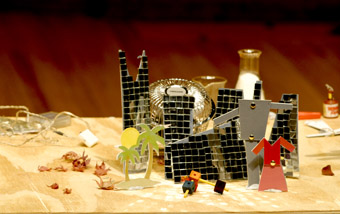
Set detail, Rosie Dennis, Fraudulent Behaviour, Performance Space
photo by Heidrun Löhr
Set detail, Rosie Dennis, Fraudulent Behaviour, Performance Space
But Fraudulent Behaviour goes beyond simply illustrating Nietzsche’s proposition that “we need lies in order to live”, which Dennis writes on her whiteboard. A makeshift snow-globe, flashing Hotel Tropicana sign and the duck’s fake flower lei are some of Dennis’ numerous kitsch references to the notion of Paradise. They suggest that our web of lies (large and small, to ourselves and others) constructs a false reality, an idyllic destination far more attractive than our inescapable, internal one.
In an interview in 2006, “Confessions of a fast talker,” Dennis described herself as “difficult to program” due to her falling between categorisations of dance and theatre, and the reluctance of arts organisations, especially in Australia, to schedule short works. The idea of producing longer, 45-60 minute performances was an issue of creative integrity: “I don’t want to do that, I want to be true to what I enjoy,” she explained.
It seems fitting then, that a work about our relationship to truth asks if Dennis is still being true to herself by making it. Of course, what Fraudulent Behaviour serves to illustrate is that we need lies in order to live, because truth is subject to change. Only lies are reliable.
confessions of a fast talker
keith gallasch talks with improviser rosie dennis
anamorphic srchive: the rosie dennis file
martin del amo
rosie dennis: one from the heart
winnie love
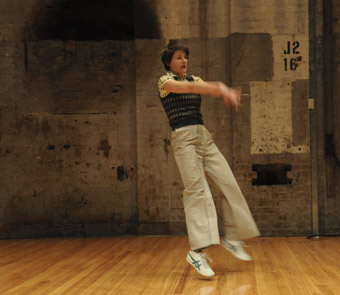
Rosie Dennis, Fraudulent Behaviour, Performance Space
photo by Heidrun Löhr
Rosie Dennis, Fraudulent Behaviour, Performance Space
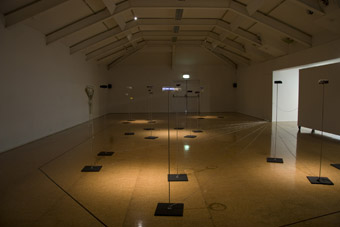
Collars, Alexandra Gillespie & Somaya Langley
photo courtesy of the artists
Collars, Alexandra Gillespie & Somaya Langley
BILL BRYSON ONCE DESCRIBED CANBERRA AS “A CITY HIDING IN A PARK”; A PITHY EXPRESSION OF THE QUIET, DISPERSED FEEL OF OUR NATION’S CAPITAL. IT’S NOT AN ABSENCE, THOUGH; LIKE BRYSON SAYS, IT’S A SENSE OF CONCEALMENT, OF UNSEEN LAYERS.
The Collars of Alexandra Gillespie and Somaya Langley’s installation stand in clusters in dimmed exhibition space. Each collar is a found object, collected from the artists’ friends and families, then detached and installed at the height of each owner; so as we enter the exhibition space we sense a crowd of absent bodies, grouped into little social clusters. Framed this way, the power of the collar to confer and express identity is inescapable; these swatches of fabric expand in our imagination into whole characters. Another layer: inside each collar, a single electroluminescent word glows, on and off; the word is keyed into spoken text, from the collar’s owner, dispersed in an immersive soundtrack.
The work is beautifully poised between intimacy and abstraction; between warm, sociable glimpses of the collars’ owners, and the formal control of the minimal stands, the cool glow of the texts. The sound field and the hovering collars give the work a heightened sense of spatial depth and interrelation; a network aesethetic, but one that is also absolutely material, made of wire and fabric, punctuated by the solenoid clicks of the switching circuits. As our personal interactions become increasingly abstracted and digitally compressed, we need more social machines like this, sourced from right next to our skin, evoking layers of our experience that don’t fit into a status update.
As its title suggests, Chris Fortescue’s LiminalTransitions dwells in a similarly poised threshhold space: between randomness and order, information and noise, foreground and background, intention and accident. In the Naturalism08 series Fortescue scans scraps of newsprint and packaging, then passes the source material through a set of geometric rotations and reflections. Structure inevitably emerges from these abject, crumpled things; what started as meaningless form acquires a sense of organic integrity. The results are visually seductive but suggest an ambivalence about form, structure, even beauty; if it is just junk with a dash of symmetry, where does this leave us?
Fortescue channels Duchamp in several works here; his Rectified Searches are low-fi digital images sourced from web searches for “Road”, “Fog”, and “Chris.” Duchamp’s “rectified” works are found objects subjected to a slight intervention or manipulation—L.H.O.O.Q, a cheap print of the Mona Lisa with a pencilled-on moustache, is the best-known example. Fortescue digitally rectifies his modern readymades—extrusions from the networked collective consciousness—decimating the face of each Chris into a pixel grid, slicing and transposing discs from the Roads. These minimal interventions throw the found images off balance, leaving the viewer suspended in their sense of hybrid, decentered agency.
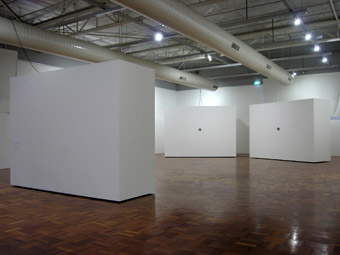
Liminal Transitions, Chris Fortescue
photo courtesy of the artist
Liminal Transitions, Chris Fortescue
Fortescue’s Resettings is his most successful manifestation of this networked or distributed authorship. Here he works with, and between, Michael Heiser’s land art work Double Negative, and Polish artist Edward Krasinsky, whose installations and exhibitions were often bisected by a horizontal line marked in bright blue tape. In Resettings Fortescue has wrapped rocks from the site of Double Negative in metres and metres of Krasinsky-blue tape. The resulting objects are intense sculptural forms in themselves: taut, shiny little capsules of…what? In the accompanying essay the artist teases out the network of resonances, coincidences and nodal events that unfold from the work; it becomes an expansive meditation on the mingled, tangled causalities of being in the world, against the simple-minded fiction of intention.
airConResonator literally hovers over the ANU School of Art exhibition space: it appropriates the air conditioning ducts that span the ceiling, miking them up and feeding their background noise through a filter, then piping it back into the room. Visually the work is barely there: two white walls—in fact giant resonators—each with a single, shiny speaker cone embedded. Even sonically the amplified air con is a diaphonous pillow of sensation, apparent only on close listening. The work tunes us in to the edges of aural perception, pushing the background forward just enough so that, suddenly, we hear it everywhere. Like the crumpled chip packets in the Naturalism prints, air con noise is waste, chaos; but acoustically, noise contains everything, all frequencies, all possibilities, all structure. And the ducts are physical resonators that double as readymade metaphor; a networked distribution system but also, as in Terry Gilliam’s Brazil, a secret, hidden world, where everything is connected. Very Canberra, really.
Alexandra Gillespie and Somaya Langley, Collars, Canberra Contemporary Art Space, March 26-May 2; Chris Fortescue, Liminal Transitions, ANU School of Art Gallery, Canberra, Jan 28-Feb 6
RealTime issue #91 June-July 2009 pg. 30
© Mitchell Whitelaw; for permission to reproduce apply to realtime@realtimearts.net
WHEN ASKED HOW SHE KNEW GOOD ART, GERTRUDE STEIN REPORTEDLY RETORTED, ”IT MAKES ME ITCH.” HOW DO WE JUDGE GOOD ART—ESPECIALLY GOOD MEDIA ART WHEN THE FIELD IS STILL RELATIVELY NEW AND OUR AUSTRALIAN SECTOR OPERATES AT A DISTANCE FROM THE GLOBAL HUBS OF MEDIA ART PRODUCTION? OUR UNIQUE AUSTRALIAN SENSIBILITY, CONCEPTUAL AND GEOGRAPHICAL DISTANCE CAN ALSO UNFORTUNATELY LEAD TO PAROCHIALISM.
Rather than relying on scratching an itch to identify outstanding work we most often employ a jury or peer review system to ensure fairness and adherence to high standards. In our modern legal system a jury is a sworn body of people convened to render a rational, impartial verdict, its members usually given time off from their daily life to deliberate. In the art world, judges, jurors, peers or assessors are expected to display impartial expertise across a large and encompassing discipline, and must fit often un- or underpaid jury work into already tight schedules.
How carefully is the jury process considered? Are there transparent criteria for selecting a winning artist, project or text? How much time are assessors given to review projects? How appropriately are they paid? Does the process become one of self-enhancement that awards the most personally charming entrant; the most politically opportune artwork; or the candidate who fits best the current institutional profile rather than setting any visionary precedent? Are the technically compliant outcomes of award, residency and prize deliberations always ethical or fair?
the process
Having made the transition from applicant to juror over the past five years, I have found myself sitting in judgment in 30 or so situations ranging from the heavy responsibility of the singular juror to negotiating unwieldly email discussions amongst 20. These have included net art commissions for Rhizome and Turbulence in New York; international symposiums and exhibitions such as several ISEA and Futuresonic Festivals; assessments for ANAT, AFC and the Australia Council for the Arts; art and industry prizes like SmartyBlog, AIMIA and the Queensland Premier’s Award for New Media Art; and, recently, assessing 320 entrants over five days on the five-person Hybrid Arts Jury at Ars Electronica in Austria.
Most challenging was the day-long Second Life Architecture Award “Open Jury” meeting of seven jurors of diverse backgrounds held during the Ars Electronica Festival in 2007. A live audience filled the jury hall—some being entrants in the award. Proceedings were netcast, in real time, to a public square in Second Life where the avatars of global entrants and a general audience also gathered. Our singular jury avatar, resplendent in a pink and green Chanel suit, explored each short-listed project in-world as audience avatars looked on. This online process was simultaneously screened back into the jury room. Inside a constant feedback loop, with no ‘cone of silence’, every word and gesture of the jury was publicly, globally accountable, including the repeated proclamations of an internationally respected senior architect (with no virtual world experience) of “It’s all rubbish!” Five outstanding finalists were eventually selected and we adjourned for beer and schnitzel.
Jury duty is hard, hard work. Academic assessments and online peer reviews are far less charged, as automated forms, comment boxes and rating systems are designed to ensure emotional detachment. However nothing can compare with the personal interaction and vigorous debate that characterises an art jury. It can assume the mantle of a courtroom drama of the Boston Legal kind, with otherwise sane and rational individuals displaying ruthless strategies, pathos and absurdity. Over hours or weeks, bizarre behaviour can emerge as individuals grapple to make decisions. And these decisions are not taken lightly as the outcomes will set agendas for a sector, promote and reward certain artists and artforms.
the people
Permit me to make some observations on the personalities engaged and tactics employed, to a greater or lesser extent, in these grand deliberations.
The Player: Having watched the movie Rainman they know it’s all a numbers game. Their strategy is to rate their favoured artist at around 85-100%, while rating the other strong contenders, or those who seem to be favoured by other jurors, in the bottom 15 %. A shrewder variant of the Player will subtly trade with others for ranking, forfeiting some favourite projects to ensure the elevation of others.
The Persuader: They sit up late in bars bending the ears of other jurors; send prolific emails extolling the virtues of a project; and bring complimentary articles on it to other jurors’ attention. Their lengthy implorings, peppered with rational and emotional hooks, seldom ensure a winning choice.
The Tantrum Thrower: They walk around muttering angrily, or indeed sometimes shouting unabashedly that noone else understands the criteria, the sector, the audience, the projects. They threaten to walk out, talk to the press, issue a dissenting statement. Some tantrum throwers take it further than this, later publishing disparaging articles on the jury process, questioning the character and suitability of the other jurors.
The Dictator: They are often corporate, museum or festival directors without specific knowledge of the arena being juried or, alternately, a highly distinguished and fiercely opinionated veteran jury chair. They truly believe they know best, blocking opinions and discussion in favour of the quick decision. Equally destructive is the politically appointed juror who demonstrates complete disengagement—sometimes falling asleep during deliberations. Strong coffee and dark chocolate should be mandatory assessment refreshments.
The Consensus Seeker: The world would be perfect if everyone agreed, and this juror wants the process to be a shared, harmonious experience. Except, rarely does everyone totally agree. The decision must be made, the announcement has to go out, the publicity department is waiting for copy, but the consensus seeker is undeterred. To them the process is more important than the outcome. Eternal optimism as a redeeming quality is either endlessly infuriating or infectiously refreshing.
the prize
Hopefully sharing the elation of reaching a satisfying consensus—when all are at a point of emotional and physical exhaustion—it’s time to go public. The statements are written, the jury gird their collective loins and, no matter what, smile. At the Announcement, the winner(s) feel deservedly rewarded or are stunned. Those without a prize generously congratulate the winners, and the gossip and rumours start. Everyone is a critic after the fact and of course would have made a better decision. The Art Dealer is the happiest person in the room, grinning from ear to ear, as the profile of their artist instantly soars with this new accolade and its public recognition, financial reward, possible acquisition and career acceleration.
solutions
And there we have it. If we want to award work that really makes us itch, that poses provocative questions, coalesces bodies of knowledge and delivers an accessible and engaging audience experience, then jury selection and the jury process are crucial. But do we want important assessments to be made in airport lounges between flights by exhausted experts? Providing appropriate remuneration and sufficient time to deliberate on all aspects of the works in competition underpins the construction of a vibrant media arts sector.
My vision for our future has Gertrude scratching wildly—immersed in the exteroceptive delights of sight, taste, smell, touch, hearing and balance; revelling in kinaesthetic satisfaction; and savouring her intellectual engagement with the new modalities and emergent practices of media arts.
RealTime issue #91 June-July 2009 pg. 30
© Melinda Rackham; for permission to reproduce apply to realtime@realtimearts.net
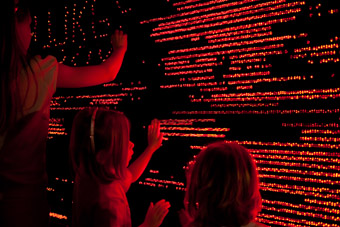
L–E–D–LED–L–ED, dilight inc. (Japan), 2007, Ars Electronica Centre
photo Alex Davies
L–E–D–LED–L–ED, dilight inc. (Japan), 2007, Ars Electronica Centre
IT IS HARD NOT TO FEEL DAUNTED BY YOUR FIRST SIGHTING OF LINZ’S SPARKLING NEW ARS ELECTRONICA CENTER. IF YOU SEE IT FIRST AT NIGHT (IT’S IMPOSSIBLE TO MISS), THE COLOURED LIGHTS OF ITS FLASHING FACADE SHOUT ITS SIGNIFICANCE ACROSS THE DANUBE TO THIS SMALL AUSTRIAN CITY AND ITS DETERMINATION TO EXHIBIT THE FUTURE. ONCE INSIDE, HOWEVER, THE MUSEUM IS ENTIRELY MANAGEABLE. THE QUIRKY TURNSTILES AT THE ENTRANCE SET A LIGHT-HEARTED TONE, DEFLATING TO LET YOU PASS AFTER SCANNING YOUR TICKET.
The basement is arranged into a set of public ‘labs’ staffed by enthusiastic young assistants in orange uniforms who are eager to explain and demonstrate the exhibits, while simultaneously preventing any robot injuries or deaths. The Robolab is a lively buzz of human and machine voices, by far the most popular part of the museum and home to a very decent population of working prototypes, including Hexpod who plays soccer, Plenpark who dances, and Merz who sulks when you don’t pay her enough attention. Some may complain that this is a surface representation of robot genealogy, but a comprehensive survey of such a field would be difficult in any single space.
The highlights are The Haptic Radar which, when worn, allows you to navigate the space of the museum by responding to a series of rather unpleasant pulses to the perimeter of your head, and Philip Beesley’s elegant Hylozoic Soil, a huge mechatronic organism whose tentacles react as you approach them.
The Biolab tries hard to set a scientific atmosphere: white lab coats hang on the wall, and Petri dishes and test tubes fill the shelves. But all that is here is a disappointing set of light and electron microscopes, an exhibition of cloned tobacco plants and a DNA scanning station, all of which might be interesting if they were available for use, but seem like part of a technology trade show than anything to do with electronic arts.
The Fablab is another technology showcase, housing a remarkable 3D printer and Airdrawn, a three-dimensional design interface. However, with the help of assistants, you are invited to experiment with them. This is where it all gets very Questacon, and of course, kids love it.
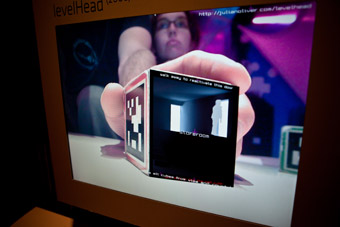
LevelHead, Julian Oliver, Ars Electronica
photo Alex Davies
LevelHead, Julian Oliver, Ars Electronica
The Funky Pixels area, also in the basement, needs some devoted time. Offering a tranquil antidote to the science labs, the “shoes optional” lounge area has modular cushions, street art décor, and mood lighting. You can just sit around, playing with a range of experiments in interactivity. Although it is not perfectly installed, Julian Oliver’s Levelhead is as well-loved as ever, judging by how worn the cubes of the interface are. If you are patient enough, you can navigate through the elegant levels of his Escher-like labyrinth.
From the basement, I make my way up to the Deep Space theatre, which has a show on rotation every hour or so. This exhibit presumably replaces The Cave in the old AEC, famous as a pioneering VR environment for commissioned projects. Entering the theatre, we are handed 3D glasses and deep house music plays as we find positions. But the shows are uninspiring. Papyrate’s Island, an interactive 3D game could be great to experience if you could control and navigate the space. As a demonstration, however, it is more disorienting than fascinating.
The presentation of Leonardo da Vinci’s The Last Supper preserved as 16,118,035,591 pixels seems to be merely a way of using eight high definition projectors. Is this better than seeing the painting itself? Such unprecedented level of detail may be technically impressive, but adds no magic to da Vinci’s vision, even with the operatic soundtrack. There are other films on, but most of them leave you feeling you’re in an inferior Imax theatre with no seats (or popcorn). One can only hope that Deep Space will be used more creatively in the future.
One floor up is a retrospective of the work of Berlin design lab ART+COM. Installed on shipping crates and wooden palettes, the focus here is interdisciplinary experimentation: structural models, prototypes and documentation of new media research projects. The refreshing aspect of this floor is that, as a model for documenting projects, it acknowledges process and temporality and could have more works added at any time.
Poetry of Movement is by far the most impressive space in the center. It is packed with simple, elegant ideas that are well executed and don’t try to be anything other than good art. One corridor provides quality documentation of a number of winners of the prestigious Prix Ars Electronica, such as Dutch artist Theo Jansen’s lumbering, wind-powered, computer-designed skeletons, Strand Beasts. Another room is devoted to the marvellous robotic musical instrument Quartet by Jeff Lieberman and Dan Paluska, where 35 wine glasses make up the organ and 250,000 rubber balls fire at the marimba keys to perform a composition composed by a computer program from user input through a keyboard.
Arthur Ganson gets a whole room, which I was happy about even if it seems a little unbalanced. His Machine With Concrete is glorious, reminding us, in the midst of all the experimentation with cutting edge technology, that the world actually changes very, very slowly. The motor drives a series of gears and cogs, the last of which is fixed to a concrete block. The first rotation (in 1992) took about 14 seconds; the last one will take two trillion years.
This floor demonstrates that, in electronic arts, the kooky and low-fi can sit (if not comfortably, at least provocatively) next to the technologically seamless, and of the important aesthetic intersections of sound, kinetics and robotics.
Beyond being a museum, the Center is the permanent base for the Ars Electronica Festival. It is also home to Futurelab, a media art laboratory in which artists and scientists collaborate on the future, engineering exhibitions, designing installations and pursuing joint research ventures with universities and the private sector. This year’s festival (September 3-8) and the ongoing activities of Futurelab will be a test of the curatorial resilience of the new structure.
The Ars Electronica Center is indeed a landmark for the electronic arts, and for Linz itself, fortunately one that will live beyond the branding of the city as the 2009 European Capital of Culture. Like its predecessor, this museum is unique in the world as a showcase of the novel intersections of art and science. Some cynical Linz residents, however, call the center the “media arts brothel”—its curtain of lights are apparently very similar in hue and form, if not in scale, to a well-known red-light strip. With the hype of its opening in January and its slick presentation, the Ars Electronica Center begs the question, can the future be anything but overstated?
Ars Electronica Center, Linz, Austria, www.aec.at/center
RealTime issue #91 June-July 2009 pg. 31
© Alexandra Crosby; for permission to reproduce apply to realtime@realtimearts.net
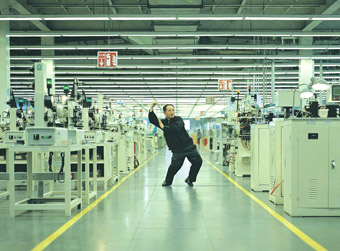
My Future is Not a Dream 01-08, 2006, Cao Fei
courtesy the artist and Lombard-Freid Projects
My Future is Not a Dream 01-08, 2006, Cao Fei
2009 SAW SOME REVISIONS TO THE ANNE LANDA AWARD EXHIBITION, ESTABLISHED IN 2004 AND NOW IN ITS THIRD INCARNATION: IT WAS THEMATISED (AROUND THE IDEA OF DOUBLES AND SPLIT IDENTITIES), IT WAS NO LONGER CURATED IN-HOUSE (GUEST CURATOR VICTORIA LYNN), BUT MORE SIGNIFICANTLY, IT WAS NO LONGER LIMITED TO AUSTRALIAN ARTISTS.
This may ultimately prove a positive move, providing more opportunities to view high quality video and ‘new’ media from around the world, and in general raising the bar and the profile of the exhibition. This year, however, the new format resulted in the work of local artists being overshadowed by the reach, ambition and emotional punch of their international counterparts’ projects.
Take Whose Utopia? (2006), Cao Fei’s elegiac three-part video of factory life in China. The first part is an aesthetic paean to the processes of mass manufacture, with close-ups of seamless human/machine interaction that serves as a curious rebuttal to the industrial anomie and terminal mistiming comically captured in Chaplin’s Modern Times. But it is the second part that really captivates, as the workers of the first part emerge from anonymity as complex individuals enacting their fantasies amid the factory hardware. The workers dream of tutus and angel wings, electric guitars and graceful choreography, of deploying the fine motor skills required to sort light-bulb filaments instead to emulate the delicate gestures of a dying swan. The fantasies are not the stereotypical Western blue-collar dreams of wealth and status, love and sex. Rather the workers crave creative expression; their idealised figure is none other than ‘the artist’, specifically the performing artist.
The figure of the performing artist is also the focus of fantasy for the young Indonesian Smiths fans who answered Phil Collins’ call to participate in the third chapter of his globe-trotting The World Won’t Listen (2004-7), a video that documents karaoke versions of the British band’s classic album of 1986. I was initially skeptical of Collins’ project. The artist claims his gambit would not have worked if staged in “the first world circuits of pop and cultural industries” because he aimed to explore the reception of pop in places where it may have seemed as much “an imposition as a gift” (Collins cited in Catherine Fowler’s essay in Anne Landa catalogue, AGNSW, 2009). Yet I suspect the chosen settings of Guatemala, Turkey and Indonesia had more to do with the enduring allure of the exotic to the Western eye, and the promise of the simultaneously poignant and absurd slippages that can occur when a first world cultural form is appropriated by the geo-politically marginalized. And yet, the video manages to transcend its problematic politics through the utter conviction of the performers, some of whom emerge from their reverie as if from spiritual possession, physically trembling. Rather than evoking cultural ventriloquism, these devastatingly beautiful anthems of class and teenage alienation appear to belong to these singers. As they sing “Hang the blessed DJ, because the music that they constantly play, has nothing to say about my life” (from the song Panic), the cross-cultural implications may be complex, but the lyrics ring with Morrissey’s original meaning.
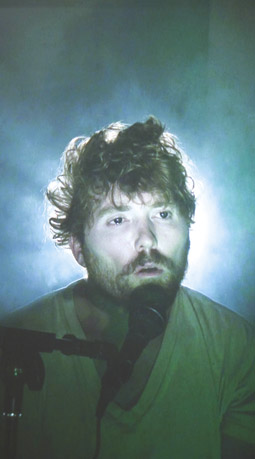
Nina, Me and Ricky Jay 2009, TV Moore, VHS & DVD transferred to DVD
courtesy the artist
Nina, Me and Ricky Jay 2009, TV Moore, VHS & DVD transferred to DVD
Music’s transformative power also subtends TV Moore’s award winning entry, a loose amalgam of sculptural installations—including a mirror ball, a TV/stereo cabinet and cymbals suspended from the ceiling—and videos on various screens that include the artist singing under hypnosis. This unedited evocation of the artist’s artificially induced altered states, with its at times ham-fisted symbolism and overloaded imagery, lacks the resonance and conceptual refinement of Moore’s earlier videos. While maximalism may have cost Moore, at the other end of the spectrum, the intuitive communication between twins is not enough to redeem the Mangano sisters’ video, Absence of Innocence (2008) from a certain lack of content.
Mari Velonaki’s Circle D: Fragile Balances, 2008, Circle E: Fragile Balance 2009, an attempt to challenge our expectations of what makes for a robot and a computer interface, through the design of blue-tooth enabled hand-held boxes that ‘write’ messages to each other, was compelling, but still in need of some development. In particular it would be fascinating to see a real time connection between messages scrawled by visitors and the screens on the boxes.
Finally, Lisa Reihana’s Digital Marae (2001 and 2007) offered a witty updating of the Maori ancestral meeting house. The artist replaced traditional elders with life-sized digital prints of ordinary Maori men, in the guise of figures from Maori legend, and traditional hand-crafted motifs with computer-generated animated patterns (Tukutuku: Terrain, 2009). The work has great aesthetic power, although its installation along the exhibition space’s external wall detracted from its intensity.
While Double Take may not shed much additional light on the experience of multiple personalities and split identities, through the works of Collins, Reihana and Cao Fei, in particular, it speaks poignantly about the intrinsic human need for creative expression. These works derive their power in large part from the artists deploying their own artistic agency to nurture that of the ostensibly dispossessed.
Double Take: Anne Landa Award for Video and New Media Art, artists Phil Collins, Cao Fei, Gabriella Mangano, Silvana Mangano, TV Moore, Lisa Reihana, Mari Velonaki, guest curator Victoria Lynn, Art Gallery of New South Wales, May 7-July 19
RealTime issue #91 June-July 2009 pg. 32
© Jacqueline Millner; for permission to reproduce apply to realtime@realtimearts.net
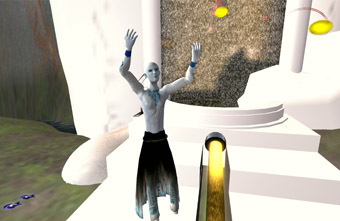
Mellifera, Trish Adams, Andrew Burrell
MELLIFERA’S LAUNCH HAS TO BE THE ONLY OCCASION THAT AN EXHIBITION HAS BEEN OPENED BY RELEASING BEES IN A CROWDED ROOM. WELL, ALMOST BEES. CREATORS TRISH ADAMS AND ANDREW BURRELL CALL THE VIRTUAL LIFEFORMS THEY HAVE CREATED “MELLIFERA”, AFTER APIS MELLIFERA, THE EUROPEAN HONEY BEE, BUT THE CREATURES THEMSELVES SHARE AT MOST A FAMILY RESEMBLANCE WITH THEIR PHYSICAL COUSINS. THEY ARE, IN FACT, JUST ONE SPECIES IN THE SYNTHETIC ECOSYSTEM OF TERRA.MELLIFERA SET UP BY THE ARTISTS IN THE MULTI-USER ONLINE WORLD, SECOND LIFE.
The gallery walls are taken up with projections of what appears to be CCTV surveillance footage; but the terrain the cameras survey is from anywhere but the gallery surrounds. The valley outside is enclosed by precipitous cliffs and filled with strange polygonal flora in various states of growth and decay. A silent humanoid avatar flounces its antennae as it tends to the swarm of varicoloured insects the size of a human head. Across the gallery, a computer terminal invites you to pilot your own avatar through the imaginary valley. If you come hearing only of the bee-connection this is both more garish and more immersive than the average ecological simulation. In my email interview with them, the artists are quick to differentiate their work, as synthesisers of life, from the attempt to replicate the real:
Mellifera: “What we are creating is not a simulation but a space in its own right that has its own logic, in part inspired by some physical world ecosystems and the behaviour of Apis Mellifera… but is also very much its own space. A ‘simulation’ is replicating something else. This is something else.”
Be that as it may, the project claims multiple points of engagement with the physical honey bee. Firstly, the artists have researched “cognition, navigation and communications in the honey bee” at the Queensland Brain Institute, and mention it as an inspiration for the behaviour of their simulacra. More overt is the contemporary theme of ecological fragility evoked by bees, who are notoriously threatened worldwide.
It’s not apparent in the show at the gaffa gallery, but disaster looms for the mellifera as well. In the artists’ words: “The actual ‘terra mellifera’ in Second Life appears at first to be a pastoral paradise…however, whilst some [simulation states] will have an Elysian theme, others will involve dangerous invasions of pests which our virtual honeybees…will be unable to resist without the attention of ecologically aware avatars.” The artists, it seems, intend to subject their creatures to something analogous to the blight afflicting their real kindred.
Terra.mellifera is far from the first ecosystem in Second Life—and even bees seem to be common, occurring in two of the higher profile ones. Laukosargas Svarog’s famed Svarga’s simulation and Luciftias Neurocam’s Terminus have toyed with them. What’s different here (aside from an unspecified arsenal of gizmos and doohickeys which the artists hope to deploy in the later Brisbane show) is narrative. I’m reminded of Mitchell Whitelaw’s consideration of “critical generative systems”, and the implicit potential in these generative simulations to communicate “system stories” that explore possible worlds, systems whose underlying construction can create alternative perspectives on physical reality (“System Stories and Model Worlds: A Critical Approach to Generative Art” in Olga Goriunova ed, Readme 100: Temporary Software Art Factory, Norderstedt: BoD, Dec 2005, http://creative.canberra.edu.au/mitchell/papers/).
For Burrell and Adams, indeed, narrative and exploration are both critical. They are happy to disclose that their simulation is based largely around the venerable artificial life technique of agent-based modelling, that it contains birth, feeding and death and so on. But they are coy about the detail of the emergent foodweb, even to RealTime; that, they wish to leave to the experience of the visitor, at least for now. There is, apparently, a synthetic nature documentary in progress for the end of the project.
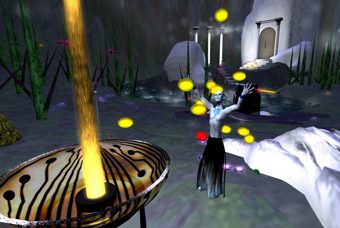
Mellifera, Trish Adams, Andrew Burrell
For now, the tribulations, and the gradual evolution and curation of the algorithms and interrelations of the mellifera are only visible to those spectators to the virtual component of the show, the denizens of Second Life. And it’s not just invasive pests, but the progress of the artwork itself: “As we introduce further code/behaviour/elements to the system, balance is lost, and sometimes it can take quite a while for equilibrium to return. Tiny changes to one piece of code can and do affect the whole system.” The experience of Mellifera, then, approximates a real eco-tourism project in a bona fide ecosystem, with all the responsibility and uncertainty that implies. This critical generative system explores the transience and delicacy of living systems—a noble sentiment.
My major qualm about the work is with the choice of medium of Second Life itself—if we can extract a detailed experience of the fragility of living systems from such a simulation, it is a lopsided fragility in that we are excluded. Second Life invites us to participate intimately as virtual avatars, and that participation is asymmetric; second-life avatars are solipsistically prime in the simulated world. These immortal, self-contained souls can create a balance of synthetic “nature” but cannot themselves be destroyed by it. Whereas the demise of the bees in reality seems likely to cost real human lives as our crops lose a key pollenating process. For us, the bees’ value is, tragically, far more than purely aesthetic, and organising to save the arbitrary danger to an artwork in the stead of a real ecosystem is quixotic.
The destinies of both real and virtual bees, however, and the artists’ handling of these difficulties, are all similarly undecided, and I recommend checking in on the progress of each. Terra.mellifera is ongoing in Second Life and will re-open in real life in Brisbane in August 2009 at The Block, QUT. Bee extinctions are continuing worldwide.
See also RT 84, p32, www.realtimearts.net/article/issue84/8951; and RT 87, p36; www.realtimearts.net/article/87/9181
Mellifera, artists Trish Adams, Andrew Burrell, gaffa gallery, Surry Hills, Sydney, April 16-21; The Block, August, QUT, Brisbane, http://mellifera.cc/
RealTime issue #91 June-July 2009 pg. 33
© Dan MacKinlay; for permission to reproduce apply to realtime@realtimearts.net
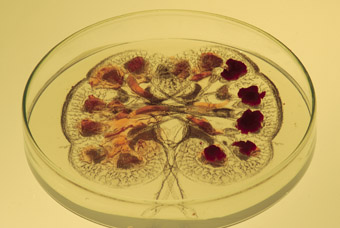
Niki Sperou, Man a Plant, giclee print (installation detail) Flinders Medical Centre, glass, plant, tissue culture, gel nutrient medium, drawing (2007)
IN HIS CATALOGUE ESSAY FOR BIOTECH ART REVISITED, MELENTIE PANDALOVSKI ASKS IF THE ASSIMILATION OF SCIENCE AND TECHNOLOGY HAS BECOME PART OF THE MENTAL EXPERIENCES OF THE GENERAL PUBLIC. THE DISTRIBUTION OF EXPLANATORY NOTES IN THE EXHIBITION SUGGESTS THAT THIS NEW FORM, BIOTECH ART, CANNOT YET BE UNDERSTOOD WITHOUT ASSISTANCE. THE ARTWORKS IN THE EXHIBITION ARE QUESTIONING: SIFTING THROUGH BODILY INTERACTIONS AT THE MICROSCOPIC LEVEL. ONLY ONE OF THE EIGHT WORKS (FOAM BY MAJA KUZMANOVIC AND NIK GAFFNEY) DOES NOT ENGAGE IN THE DISCOURSE ABOUT MINUTE CELLULAR ACTIVITY.
In NoArk I and II, Oron Catts and Ionat Zurr of the Tissue Culture and Art Project explore the taxonomical crisis that arises for life forms created through biotechnology. The work consists of two glass cases lit in dark red and blue. The first contains a boat/bag of mixed cells, the apparatus continuously rocking to keep them alive. The second contains, in order, taxidermied pig, rabbit, rat, mouse, crow, finch, fish, crustacean, mollusc, leech and a two-headed bird. These function as a Noah’s Ark-like collection of an evolutionary food chain, apart from the aberration of the two-headed bird, which acts as a kind of full stop. The juxtaposition of the objects in the two cases suggests that the suspended mass of cells in the first is a kind of scientifically created primordial soup that cannot be differentiated and thus classified.
The notion of the undifferentiated is also found in Niki Sperou’s Man a Plant. Sperou continues her interest in chimera in this work with an exploration of a 1747 text, Man, a Machine, which stresses the similarities between humans and plants. Plants have the ability to rejuvenate themselves and humans are rapidly gaining this ability through research into the potential for stem cells to repair damaged human tissue. Sperou presents five Petri dishes each containing an anatomical drawing that has its plant-like aspects highlighted with growths of grape cells and nutrient gel medium. Each dish has condensation spots, which partially obscure our view of the contents, attesting to the blurring of life at the cellular level.
Andre Brodyk’s installation, Proto-animate19, also deploys the science of the Petri dish. The biohazard sign at the entrance to the installation highlights the artist’s use of e-coli in growing ‘junk’ or non-coding DNA. Interacting with this installation without consulting the accompanying notes can induce discomfort, even fear. The room is peppered with biohazard containers. Children’s chairs, clustered in the centre of the room, each contain a Petri dish growing a face. At first glance this is quite horrifying, lending a sinister aspect to the room. What has happened here? This reaction belies the subtlety of Brodyk’s work. The portraits of ‘John Does’ are grown from DNA not active in biological production, specifically the proteins associated with Alzheimer’s disease. These comprise a complex meditation on identity and the nature of bodies in this biotech era.
Bio Kino explore the exotic/erotics of the body on scientific display, by referencing early scientific film, particularly the work of Dr Eugene L Doyen, who toured his 1902 film of the surgical separation of conjoined twins in side-shows as a curiosity and an “educational tool.” Bio Kino have miniaturised digital film to 500 microns, about half a millimetre, and projected them onto living cells. This living screen reacts and deteriorates, distorting the images. The resulting Striptease of the Siamese is a strangely erotic film of conjoined twins revelling in their dance together. The process by which the work has been made is just as disturbing and fascinating as the subject matter.
Changing Fates_matrilineal is constructed by an equally fascinating process. Trish Adams cultured adult stem cells from her own blood and used a chemical formula to change them into cardiac cells. The cardiac cells then clustered and began to beat. The DVD of this work contains images of these cells intertwined with the writing and photographs of the artist’s grandmother, accompanied by a sound track of breathing, soft whistling and a heart beating. In the explanatory notes the artist discusses the intertwining of the emotional and the biological, and the ephemeral nature of life. Equally the work suggests cellular sentience and it is hard not to attribute some kind of feeling to the heart cells beating together and a kind of sadness for their limited lives.
On entering Nanoessence, a collaboration between Paul Thomas and Kevin Raxworthy, you are instructed to breathe onto the model of a skin cell which is then projected onto a wall. The minute changes that the breath produces register on an airy landscape. The sign asking the viewer to interface with the work concludes with “Do not touch”, immediately bringing to mind questions of what touch is, body boundaries and how much of the body spreads into the atmosphere in the act of breathing. The world is, after all, littered with dead skin cells. The artists question the ocular-centric world of scientific research through seeking to collect data through touch, involving a fuzzy logic of shifting boundaries and not always containable movement.
Micro ‘be’ Fermented Fashion by Gary Cass and Donna Franklin and BioHome: The Chromosome Knitting Project by Catherine Fargher are perhaps the least subtle and most overtly confronting works of the exhibition. Cass and Franklin developed living garments using the cotton-like cells that are a by-product of the fermentation of wine to vinegar. The resulting clothes are dark red, wet and clotted looking. They function as a kind of bloody second skin on the bodies of the models. One photograph shows gruesome drips seeping down the back of the model. Playing with the world of fashion and the cult of youth this work introduces clothing that will age with you. As the accompanying text proclaims, a future which includes the monstrous will be found attractive by some, and not by others.
The soothing advertising-styled voice of the DVD of BioHomes: The Chromosome Knitting Project (Catherine Fargher, Terumi Narushima) offers a welcome that dominates the entire gallery. Its utopian, sci-fi tones, promising a brave new world, at first distract from the more complex, intricate works in the exhibition. The installation focuses on intensifying viewer discomfort about biotech products in the home. Unease is amplified by uncertainty; signs suggest viewer interaction: What am I touching? Breathing? As with Brodyk’s installation, Proto-animate19, the shock value of this installation obscures some of its subtleties. But curator Melentie Pandalovski highlights the importance of a visceral response to biotech arts and the physical unease triggered by BioHomes is testament to this.
Andre Brodyk writes of space being activated by different viewers as they enter into it, temporarily combining and recombining with other spatial elements. This Deleuzian notion is active in Biotech Arts Revisited as viewers become increasingly aware of their bodies, internally and externally. The visceral discomfort and fascination produced by the exhibition’s focus on the microscopic and the cellular is evidence of the continual revisions inherent in our relationship with our own and others’ bodies, as borders shift with each new technological and scientific development. The subtler aesthetic experiences of the works in Biotech Art Revisited suggests that the experience does not always have to be ugly.
Biotech Art Revisited, curator Melentie Pandalovski, Experimental Art Foundation, Adelaide, April 9-May 2, www.eaf.asn.au/2009/biotech09.html
RealTime issue #91 June-July 2009 pg. 34
© Kirsty Darlaston; for permission to reproduce apply to realtime@realtimearts.net
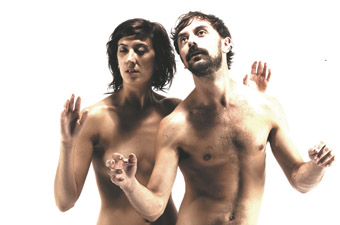
Brooke Stamp, Luke George, Miracle
photo Jeff Busby
Brooke Stamp, Luke George, Miracle
I LAST MET PHILLIP ADAMS, ARTISTIC DIRECTOR OF BALLETLAB, FOR REALTIME PRIOR TO THE PREMIERE OF HIS AXEMAN LULLABY MID-2008 (RT86, P32). AT THAT TIME, ADAMS WAS OPTIMISTIC ABOUT THE COMPANY AND ITS PLACE IN THE AUSTRALIAN DANCE LANDSCAPE. DESPITE THE CRITICAL SUCCESS OF THIS WORK (IT JUST WON A COUPLE OF GREEN ROOM AWARDS FOR CHOREOGRAPHY AND FOR COMPOSITION) AND A CONFIDENCE-BOOSTING SHOWCASE AT THE CINARS INTERNATIONAL ARTS MARKET IN LATE 2008, ADAMS HAS BEEN SOBERED BY FUNDING REVERSALS FOR HIS COMPANY.
This meeting is about Miracle, the new full evening dance production to premiere at Melbourne’s Meat Market in July. It is also about Amplification, the piece that launched BalletLab in 1999 and which will be restaged at the Australian Dance Awards, in June, at Melbourne’s Arts Centre.
These two presentations are gratifying for Adams, as they bookend a decade of vigorous experimentation with form and content. The early piece was an apocalyptic response to the violence of the 20th century as it came to its close. It featured a score and choreography so ferocious it made audiences and critics alike sit up and notice the new company. For Adams Miracle is a “sequel to Amplification.”
Miracle’s starting point is the search for transcendence which follows the car crash of Amplification. Adams sees contemporary humanity pursuing the miraculous in order to escape disillusionment with the material world. He finds his evidence in the current resurgence of religious fanaticism, cults and mass market spirituality.
A New York residency at EMPAC (Experimental Media and Performing Arts Centre, Rensselaer Polytechnic) gave Adams the opportunity to experiment with the clash of sound and choreography which he envisioned as creating the hallucinatory mood for the piece. He took four of his regular dancers—Luke George, Brooke Stamp, Clair Peters, Kyle Kremerskothen—as well as key collaborator and composer, David Chisholm, and new recruit, sound artist Myles Mumford, for a four week stay at this generously resourced arts centre [see RT 89, p24]. There Chisholm and Mumford recorded live sound from the dancers in rehearsal as well as a range of composed material with US instrumental group, ICE (International Contemporary Ensemble).
This material will form the body of the design for Miracle, as Adams dispenses with set and works with a very limited lighting palette by Paul Jackson. Adams is not au fait with the fine points of the technology the composers are using but he is confident that the experiments they undertook at EMPAC with “handheld amplifying megaphones and a surround sound speaker orchestra” will create the effect of “a triumphant onslaught of hysteria.” Adams says, ”My fascination with the epiphany is performed against repetitive mantra, phrase and hymn-like voices. It is an examination of false hopes and religious stereotypes that promise a new beginning.” Chisholm and Mumford will perform the electronic score live, modifying it subtly to each performance. Adams talks about a technological illusion of levitation created through the sound of one hundred harmonicas played by the dancers, amplified and looped to create an almost intolerable din, instigating a prolonged state of suspension like a universal pause.
This sense of repulsion is one that Adams also aims for in the choreography. He told me about an outdoor try-out in Hobart which was quickly shut down. Adams’ desire to, “choreograph the frantic spectacle of a real life miracle” was too much for his Tasmanian audience. The state of desperation achieved by his dancers running raggedly across the stage to the point of exhaustion was apparently beyond the pale. “I have situated the performers sometimes as heavenly bodies, sometimes from mythology and above all I am trying to remove [a sense of ordinary humanity] from the structure of the performance.”
For Adams, Miracle is another step in the direction of visual art performance installation. Despite his adherence to the proscenium and his engagement of key collaborators from the performing arts, Adams is most stimulated by the possibilities for BalletLab outside the theatrical context.
Miracle will be programmed as part of Melbourne’s State of Design Festival and Adams is proud to state that director Fleur Watson was very taken by the relationship between the production and the “Sampling the Future” theme of her festival. The fact that the costumes for Miracle will be designed by Melbourne fashion designer of the moment, Toni Maticevski, could also have played a role in her decision to include BalletLab as the sole performing arts company in the program.
This new presenting partnership is an example of Adams’ entrepreneurial zeal and faith in the role of BalletLab as provocateur to the contemporary dance status quo. Adams talks with rhetorical glibness about “new audiences, new programming formats and art-form innovation” as the markers of his 10-year-old company. He may be turned off by the reductive process of business planning which won him so little funding reward last year, but he has clearly found a strategic position for which he will fight.
In 2010 BalletLab will undertake “a structured studio exchange” with the Australian Ballet as part of the Australia Council’s Interconnections project. Adams says that for both organisations “the project forges a new creative relationship to investigate different types of choreography that redefine dance genres, whilst promoting resource sharing between the small to medium-sized and the major performing arts sectors. Our program is a platform for BalletLab to realise its ambition to implement the Lab component of the company. Our collaboration will invoke a transformative creative experience between a progressive language in contemporary dance and classical technique. This creative dialogue will also be reconfigured through artistic collaborative experimentation in design and music composition.”
The Australian Ballet partnership, a major commission for 2010 from the Museum of Old and New Art in Tasmania and the prospect of international touring for Brindabella (RT83, p43) and Miracle are all keeping Phillip Adams upbeat in downbeat times.
BalletLab, Miracle, Arts House Meat Market, Melbourne, July 15-19, www.balletlab.com; State of Design Festival, July 15-25,www.stateofdesign.com.au
RealTime issue #91 June-July 2009 pg. 36
© Sophie Travers; for permission to reproduce apply to realtime@realtimearts.net
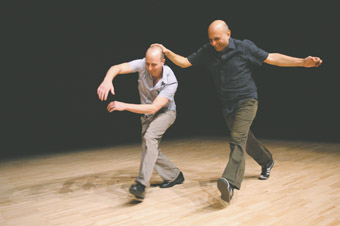
Jonathan Burrows and Matteo Fargion
photo Alastair Muir
Jonathan Burrows and Matteo Fargion
A GEOMETRICAL APPARATUS TAPERING OFF INTO BENCHES, SCREENS AND AN IMMACULATE LINE-UP OF ELECTRIC GUITARS IMMEDIATELY CONVEY A SENSE OF A LABORATORY SCRUBBED IN READINESS FOR THE NEXT EXPERIMENT. THERE IS EVEN SATISFACTION IMAGINING WHAT CHEMISTRY THOSE SHINY METAPHORICAL INSTRUMENTS MIGHT CHARGE INTO THE THEATRICAL SPACE. BY CONTRAST, TWO WOODEN CHAIRS PLACED IN PICA’S UNADORNED BLACK BOX PROMISE LITTLE OTHER THAN A CONVERSATION. WHAT TRANSPIRES IN THOSE TWO DISPARATE SETTINGS THROWS CONCEPTS OF SCIENTIFIC EXPERIMENTATION INTO DISARRAY AND SCORES ANOTHER POINT FOR THE POTENCY OF UNPREDICTABLE SIMPLICITY.
There is no direct correspondence between Buzz Dance Theatre’s Depth Charge and Strut Dance’s presentation of Jonathan Burrows and Matteo Fargion’s The Trilogy, other than being two dance productions which surfaced in the same time-frame and yet their coincidence raises questions about performance and transformation. Whereas Depth Charge announces itself with a bionic forearm, imaging “a future where dance ensembles are genetically engineered”, The Trilogy relies on its UK origins, a few phrases from ‘spellbound’ critics and, for a select group of aficionados, anticipation of an actual encounter with two men who have honed choreographic formalities down to two sets of hands. With Buzz’s commitment to creating performances and developmental dance opportunities for young people, explorations into bioethical issues arising when science breaches nature’s laws appear apt and timely. Likewise Burrows and Fargion’s radical movement palette concurs with Strut’s objective to expose the local community to choreographic diversity.
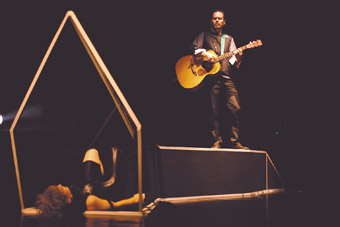
Depth Charge, Buzz Dance
photo by Loft Group
Depth Charge, Buzz Dance
The boldness of Depth Charge falters at its inception. A mild mannered musician, Leon Ewing, enters the ordered laboratory, takes the first guitar from the board and sings. Screen codes appear and fade into supine dancers moving like their live counterparts on stage. After the fact of ‘creation’, genetically engineered dance creatures take over. Could it be that the collaborative team, led by artistic director Felicity Bott, intended to upend the obsessive behaviour of those legendary megalomaniacs, Drs Coppelius and Frankenstein, to suggest that birth transgressions now reside in computer nerds’ fingertips? Desires to create the perfect loved one flicker as does a utopian notion of ‘creativity,’ but the resultant cyborgs of flawless skill do not convey any of the conflict of Coppelia’s soullessness nor of the tragic designation of Frankenstein’s unloved monster.
Even the promising sequence of computerised joint manipulation played out between screen imagery and performers becomes aesthetically normalised, voided of the computational crunching that arguably would be required to tease a forearm’s complex articulation. Explosive rock dissolves too quickly into harmonious scores to intimate gravel-like irruptions and the dancers’ virtuosic performances suggest other than fearsome bionic creatures defying ethical parameters of humanness. Admittedly, Depth Charge is a work-in-progress, still in a stage of genesis wherein the main thrust of the work has yet to find its shape of impact. Its multiple influences and modes, at this point, evade cohesion.
The Trilogy, alternatively, enacts a single idea—relations between music and dance—through two compositors bent on teasing out eye-ear interconnections with distilled detail and glissandos of playful daring. Ironically, this gentle work of art exemplifies scientific rigour.
Bearing imprints of postmodern minimalists, the dance of Ann Teresa de Keersmaeker (Company Rosas) and the music of Philip Glass and Steve Reich, this experiment in performance makes gesture vibrate and sound twist and skip in Möbius-strip loops where the distinctiveness of one expressive form slides over into the textures of the other. Viewed from another set of coordinates, the two mature spirits (performers/scientists) map out sketches of a Wagnerian total theatre. This appealing small talk theatre contains all dimensions: the tension, intensity, amazement and incisive timing of a spectacle seen through the key-hole of human intimacy. On the other hand, Burrows and Fargion simply engage in a conversation that begins and ends on chairs. That’s where the bald pates’ acrobatics lie, in the flips, crossovers and slightly competitive actions while sitting.
Both Sitting Duet opens with the performers placing their scores on the floor, signalling the eloquent dance of palms, wrists, fingers, elbows, shoulders and head which unfolds until upper torsos, whipping tongues and side-glances are all involved in the rhythmic interplay. Parodic classical ballet moments splinter into the exchange, with Burrows using the encoded position of the arms in counterpoint with Fargion’s four metre bar scansion. Mathematical in-jokes elucidate the scientific scrutiny of the complex music-dance relationship. The quips are deliciously fast, resounding against a Cage-like silence until the coda is punctuated with erect moments of stamping like some ironic operatic crescendo which dissipates back into the sitting.
A roar from Fargion describing a downward-bending walk from Burrows launches The Quiet Dance. Reciprocation comes with Burrow’s ‘shussing’ the same phrase enacted by Fargion and so the permutations spill sonically, rhythmically and spatially to enunciate and amplify the rifts initiated in the ‘sitting’ gestural animations. Music is harnessed to the dance, made literal by the glanced partnering conventions where Burrow leads Fargion physically across the space.
Speaking Dance reverts in some ways to known Dadaist experiments with word, sound and rhythm and, though cleverly exploiting innuendoes of ‘left’, ‘right’, ‘stop’, and ‘come on’, the effect separates music and dance, dislocating Burrows’ beautifully executed movement from Fargion’s equally exquisite Italian folk singing. Is this a mirror-image of Sitting’s silent dance where sound becomes the dominant motif, or an expression of dance’s freedom from musical enslavement? Text, recorded music and harmonicas, while treated playfully, break the spell of the intimacy between these two nomadic scientists of the imagination.
Science and art share explanatory functions in human affairs. Over time, their divergences have become ostensibly acute with science’s emphasis on fact and art’s claim to imaginative capacities. Burrows and Fargion’s unorthodox, yet meticulously formal experiment into the facts of sound and movement questions such deviations, asking, moreover, why knowledge needs to be compartmentalised. Their Trilogy initiates questions for the future when two middle-aged men may encounter younger but, possibly, less informed cyborgs.
STRUT dance: Jonathan Burrows, Matteo Fargion, The Trilogy—Both Sitting Duet, The Quiet Dance and Speaking Dance; PICA, April 26; Buzz Dance Theatre, Depth Charge: Dance meets science with explosive force, Playhouse Theatre, Perth, May 6-16
RealTime issue #91 June-July 2009 pg. 37
© Maggi Phillips; for permission to reproduce apply to realtime@realtimearts.net
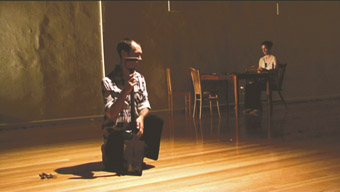
Paul Romano, Luke Hickmott, The weight of the thing left its mark
photo Dianne Reid
Paul Romano, Luke Hickmott, The weight of the thing left its mark
THE WEIGHT OF THE THING LEFT ITS MARK IS ABOUT SUBJECTS AND OBJECTS. THE OBJECTS ARE DOMESTIC IN SCALE, HOUSEHOLD ITEMS TAKEN FROM A DRAWER OR CUPBOARD. THE SUBJECTS ARE HUMAN, TWO OF EACH KIND. THIS IS AN IMPROVISED WORK, THAT IS, AN IMPROVISATION WITHIN A FRAME OR SERIES OF FRAMES. THE DOMESTIC SETTING OFFERS ONE SUCH FRAME. IT HELPS US LOOK AT THE MEN AND WOMEN AS IN SOME KIND OF RELATIONSHIP.
The breadth of the upstairs theatre at Dancehouse is warmed by a soft, golden light. It creates a panoramic kitchen scene, maybe in a farm. All begin seated around the table, alongside a large pile of cutlery. We wait. The waiting suggests a degree of flexibility. Perhaps the performers do not know who will begin or how. Is there a reluctance to start? The responsibility for beginning can be felt even before the dancing occurs. Once begun, the flow of the movement then takes over and the burden lessens. The utensils help. Small confined moves slowly build towards a crescendo of sound. The cutlery is hard, almost violent.
One by one the dancers rise to perform. Since most of them enter through a solo improvisation, the first kind of relationship is to the self as seen by others. This is how the solos looked to me. The rhythm of each improvisation was articulated into chunks, where each chunk constituted a move. The mind of the performer appeared to demand the repeated influx of ‘new’ movements. A succession of moves ensued where much attention was given to the joints of the limbs. These broke up the flow of movement but seemed to offer the reassurance of a certain kind of focus and logic. It is as if the bones of the body and their pivotal moments —knees, elbows, hip joints, ankles, neck—were the fabric of the movement.
Dancers choose between these dominating possibilities. One dancer flings her body from an anchored centre. Another falls into the vortex of his joints. Finally, one dancer breaks this staccato rhythm with a more flowing approach. It is harder to discern the percussive rhythm of conscious choice (move-move-move-move) in this more durational solo.
The burden of ‘creation’ implicit in improvisation seems to be lessened when the responsibility is shared. The duets in The Weight… were more than dialogue. They created feelings and atmospheres which belonged to a new unison, one formed between and across the two bodies. The girl-girl and boy-boy duets were distinctive and interesting. One of the dancers (Paul Romano) performed an extended dance with a spade, working with and responding to its weight with great clarity. Other objects were also brought into relation to the dancing—the cutlery, knives, a pitchfork, pouring grain from a sack.
There were times when the objects seemed to take on the responsibility of choice in this work, where they had more agency than the performers. Is this the weight of the object? If so, then there is a perceptible oscillation in The Weight of the Thing Left its Mark between the conscious agency of the dancer and the potential of the object to assume that agency. And the dancing is to be found in between.
The Weight of the Thing Left its Mark, director, choreographer Shaun McLeod, performers, co-choreographers Olivia Millard, Paul Romano, Sophia Cowen, Luke Hickmott, sound design Madeleine Flynn, Tim Humphrey, lighting Daniel Holden; Dancehouse, Melbourne, April 23-26
RealTime issue #91 June-July 2009 pg. 38
© Philipa Rothfield; for permission to reproduce apply to realtime@realtimearts.net
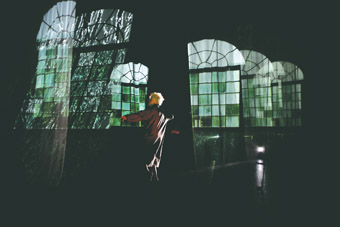
Tess de Quincey, Ghost Quarters
photo Mayu Kanamori
Tess de Quincey, Ghost Quarters
WATCHING DE QUINCEY CO’S GHOST QUARTERS IS LIKE WITNESSING THE GROWTH OF A FOREIGN ORGANISM, ONE THAT TRIGGERS IN EQUAL PARTS CURIOSITY AND ANXIETY. NOT SURPRISINGLY IT’S AN APTLY GOTHIC EXPERIENCE. THOMAS DE QUINCEY (1785-1859), THE ESSAYIST WHOSE WRITINGS INSPIRED THIS WORK, NUMBERED AMONG HIS ENGLISH ELDERS AND PEERS THE PIONEERS OF THE LITERARY GOTHIC. ADDING ANOTHER LAYER OF EERINESS IS THE POSSIBILITY THAT TESS DE QUINCEY, HERE EMBODYING, OR SHOULD I SUGGEST CHANNELLING (IF IN NO WAY ENACTING) THE GREAT MAN, IS POSSIBLY ONE OF HIS DESCENDANTS.
Ghost Quarters evolves like an expanding, multiplying cell. The audience, embraced by surround sound, sits on either side of a large installation, its long strips of translucent material rising high into the ceiling. Projected onto and through them are immersive images created by Sam James that evoke the now dream-like environments—unkempt nature, a haunting household with ornate chairs and chandeliers, a huge industrial space (using CarriageWorks itself)— the writer once travelled through and by which he was psychologically shaped.
De Quincey is curled on the floor, quivering into life, or is it possession? As she rises to engage with this strange space, in movements that seem to alternate tremulously between claustro- and agoraphobia, so do images, visual and aural, begin to consume us. Shimmering grass reappears, grown spookily tall, an arched window appears on high, beckoning but threatening as the relentless chatter of the sound score suggests murder.
Later De Quincey grapples with the hung material, pulling it after her as if to take control of the writer’s disturbed vision (he wrote The Confessions of an Opium Addict), then ventures out towards the audience, almost as if seeing us, pushing at some inner boundary. Finally, she exits through a huge creaking CarriageWorks door to the outside world, as if perhaps released.
If Ghost Quarters is an intriguing work replete with moments of palpable tension and sublime beauty, it is also a work not fully grown. De Quincey is, as ever, fascinating to watch, but my engagement with Ghost Quarters was disturbed by the chattering sound score, a word salad reminiscent of experimental radio works of recent decades. The credits attribute the vocals to Amanda Stewart, but there’s an altogether odd mix of voices, accents and vocal styles, while the setting for Stewart’s own delivery is pitched so low as to make her often unintelligible.
Jane Goodall’s text, drawn from Thomas de Quincey’s writings, is interesting in itself, when you can pick it out from the echoing repetitions and layerings (presumably intended to suggest that he ‘heard voices’), but there doesn’t seem to be a lot to it. Each of its several key passages relate to moments in the essayist’s life, to events, psychological states and to ideas about nature and murder, but they are slender, leaving you greedy for more. No amount of sound manipulation and design can compensate. Why not something more from Thomas, just to make a little more sense of the man and his condition? This need not be a surrender to the conventions of documentary or narrative. And as there’s one Tess embodying Thomas, why not then one voice, Stewart’s? Ghost Quarters is a fascinating work that has room to grow, to become an organism both more spacious and dense.
–
De Quincey Co, Ghost Quarters, first dream of The Opium Confessions, dance Tess de Quincey, script Jane Goodall, vocals Amanda Stewart, video Sam James, sound Ian Stevenson, lighting Travis Hodgson, CarriageWorks, May 6-10
RealTime issue #91 June-July 2009 pg. 38
© Keith Gallasch; for permission to reproduce apply to realtime@realtimearts.net
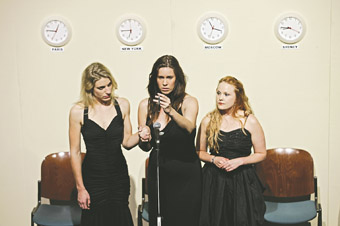
Shelly Lauman, Katherine Tonkin, Anne-Louise Sarks, 3XSisters, Hayloft Project
photo Jeff Busby
Shelly Lauman, Katherine Tonkin, Anne-Louise Sarks, 3XSisters, Hayloft Project
THE APPARENT DEMISE OF THE CLASSIC PLAY IS A BIT OF A STALE POINT THESE DAYS. THOUGH THERE ARE STILL INTERMITTENT RUMBLINGS ABOUT THE INCREASING DOMINANCE OF NON-TEXT-BASED THEATRE, A QUICK LOOK AROUND WILL PUT THE ARGUMENT TO BED. EVEN MALTHOUSE THEATRE’S MICHAEL KANTOR—ONE OF THE MOST VOCAL PROPONENTS OF COLLABORATIVE, IRREVERENT THEATREMAKING—REGULARLY TURNS TO THE OLD GREATS FOR MATERIAL. THE INDIE SECTOR, TOO, IS POPULATED BY CANONICAL TITLES. A BRIEF SURVEY OF SOME RECENT ADAPTATIONS DOESN’T EXACTLY ARGUE WELL FOR THIS FAITH IN THEIR ENDURING VALUE, HOWEVER.
The Hayloft Project’s ambitious take on Chekhov’s Three Sisters—here renamed 3xSisters—is the first case in point. Three directors took randomly selected chunks of the original and independently produced their own bold reimaginings employing the same cast. Simon Stone took a fairly modernist, faithful approach. Relocating the opening and closing parts of the play to a brightly lit waiting room, he confidently played around with the setting and structure of the work while remaining true to its dramatic core. This is consistent with Stone’s past Hayloft efforts such as Spring Awakening and Platonov, both excellent productions that successfully reshaped classic texts to revitalise their essence without bastardising their original spirit.
Benedict Hardie’s sequences employed meta-theatrical devices to denaturalise Stone’s preceding scenes. Suddenly we were watching a group of actors rehearse and discuss the play, with occasional directorial interruption and character swapping. Though more formally innovative, it was never clear what this distancing was supposed to achieve, and Chekhov’s narrative certainly disappeared in the controlled chaos of rehearsed spontaneity. I suppose it’s a nice irony that the script faded away once it was being held in hand onstage by the performers.
Mark Winter’s central section of the play was the most confounding, seemingly dispensing with the text almost entirely and injecting an array of intertexts which seemed almost randomly selected. Mild jabs at the Australian performance landscape—an emergency theatre kit posted by Benedict Andrews, for instance—collided with entire slabs of dialogue lifted from Scorsese’s Taxi Driver; bloody violence was dispensed with casual abandon; characters lost any sense of verisimilitude as they became mere velocities, effects without cause. It’s the kind of anti-theatre that Black Lung, of whom Winter is a member, do so well. Here, not so much.
The question which underscores 3xSisters is—why? Why adapt Chekhov at all? The play itself seemed of little interest to the directors, acting rather as a hook upon which to hang a series of formal or stylistic costume changes. This might be a worthy artistic choice if any of these forms were advanced in productive new ways, but as theatre, meta-theatre or anti-theatre, 3xSisters never quite goes beyond the level of experiment.
I’m all for irreverence, though. Caryl Churchill’s 2005 translation and adaptation of Strindberg’s A Dream Play radically reworked the original, paring back its bloated mass to produce a tighter, more aerodynamic thing. This is commendable, since Strindberg’s play is of much historical interest but pretty dusty looking these days. The 1901 text may have been a pioneering work of non-rational, non-naturalistic theatre, but it’s naïve to try to recreate that avant-garde experience in an age where surrealism can be found in a Cadbury’s chocolate commercial.
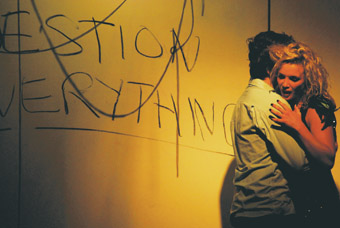
Michael Finney, Meredith Penman, A Dream Play, IGNITE
photo Chris Nash
Michael Finney, Meredith Penman, A Dream Play, IGNITE
Ignite Theatre’s production of A Dream Play managed to enable a rewarding experience despite the limitations of its source. This was mostly due to Churchill’s text and strong, energetic performances from a group of young-ish but well-experienced actors. Meredith Penman delivered a dynamic, visceral protagonist who held together the disparate, illogical scenes which make up the play; her fellow cast-members each took on a variety of roles and managed to make each distinct and, mostly, attention-grabbing. The only hobbled point of the work is the lengthy sequences involving the tortured Writer, a partial stand-in for Strindberg himself. Nobody needs to see the old cliché of an angst-riddled writer wrestling with the meaning of the universe; let the work itself do that job. Ignite and director Olivia Allen do the best they can with this little hiccup, though, and at least the rattling pace of the production doesn’t allow it to dwell too long on such sludgy moments.
If there’s one writer who epitomises that tortured cliché, it’s good ol’ Kafka. A figure whose biography is as fascinating as his writings, Kafka is as good as his reputation suggests. Many of his stories feature the image of the message which can never reach its recipient or the seeker forever delayed from reaching his destination; apt metaphors for the meanings of his elusive works themselves, which constantly retreat from our interpretive grasp without ever fully escaping our hopeful advances. If you can’t tell, I really like Kafka. I also really like monkeys, but the recent Malthouse Theatre presentation of UK performer Kathryn Hunter’s acclaimed turn as Kafka’s Monkey, touring nationally, disappointed on both fronts.
The piece is a solo adaptation of Kafka’s short story “A Report to an Academy.” A monkey is shot by hunters on the coast of Africa and transported to civilised Europe, learning along the way to ape the actions and speech of his masters in order to survive. He eventually chooses a life on the variety stage—the zoo being his only other option—and suppresses all traces of his earlier existence. It’s a tiny work but there’s a lot going on beyond this quick synopsis. The story raises thorny questions of the naturalness of identity, the fluidity of performance and countless connotations of otherness and the violence of acculturation. All of these are present to a degree in Hunter’s performance, but what is lacking is a real sense of the monstrous role of language underscoring Kafka’s story.
In A Report to an Academy, language embeds itself as a kind of cage, imprisoning the narrator. The ironic, coolly rendered prose is itself a problem, making evident the forced abstention of any actual “monkeyness” from its speaker. He is an exile from himself, a refugee who has built a raft of words. And, being a short story, words are all we have of his slippery existence.
The problem in performing such a text should be obvious—physically embodying a character who is more of an absent haunting than an authentic-seeming presence. And Hunter, under the direction of Walter Meierjohann, is a compelling physical performer. But her success is in imitating, even caricaturing, the loping, wide-eyed demeanour of a monkey. Her monkey is all presence, often stepping down into the audience to touch her spectators, or offer a banana, pick at fleas in their hair—solid theatre tricks that seem entirely misplaced here. Though she is clad in the stiff attire of a tuxedo and speaks of her assimilation into human society, this is an incarnation that seems intent on showing us a primate, rather than mourning its disappearance.
Kafka’s Monkey is a very watchable theatre, enjoyable even, but it’s not Kafka. And while 3xSisters barely attempts to be Chekhov, and A Dream Play displays an admirable distance from Strindberg, the more polished, expertly executed Kafka’s Monkey finally seems the least comprehending of its source.
The Hayloft Project, 3xSisters, after Three Sisters by Anton Chekhov, directors Simon Stone, Benedict Hardie, Mark Winter, design Claude Marcos, lighting Danny Pettingill, performers Gareth Davies, Angus Grant, Thomas Henning, Joshua Hewitt, Shelly Lauman, Eryn Jean Norvill, Anne-Louise Sarks, Katherine Tonkin, Tom Wren; Arts House Meat Market, April 24-May 10; Ignite Theatre, A Dream Play, after A Dream Play by August Strindberg, adapted by Caryl Churchill, director Olivia Allen, sound design Russel Goldsmith, lighting Angela Cole, set & costumes Kat Chan, Eugyeene Teh, performers Gary Abrahams, Meredith Penman, Mark Tregonning, Michael Finney, Heath Miller, Kate Gregory, Nicholas Dubberley, Hannah Norris, Karen Roberts; Bella Union, Trades Hall, May 5-17; Young Vic, Kafka’s Monkey, after “A Report to An Academy” by Franz Kafka, director Walter Meierjohann, adapted by Colin Teevan, performer Kathryn Hunter, set Steffi Wurster, costume Richard Hudson, lighting Mike Gunning, sound & music Nikola Kodjabashia; Malthouse, Melbourne, April 28-May 9
RealTime issue #91 June-July 2009 pg. 40
© John Bailey; for permission to reproduce apply to realtime@realtimearts.net
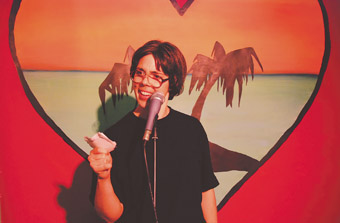
Kelly Doley, Six Minute Soul Mate Brown Council
photo Alice Gage
Kelly Doley, Six Minute Soul Mate Brown Council
SYDNEY PERFORMANCE GROUP BROWN COUNCIL ARE DOING PRETTY WELL FOR THEMSELVES. THEIR FIRST FEATURE-LENGTH PERFORMANCE, SIX MINUTE SOUL MATE, A DARKLY COMEDIC LOOK AT MODERN LOVE, RECENTLY WON THEM AND THEIR PRESENTING PARTNER, VITALSTATISTIX, THE ADELAIDE FRINGE AWARD FOR BEST THEATRE PRODUCTION. THIS MAY SEEM A TOUCH IRONIC FOR THOSE FAMILIAR WITH THE GROUP’S WORK, WHICH SERVES AS A CHALLENGE TO CONVENTIONAL NOTIONS OF THEATRE. BROWN COUNCIL’S WORK REVEALS A VERSATILITY THAT SEES THEM WORKING ACROSS GALLERY AND THEATRE SPACES, AS WELL AS THE MEDIUMS OF LIVE PERFORMANCE AND VIDEO ART.
As performers, Brown Council embrace an over-the-top theatricality but with a consistent sensitivity towards the audience’s experience. I saw Six Minute Soul Mate, a show for 12 people per 55-minute performance at Next Wave 2008 in Melbourne and the 2009 Imperial Panda Festival in Sydney—two very different experiences.
A glass of bubbly and friendly greetings upon entry are a nice prelude to seating instructions, “bunch up, get to know one another”, that come from our guide and chaperone for the evening, the Love Bear. Think Cupid with attitude, an oversized bear head and a stopwatch instead of a bow and arrow. Speed dating is the premise for Six Minute Soul Mate, the conventions of this modern phenomenon adopted to introduce the audience to three obviously desperate singles. Blue Lady, Pink Lady and Allen are played interchangeably by the members of Brown Council—Fran Barrett, Kate Blackmore, Kelly Doley and Di Smith. Meanwhile, cheesy love-pop asserts its irritating presence. Berlin’s “Take My Breath Away” is looping in my head, still, as I write this.
We meet the characters three times each in a series of six-minute exchanges, each signalling a further descent into the grotesquerie and folly of wretched singledom and of romance gone wrong. Desperation is taken to a new level when Pink Lady (Doley) stands in front of us pleading for someone, anyone, to kiss her. This night a willing audience member volunteers. When I saw the show in Melbourne, she stood in the dark pleading for four minutes to no avail.
Brown Council parade the tired symbols of romantic idealism in this critique of modern dating services—enterprises that exploit loneliness and desire, offering a ‘quick fix’ to lonely hearts. “My ideas of romance are simple”, sighs the Blue Lady, “flowers just for no reason, trails of rose petals leading to the bedroom.” She is perched in front of a painted scene of a snow-capped winter wonderland, framed as if seen through a heart shaped window. The backdrop suggests the artifice and emptiness of such pre-packaged romantic sentiments.
The loose script aims straight for parody, immediately establishing the comic tone that prevails for most of the show. Audience members are invited into cumbersome interactions with the characters. For six minutes Di Smith as Pink Lady tries to pickup an audience member, who happens tonight to be Charlie Garber, another performer whose group, Pig Island, are also featured in the Imperial Panda Festival. “What’s your name?” she begins. I have this weird feeling that the two are enacting a dialogue, and wonder how come Barrett as Love Bear knows most of the names of the audience and Pink Lady does not? Slight inconsistencies aside, the interaction is suitably awkward evoking patterns of intimacy and embarrassment that often go hand in hand.
Interactions are repeated as variations on the theme and the audience are drawn into differing levels of participation. At times clichéd questions are turned towards audience members. What would your friends describe you as? What is your idea of an ideal date? What is your profession? Age? What are you looking for in a partner? Unsurprisingly, these superficial questions yield little revelation about the person answering them, just as the constant use of this device in Brown Council’s dialogue limits us to a two-dimensional view of the characters. The entire audience, at times, becomes a blanket potential lover or life partner subjected to gushings of the characters’ wants and desires. At other times we play silent witness to things we may prefer not be involved in, but are now implicated in by our presence. We watch on as the Pink Lady (Blackmore) enacts an auto-erotic-asphyxiation fantasy submerging her head in a bucket of water as the pop classic “Take My Breath Away” provides the soundtrack. The vignettes all end the same way. The bells and time is up. A stopwatch-wielding Love Bear ushers the players off the stage.
In Melbourne, Six Minute Soul Mate came together as a playful response to the Next Wave theme “closer together” while embodying many of the provocations and contradictions of the theme. The performance played out as it moved through three small rooms above the Carlton Hotel. Each had its own sink and the whole scene was seedily reminiscent of a brothel—appropriate, given the love-for-sale ethos under examination. The work could have been described as ‘site-specific’, especially viewed in light of the Next Wave curatorial focus on non-conventional spaces. But in Sydney the siting of the piece in a gallery emerged as slightly problematic as the work failed to really inhabit the space. An awareness of large sections of the gallery not in use at any given time detracted from the type of forced closeness that had been achieved in Melbourne. The movement to three different locations around the gallery now seemed quite an arbitrary device for the change of scenery, and I was left wondering if this could have been achieved in a way more appropriate to the venue.
These are minor gripes though. The essence of the show I loved in Melbourne was undeniably still there. It lulls you along with gentle parody, and when it arrives at its poignantly striking images it does so with abrupt revelations amidst pity and laughter. The descent into grotesque seems complete in the last six minutes as I.T. funny-guy Allen (Barrett) lies trance-like on the ground rubbing his crotch and breathing “rub it rub it rub it” into the microphone. He is beyond expecting any of the “ladies” in the audience to oblige. I am disgusted and in stitches.
Brown Council, Six Minute Soul Mate, artists Fran Barrett, Kate Blackmore, Kelly Doley, Diana Smith, Imperial Panda Festival, Cleveland St, Surry Hills, Feb 14-16; Carlton Hotel, Melbourne, May 16-23, Next Wave 2008; http://browncouncil.blogspot.com
RealTime issue #91 June-July 2009 pg. 41
© Megan Garrett-Jones; for permission to reproduce apply to realtime@realtimearts.net
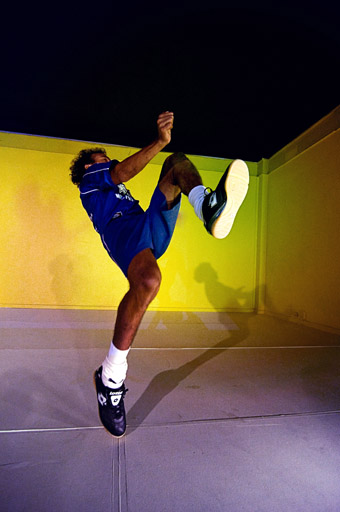
Ahilan Ratnamohan, The Football Diaries
photo James Brown
Ahilan Ratnamohan, The Football Diaries
THE YEAR 1974 IS CENTRAL TO THE FOOTBALL DIARIES. IT IS THE YEAR THAT PROTAGONIST AHILAN RATNAMOHAN’S PARENTS MIGRATED FROM SRI LANKA TO AUSTRALIA TO STUDY AND THE YEAR THAT THE DUTCH BROUGHT TOTAL FOOTBALL TO THE WORLD CUP. THE FOOTBALL DIARIES BRAIDS THESE TWIN HISTORIES—OF FAMILY AND FOOTBALL—TOGETHER TO CREATE A SHOW THAT IS DECEPTIVELY SIMPLE AND SURPRISINGLY MOVING.
Born in Australia to Tamil parents in the 1980s, by the age of 18 Ratnamohan was playing professional football in Europe. The journey to this point is long, winding, and occasionally treacherous. In one of the first scenes, he is running in a forest, exhausted and on the edge of an endorphin-induced delirium: we are in Germany, where Ratnamohan has been toiling with a second-tier club. We flash back a few months to Malmö, Sweden, where he was trialling with the professional football team there. Then back a few years to Sydney, where schoolyard soccer is “black versus whites, ethnics versus skips. If you’re a halfy, stay in the middle, we’ll sort you out later.” Finally, we flash back a few decades so that Ratnamohan can introduce us to his heroes, the two Johans—Cruyff and Neeskens—of Total Football fame.
This time-travelling is accompanied by much philosophising. If you have ever heard an elite athlete speak about their sport you will know they approach zen-like states during play and can deliver zen-like aphorisms afterwards. (Think for instance of Zinedine Zidane’s claim that “When you are immersed in the game, you don’t really hear the crowd. You can almost decide for yourself what you want to hear. I can hear someone whisper in the ear of the person next to them”, or of Wayne Gretzky “I do not skate to where the puck is, but to where it will be.”)Ratnamohan is no different, intoning “I do not make mistakes; before making a mistake, I do not make it.” In this error-free world, football approaches utopia: there is no such thing as skin colour and the ball does not care who strikes it. The fully functioning team resembles a fully functioning community where someone willingly stands out on the lonely wing, sacrificing themselves for the greater good.
For all its utopian potential, however, football often falls far short. Indeed, the game is rife with racism and we see footage of Paolo Di Camio’s infamous straight-armed salute as well as Samuel Eto’o stopping the game and threatening to leave the pitch as he begs the crowd—No más—to stop their monkey chants. It is clear that soccer is starting to sour for Ratnamohan and it is not long before he pushes an injury too far and has to sit on the sidelines for three months before eventually coming home to Sydney and, luckily for us, the stage.
This particular stage is a small studio space with three walls: the back wall serving as a screen for projections and the side two as sparring partners for training sessions with the ball. Sometimes these sessions are a battle, other times they are ballet. Director and devisor Lee Wilson draws a vast physical vocabulary from Ratnamohan, who can tease, tussle and tango with the ball and then, just as easily, turn a delicate pirouette on it or partner a tender pas de deux. Every once in a while it feels as if this might become a pas de trois or trente, as the ball sails towards the audience, only to stop just short. This sense of restraint is also evident in the sections where Ratnamohan addresses the audience directly—the stories are elliptical, evocative and often self-deprecating. Yet even as he charms us, he also challenges us, as when he coolly assesses spectators as potential footballers: “I’ve bet you’ve got fast twitch muscle fibres”, he says, or “I’m worried about his vision.”
In fact our vision is excellent thanks to Lara Thoms and Fred Rodriguez’s videos, which manage to evoke the blurred vision of a player in training, the kaleidoscopic vision of a player ‘in the zone’, and the retro vision of a player dancing with ghosts: his heroes; his parents; his school mates; his younger self; even his future, older self. This sense of spectrality is amplified by Mirabelle Wouters’ lighting, which has Ratnamohan dancing with his own pink, green, yellow and grey shadows. Similarly, when he says “I can hear football”, we can too, through James Brown’s soundscape which enables us to appreciate football as Ratnamohan might—as rhythm, refrain, pulse, pitch and climax. Or in the language of dance that recurs throughout the piece, as ballet, tango and tap.
The many mentions of dance recall another, and as the show comes to a conclusion, and Ratnamohan steadies himself, breathing, balancing the ball on his head, I think of the last line of Yeats’ poem Among Schoolchildren: “How can we know the dancer from the dance?” In the language of football, how can we know the player from the play? In the case of Cryuff, we can’t; he now has a turn named after him. Likewise, in the case of The Football Diaries and Ratnamohan, it’s impossible to separate the two. No one else could have created this work and no one else could have performed it with such grace, agility and humility.
The Football Diaries, performer, devisor Ahilan Ratnamohan, director, devisor Lee Wilson, sound artist James Brown, video Lara Thoms, Fred Rodriguez, set & lighting design Mirabelle Wouters, dramaturg Alicia Talbot; Urban Theatre Projects, Bankstown, Sydney, April 22-May 2
RealTime issue #91 June-July 2009 pg. 42
© Caroline Wake; for permission to reproduce apply to realtime@realtimearts.net
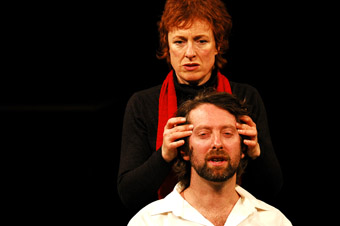
Heather Bolton, Paul Lum, Affection, Ranters
AS MORE OF AUSTRALIA’S LARGER PERFORMING ARTS VENUES TAKE ON MORE RESPONSIBILITY FOR COMMISSIONING, CO-PRODUCING AND TOURING WORKS BY SMALL TO MEDIUM THEATRE AND PERFORMANCE COMPANIES, AND AS SCHEMES LIKE MOBILE STATES AND MAPS FACILITATE CREATION AND MOVEMENT OF WORKS, THE FULL TILT PROGRAM AT MELBOURNE’S ARTS CENTRE IS LIKEWISE BOLDLY PRESENTING A TRIO OF PRODUCTIONS FROM THE SECTOR’S LOCAL THEATRE INNOVATORS.
Full Tilt’s artistic director, Vanessa Pigrum, explains that her program has been focused, from inception, on cross artform works, but the opportunity arose to program three works with “a clear focus on text” and “musicality…there’s something orchestral about them.” Like an increasing number of plays, the programmed works also bear the influence of cross artform practices. Ranters’ new work, Affection, will doubtless display the sense of installation, music theatre and autobiography in the weave of their previous work, the popular and well-travelled Holiday. Pigrum also admits to pragmatism—three Arts Centre spaces just happened to be available at the right time, as were the artists she’d been in conversations with for up to two years: “it often takes at least 18 months to arrive at a production.”
The program includes a remount of Red Stitch’s Red Sky Morning (June 3-13); followed by a new play about love, “love as adrenalin, love as joy and hope, love as hysteria, love as a curse, love as weakness and love as redemption”, Poet #7, by Ben Ellis and directed by Daniel Schlusser (June 8-21); and the new work by Ranters, Affection (July 1–12), which has been in creative development with Full Tilt. Like its bracing predecessor, Holiday, Affection will be conversational, question the audience-performer relationship and work from the lives of its creators. Richard Watts will host “a newish initiative”, The Talk Show on 2 June, July 7, August 4 and September 1 at Black Box for those wishing to deepen their responses to the program and argue current arts issues.
Pigrum sees the trio of shows as “perfect winter fare: a warm coat, a glass of red and a discussion of meaty works”, and she’s hoping that audiences will take in at least two of the shows, to pick up on the resonances and continuities in these new contemporary theatre works.
I ask Vanessa Pigrum about her involvement in Full Tilt’s Creative Development program, which supports the emergence of new works. She describes her role as part-producer, part-dramaturg, involved early in the process “teasing out some of the key imperatives with the artists”, stepping back during the workshopping, offering frank feedback of the outcome” and sometimes suggesting the participation of another artist, “to add another dimension to the work.”
Pigrum tells me that Another Full Tilt program cluster will manifest in November-December with five productions including cross artform productions alongside innovative theatre works: Hayloft’s first production of an Australian play, about Jesus no less, and Kylie Trounson’s roller-skating fantasia set in the 1980s, The Man with the September Face, developed with Playwriting Australia. Full Tilt continues to do its substantial bit in the growth of opportunities for new work.
Full Tilt, Arts Centre, Melbourne, www.theartscentre.com.au/full-tilt/about.aspx
RealTime issue #91 June-July 2009 pg. 42
© Keith Gallasch; for permission to reproduce apply to realtime@realtimearts.net
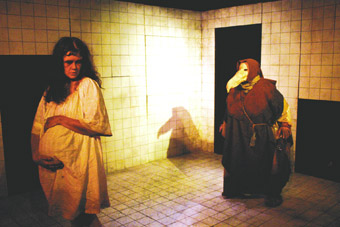
The Greater Plague (2005 production), The Restaged Histories project
photo Andy Miller
The Greater Plague (2005 production), The Restaged Histories project
TWO TRANSPARENT PLASTIC SCREENS PARTITION THE STAGE. WITH LIGHTS, THEY ARE TRANSFORMED INTO DIM CORRIDORS TRAVERSED BY SEMI-NOCTAMBULAR BEINGS. IN A SCENARIO REMINISCENT OF CREEPY MOVIES, A MODERN DAY PREGNANT YOUNG WOMAN AND HER TEENAGE SISTER ARRIVE AT A HOUSE, UNCLEAR WHY THEY ARE THERE, DRAWN BY A SINISTER NURSE AND OLEAGINOUS JANITOR INTO A MIASMA OF SADISTIC, HISTORICAL GAMES.
The house doubles as a plague house from 17th century Europe which held people suspected of being infected by the plague for 40 days, after which they would either have succumbed or been set free. But often inmates went mad from fear and paranoia in any event. As a mis-en-abyme, the house incorporates the past, the present and the future, not least in terms of the theatrical spin given our own so-called post-dramatic situation. The Restaged Histories project’s production of The Greater Plague is not history. It’s a perversely ludic riff.
For most of us, in any case, history is not remotely veridical, but consists of wildly denoted pictures in our heads mediated by Hollywood or flickering newsreels. The equivalent 19th century mediators of historical and current events were the music halls and the penny arcades, a program reference to performing venues which were holes in the wall catering to the poorest audiences. The Greater Plague revives this tradition in a series of set pieces conjured up by the house’s agents. The janitor as a parodic Jolly Jack Tar, draped in the Union Jack, travels the world in pantomine while Ur-asian women posture and solicit behind him. Illness strikes and he heads for home and safety. Unbeknownst to him, the plague (sexual?) comes too. A family of Restoration-costumed mechanical dolls enact a history of sexual licence and abuse involving all the generations and a corrupted genealogy of dangerous liaisons for the pregnant woman.
Another abusive family of pig-breeders, murderous, bestial and deformed in swinish fat suits, provides the back story for the starched and sterile nurse (Ratchett?). In a more contemporary version of the penny arcade, the younger sister of the pregnant woman hams it up, doing a karaoke rendition of Whitney Huston’s “I Will Always Love You” as an expression of her misplaced adolescent feelings for the misogynistic, inarticulate and violent janitor who is also a practising necrophiliac, in love, so to say, with death.
Humanity appears almost without exception execrable or, at the very least, wretched. Admittedly, this is through the lens of ironic, comical, deliberately ludicrous Gothicism that delights in its own dark excesses. It can’t be taken seriously, or can it? What are the connotations of The Greater Plague that transcend the actual epoch of The Great Plague? Given the nasty sexual undertones, I suggest it means something like Wilhelm Reich’s emotional plague that he declared endemic down through history.
Beset by rules and regulations represented by conventions in the theatre, the Restaged Histories project takes lovely liberties, and at least one character refuses to play her role. According to Bataille, evil does not negate but rather completes human nature, hence the necessary transgressive nature of art embodied in her gesture. The formidable performance ensemble—Jonathan Brand, Morgan French, Emma Pursey, Emily Tomlins—supported this gesture like a gloved hand. But this sort of reductive speculation is redundant in terms of the apparent anti-aesthetic espoused in the production. It didn’t progress according to the beginning, middle and end of telling a story, but instead digressed in ways that foregrounded a proliferation of meanings. The company’s democratically inclined notion of theatre also drew on a variety of redeployable theatrical means gone into overdrive—from the janitor’s malign clowning to the surreal pantomimes to the pregnant woman’s high melodramatic hysteria. There was Brecht in there, but a distinctively postmodern Brecht.
The Greater Plague was not without flaws. Despite its Gothic vitality, it often lumbered and seemed to run out of oomph a good 10 minutes before it ended. The screens, so good in combination with Carolyn Emerson’s atmospheric lighting in establishing an initial, cinematic mood, contributed however to a flattening of affect. They distanced the audience from the performers, appropriately enough at times in the penny arcades, but otherwise denied us a way in to the core of the performance, or any real intimacy with the physical reality of the performers. Effectively, we were screened out. This feeling of exclusion can irritate an audience more than anything else in theatre (more than proliferations of meanings!). The karaoke went on too long. We got the point. And the screens muffled the voices. Sometimes I found myself tuning out and listening to Steve Toulmiin’s subtly crafted soundscape instead.
The Restaged Histories project is by Nic Dorward and Kieran Swan. The Greater Plague at Brisbane Powerhouse was their own restaged version of a work first presented at Metro Arts in 2005. Since then they have received support from Brisbane Powerhouse Artists-in-Residence and MAPS for Artists programs so the production came weighted with expectations. If it didn’t quite defy the tilt, Dorward and Swann are a new generation of fabulous liars in a mundane world where, as perhaps the show problematises, the vanguard is now funded by the state.
The Restaged Histories project (Nic Dorward, Kieran Swann), The Greater Plague, performers, Jonathon Brand, Morgan French, Emma Pursey, Emily Tomlins, lighting Carolyn Emerson, composer, sound designer, Steve Toulmiin; Brisbane Powerhouse, April 22-May 2
RealTime issue #91 June-July 2009 pg. 43
© Douglas Leonard; for permission to reproduce apply to realtime@realtimearts.net
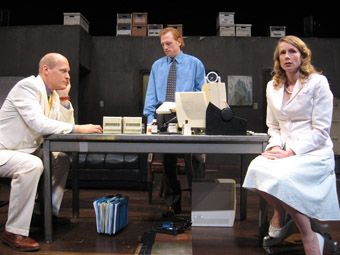
Jim Fletcher, Scott Shepherd & Lucy Taylor, Gatz, Elevator Repair Service
courtesy the artists
Jim Fletcher, Scott Shepherd & Lucy Taylor, Gatz, Elevator Repair Service
GATZ, BY NEW YORK’S ELEVATOR REPAIR SERVICE, IS ONE OF THE STRANGER THEATRE EXPERIENCES OF RECENT TIMES, HOVERING TANTALISINGLY BETWEEN STRAIGHT PLAY-MAKING AND CONTEMPORARY PERFORMANCE. THE WORK RARELY SLIPS INTO BEING A LITERAL DRAMATISATION OF THE NOVEL, EXCEPT TOWARDS THE END, AND THEN TO CALCULATED EFFECT. IT’S AS IF WE ARE WITNESS TO AN INTERPLAY BETWEEN PARALLEL UNIVERSES: A 1990S CITY OFFICE AND THE 1920S OF F SCOTT FITZGERALD’S NOVEL, THE GREAT GATSBY.
But while the office workers read and enact the book, they do it quite unconsciously. It has little reciprocal impact on their lives save for the central reader’s absorption in it and the occasional curiosity or irritation of the others. The novel they give voice and body to does not loop back into their lives. You would think that this might yield an incomplete theatrical experience but, curiously, it doesn’t. It’s not a play about these people. It’s about something else, a novel and how we and the performers imagine and make actual the world it conjures.
In a realistic, tired looking city office, a worker in a down-time moment when his computer fails finds a copy of The Great Gatsby and begins to read it, aloud. He doesn’t stop, although office life continues around and sometimes with him and night and day seem to pass. His computer is checked, taken away and returned, but never works. He keeps reading, becoming the voice and sometimes the body of the novel’s narrator Nick Carraway. His fellow workers, without fanfare, become the other characters. There are simple links: the worker who reads golfing magazines and practises her swing becomes Jordan Baker; the computer technician becomes a garage mechanic; the boss, like Gatsby, is a somewhat distant, reticent character, an ominous presence. The humble office becomes mansion or hotel, but only, as in the act of reading, by virtue of the conjuring power of words, and here along with the deft deployment of office ware as props. Gatz is first and foremost a reading but its actor-office workers prompt us to imagine Gatsby’s world with them. And while they can never make it real (a filing cabinet will never be a chest of drawers full of exquisite shirts) they, and Gatz’s creators, offer not just reading, but a reading of the novel.
But first, there’s an odd pleasure in simply being read to in the comfort of a theatre, although much theatre we experience is, of course, so rooted in words that theatre-going, as listening, is often another form of reading. There’s also a sense of challenge and, finally, of achievement for the performers and audience of Gatz—the reading of and listening to every word of The Great Gatsby over some eight hours. For most of its audience, it’s a painlessly ‘durational’ performance. We’re not just listening, we’re ‘seeing’ a novel through the bodies of unglamorous office workers, themselves pretty much ciphers, dextrously wielding office props and unconsciously if convincingly play-acting. They are at their most real when they become Fitzgerald’s characters. (The actors are only identified on the cast list in terms of their characters in the novel, not their office personae.) But their vision, and that of Gatz’s creators, of the world of the novel is determined by their means: the words heard are immediately re-shaped for us as tableaux, as witty improvisations, comic turns, farce and song, engendering not only immediacy but amplifying the novel’s underrated satirical bite and Nick’s penchant for moralising. As with any interpretation there’s room to disagree: reducing the re-meeting of Gatz and Daisy to embarrassed farce undercuts a significant part of the novel’s power. Among minor irritations, in this case of humour lost, was the drowning out of Nick’s listing of Gatsby’s well-to-do guests with a loud recording of a 20s tune: the names might well have come from the hand of the comic genius of Fitzgerald contemporary and Marx Brothers’ collaborator, SJ Perelman.
A much bigger challenge arrives when, with significant rearrangement of furniture and radical intensification of lighting, the semblance of office disappears and the fateful hotel gathering on an overbearingly hot day is starkly realised. Although a risky departure, the scene manages to work, in good part because of its oppressive and threatening stillness, the lateral positioning of the characters, whom we know so well by now, and because we’re still being read to. It’s not long, however, before the office worker reading the final pages of the novel puts it down, faces us and continues to deliver the narrative. For a brief while, this obsessed reader becomes totally Nick. As in the best reading experiences, the self appears forgotten and office worker and the novel’s narrator become one, eye to eye with us, his readers in turn.
Despite a little too much of an inclination to comedy and over-stated irony, and a late tendency to over-theatricalisation, Gatz proved a deeply rewarding re-visiting of a classic novel, at the same time generating an intriguing meditation on the experiences of theatre and reading. The casual, taking-its-own-time performance mode was immediately engaging; you could nestle into it. Scott Shepherd’s reading of most of the book (another actor takes over briefly) was quietly brisk and unaffected. For an actor with an eye almost constantly on the book we never doubted his presence nor, eventually, that his office worker might become Nick. Ross Fletcher’s looming, formal Gatz, intoned Fitzgerald’s dialogue with almost Brechtian detachment, and the other players convinced even where limited to broad gestures.
Gatz is a work of great invention and craft, of Herculean effort and, above all, imagination—which is its very subject, playing off the experience of being read to against witnessing a simultaneous, if lateral, interpretation of the reading, until the two meet. The boldness of the work lies in its refusal to psychologise its office workers, they are supple puppets, play-acting a great novel, layering a suggestive, interpretive filter between audience and book.
Elevator Repair Service, Gatz, The Great Gatsby by F Scott Fitzgerald, director John Collins, set design Louisa Thompson, lighting Mark Barton, sound design Ben Williams, costumes Colleen Werthmann; Playhouse, Sydney Opera House, May 15-31:
RealTime issue #91 June-July 2009 pg. 43
© Keith Gallasch; for permission to reproduce apply to realtime@realtimearts.net
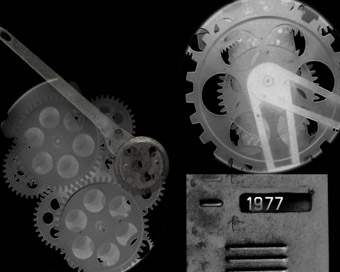
from audiovisual performance, Electronic Church, Berlin (2008); Sam James
SAM JAMES, QUIETLY SPOKEN BUT FIRM OF OPINION, IS THE SUBJECT OF THE SECOND IN OUR SERIES OF ARTICLES ON ARTISTS (JASON SWEENEY WAS THE FIRST, RT88, P46) WHOSE OWN CREATIONS SIT BESIDE THE WORKS MADE COLLABORATIVELY WITH OTHER ARTISTS. JAMES IS WIDELY ACKNOWLEDGED IN THE PERFORMANCE COMMUNITY AS A TIRELESS, INVENTIVE MEDIA ARTIST—FILMMAKER, VIDEO ARTIST AND DESIGNER. THE RESULTS ARE POWERFULLY EVIDENT IN HIS RECENT WORK FOR ERTH (NARGUN AND THE STARS), MY DARLING PATRICIA (NIGHT GARDEN) AND DE QUINCEY CO (GHOST QUARTERS).
James’ imagery is potent whether as the polished, layered animations, land and waterscapes of Erth’s Nargun and the Stars or the onstage improvisations for De Quincey Co’s Improlab, where a change of lens and a shift of focus can transform an innocent object into something fantastical. His Anamorphic Archive, an entrancing, alchemical engagement with dancers he’s documented, is evidence of the capacity for James’ work to stand strongly on its own. At the same time he’s collaborated with choreographers-turned-filmmakers, helping them (on camera or as editor or projection designer) to realise their visions and compete as finalists for awards.
Sam James describes himself as a theatre and media designer, which seems apt since as film- and video-maker he’ll create spaces by projecting onto multiple screens or walls and through materials. It’s not surprising then to find that his education included architecture and sculpture, and that he describes his creations for other artists as “media installations.” His output has been prodigious, designing media installations for over 200 productions since 1995, when he began designing for PACT Youth Theatre and adding dance film to his practice in 2000, with Potsdamer, featuring Martin del Amo. Many of his collaborations have been with artists associated with Performance Space, although his work has taken him to the Sydney Opera House, Sydney Dance Company and the Australian Ballet. His dance film Nun’s Night Out (2006), made as a super-8 docu-drama for director Julie-Anne Long’s The Nun’s Picnic, won Best Australian Dance Film at the Australian Dance Awards in 2007.
How and where did you start out as an artist?
I studied Architecture for three and a half years at Adelaide University, then fled to the College of Fine Arts in Sydney and began sculpture and installation in first year and then moved into film with Stephen Cummings. I made three films in two years, all unbearably expensive, but essentially process films. I’d start with one or two ideas of filming people I knew in abstracted impressions of their normal life and it would progress in experiments using one or two rolls of film every month or so. I would edit the material on video. I realized through editing you can make up a reality, which is still now my main interest.
How did you find your way into collaboration?
I made a work at Performance Space in 1999 that really took it out of me in terms of the complexity of imposing my ideas on other artists. I consider all artists to be equal. Some have louder voices and some make their work hit in the right time and place. Other artists are less able to be collaborative; it’s not in the nature of their process. I realised that to survive I had to collaborate. To me it seems either you are in collaboration or in your own void. It has a lot to do with artists’ personalities and their sociability.
What do you regard to be your key works?
When I was 21 I wrote a book, titled Diffusion, about the essentials of movement and change for existence. This was never published, but since then all of my film and performance work has been an essential philosophical decision about survival. I made my second dance film, Post Romantic, in 2000, which was about pulling an individual from the ruins of romantic imagination into the turn of the new century. It felt important although maybe it was just cathartic. It was about trying to find some kind of resolution to living in a city, Sydney, with superficial values. I followed up that train of thought much later in 2006 with Simulated Rapture where there was some breakthrough with the same idea—to place isolated dancers within foreign environments which I had linked and re-animated to represent the dancers’ locked-in condition. It was more successful because it became something beyond my initial investigation. These weren’t artists working in isolation, they were all prismatically intermingled in their complex relationships and part of each other’s environment.
After that I made Anamorphic Archive, which was a collation of fragments from the many dance performances I had documented, to try to exhume neglected electronic archives and give them a new life. This was all about authorship in media, at what point does this become my work, who owns the end product, what is the original and how much distortion makes the original work no longer visible? It linked back to my initial fascination with the power of editing. In post-production almost anything can be manipulated, often to an event or artwork’s advantage. Is it a tool of disguise or illumination?
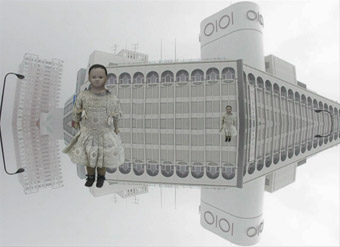
study for The Nest (2009), Sam James
When you work with other artists on their projects, how do you see your role?
With every artist I collaborate with it’s about our artistic relationship. Often status has something to do with it, but it’s usually much more than that. I am never a servant to another artist unless I specifically agree that my role is not to be creative. I always feel that if an artist is capable of making their own video, they should do it but, if they don’t know how to, then I do it. There are always relationships between the languages of performance and film and each performer’s approach to performance indicates which approach to the film I should take. Every show is a different process as well, so applying a constant aesthetic and mode to a performance I think is wrong. If there is artistic frustration in the collaboration, the answer is to get past it, to find what the work is about and see what the investigation gives us.
What are some of the key shows you have worked on with other artists?
Improlab with Tess de Quincey, Jim Denley, Amanda Stewart and Chris Abrahams (and others, 2006-8) was a series of totally improvised works which ended up being the most satisfying and challenging of events, the ultimate in collaborations. To work with such experienced and dedicated improvisors as Denley, Stewart and Abrahams with their fluid and beautiful sense of trust can’t be surpassed. Each says, you do what you want and I’ll do what I want and when we do it simultaneously it will either be beautiful or it will tell us where we are going wrong. There is no beginning and end to improvisation and it is impossible to encapsulate, it can only be a live experience. Improvisation is not always the best form of entertainment for an audience and there were varying degrees of success with the De Quincey Co Improlab tour. For example, sensitivity to the performing space for me was the key thing, using three live cameras, different lenses and analogue mixing, but The Studio at the Opera House, a place for presentation and entertainment, just wasn’t resonant.
Working with Hans Van den Broeck on Nomads in 2008 (RT90, p21) was a sudden and profound experience. Again, to work with someone with so much experience (a founding member of Les Ballets C de la B), an interest in psychology and huge energy and imagination, fuels your own energy to work. This was not an indulgent investigation but a boxing ring of ideas and tactics, drawing on each artist’s responses to tasks. One thing would lead to others. It was a risky piece and Hans had enough on his plate dealing with the dancers but he still had a mountain of video ideas he wanted to work out. In the two-day development period in Bundeena we shot about six hours of video performance ideas—most of which never made it into the show. But through that process I could see how he understood performance and video. That’s a crucial thing to find out fast if it’s the first time you are working with someone. Nomads took only two weeks to create but the speed of working, in combination with improvised video, seemed important, because these days, with limited funding, you have to work fast and very well to keep the work alive and to compete with the large scale works seen in festivals.
What is the relationship between your own work and the work you do with others?
Each work is an inspiration. I don’t know where this work has come from but someone has invited me to make work in it. It becomes, in the absolute sense, the world I am living in. I spend far more time in projects than I do anywhere else. Every time I go to a new project it’s a new tango, a completely new story. Sometimes the transition is hard if I start a new project the day after another finishes, but I think this adapting to new territory is nothing compared to, say, being a soldier in a war. I see the work as a filmmaker. The performer is the subject of the projected film, it is sculpted around them, where they travel. I learn from them as a filmmaker learns from their subject. I am part of their journey, and I try to illuminate their passage. Of course sometimes I don’t want to show too much, and performance delivers everything we need. But in terms of working with independent performers, the work is in progress and I help find the answers to their questions. To work alone is not so satisfying, I need other encounters to shape my path.
What is driving your own current project?
My next project is The Nest which has been commissioned by Reeldance to be part of Cinedans’ installation program in Amsterdam in 2010. I am using a process I’ve used before, which is to travel, filming new spaces in macro and microscopic scale with small digital cameras. All of these abstracted environments will become a space which I will link to certain dancers I’ve worked with. The main notion is that space is a series of interconnected links, like a nest. With conceptual forms similar to ant nest architecture, I am interested in making connections between these found spaces and people. The compositing and animation process is digging the tunnels, to try to make connections between subject and space, and also to make connections between them as newly invented, discrete entities. I’m using imagery mainly from Tokyo and Berlin and a prototype cut will be finished on a residency at GlogauAIR in Berlin in July this year. The performers are some of Sydney’s most independent and individually charismatic—Martin del Amo, Lizzie Thompson and Georgie Read—the film focusses a lot on their personas.
What is your relationship with technology?
Like many, I despise technology, but I embrace it because it is the dominant vice of society. In relation to media, everything must relate to it, or it doesn’t exist. It’s a flaw in humanity and the power behind our simultaneous success and annihilation. Film has magical power, sets of parameters and tools with which to attempt to express our dreams, but its power is hard to wield. My relationship to it is experimental: the results come from an outside force. It’s important to give in to the machine and the independent will of technology if you are a video maker, as important as it is to give in to another person’s life. The benefits are like travel: film can reconfigure and make impressions on the mind. Of course, film can also be escapist, but for someone who is not good socially, what a great escape! It makes the world seem bigger, more complex, yet reconfigurable. Its language helps me to make sense of experience by piecing it all together in the editing.I use compact mpeg video cameras for most of my capturing because it is immediate and real, and this format also has greater potential for animation, for me a great cross-over between worlds real and fantastic.
My collaborations are the most transient part of my work, lost in almost all aspects after the live act. Without the performance, performance video doesn’t really speak on its own. But it’s pushed my practice hugely towards the artifact and historical relic, the feeble and somewhat fractured and mythologised residue of something that was once great. Preservation of an event is another thing, it is possible to make it greater than the actual event, through nostalgia and distance things seem beautiful in their disappearance. I think this is also the real relationship to all this technology.
Sam James, https://shimmerpixel.blogspot.com/
RealTime issue #91 June-July 2009 pg. 44
© Keith Gallasch; for permission to reproduce apply to realtime@realtimearts.net
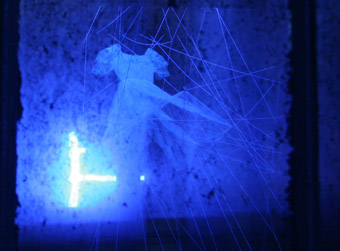
Night Songs
photo Cat Brennan
Night Songs
IN MICHAEL PATEN’S 2009 PROGRAM FOR THE CASTLEMAINE STATE FESTIVAL TWO SHOWS STOOD OUT AS NEW LOCALLY DEVELOPED HYBRID PERFORMANCE WORKS REACHING BEYOND THE ORTHODOXY OF THEIR FORM. BOTH NIGHT SONGS AND DINNER IN A DRY DAM WERE NURTURED IN SEEDPODS, PART OF A NATIONAL EMERGING ARTS INCUBATION PROGRAM DEVELOPED AND CURATED BY PUNCTUM INC, A CASTLEMAINE-BASED LIVE ARTS ORGANISATION.
Both shows work within a poetic medium to explore the tensions between, and destinies of, a husband and wife. However where Night Songs plunges into a vein of unknowing, Dinner in a Dry Dam discloses all its secrets before it begins. Where the former unfurls juxtapositions of loss and longing with a soulful impressionism, explicitly decentralising the narrativity of its text, the latter spells out its journey, baring all at the outset in a ‘dinner menu’ style program of convoluted Victorian era scene subtitles, then fixating on its central dilemma in an explicitly expositional text. It is perhaps a strategy to facilitate access for rural audiences less inclined towards the poetics of ambiguity.
Night Songs—a meditation on the triangulation of longing and love between a sailor, his sea widow and the open sea—reworks James Benedict’s original play, Aqua Lupus, in collaboration with visual artist Gabrielle Brauer, to re-emerge as a site specific multimedia installation beneath the Old Castlemaine Gaol.
An MP3 player provides each viewer with their own audio track so we may freely rove this fitting netherworld, as if in an ancient wreck awakening intimate memories of other people’s lives. At the bottom of a steep descent, tiny rooms are littered with fern-like forms or crisscrossed with a cat’s-cradle of string, some inhabited by almost tangible, lifelike human presences. I hear sounds of the sea and a dialogue about absence and presence. Each cell offers up a morsel of memory—projected phantasms exuding warmth, the woman who writes, the woman who waits in a womblike pod of shadow—each mockingly occluded behind sculptural white forms that shine luminously cold under UV light. Taut, angular lines of string hold captive a ghostly child’s gown, her memory caught up in the latitudes and longitudes of distance/connection or in the rigging of some vessel. Elsewhere her image points and laughs in endless repetition.
Drumming builds and a male voice describes a more external journey, his love for the sea, his longing for return, the letter he begins when the winds become still in some remote ocean. Besieged by a perilous calm, adrift on his own dreams, the unfulfilled adventurer is denied a triumphant return, his loved ones refused the satisfaction of a heroic battle narrative, the heartstrings connecting her life to his just slacken and ebb in a sinking oblivion.
Benedict’s text lilts eloquently toward its story, yet leaves it always partly submerged. The scenario resonates with the plight of war widows; of veterans lost to despair rather than to enemy fire; and with their would-be heroes, soldiers becalmed in a purposeless enterprise, the winds of a morally righteous crusade knocked out of their sails by a more cynical truth.
Punctum’s Dinner in a Dry Dam describes another case of an enterprise becalmed by weather patterns. In a drought-stricken rural community a sheep farmer and his ex-opera singer wife host a farewell banquet on the dam’s dry bed. The event occasions a domestic drama that pits pioneering tenacity against the creative courage to embrace change. At the core of this is the will to inflict death, a blood sacrifice of the last stud ram, for the sake of resurrection into new possibilities. For the farmer, as captain of this ‘vessel’, honour lies with his sinking farm, while his ‘first mate’ wife agitates for a break with the tradition of ‘going down with the ship.’
The starting point for this contemporary opera, described by director Jude Anderson as an elegy to the last great 200-year cycle between droughts, was to relate the tension between certain musical intervals to the dramatic tension between the couple. The libretto is the culmination of community interviews giving dramatic voice to the rural tragedies we often gloss over. Despite avant-garde sonic experimenting, humanity and drama snap sharply through the sparse team of mezzo-soprano, tenor and double bass. The fictional device of the opera singer helped to elevate the material, validating the use of high cultural form without alienating its primary constituency.
The church hall formally set for a banquet excited expectations by implicating us as guests but the material made us uneasy voyeurs to this bitter private struggle in which every development has been pre-empted by the ‘menu’ program. Nothing is left to experience afresh. We read, “I will then pick up a gun and leave. From beyond the dam banks you will hear a gunshot. That shot will mark the end of a bloodline. I will have killed our last remaining ram before walking off our property and closing the gate.” Indeed this outback Lady Macbeth prevails against her lord’s inertia, but with no great sense of transformation. And at the ringing out of her gunshot offstage we watch him—a blank, unflinching figure—in vain, for evidence this blood sacrifice will indeed prove a gift of life and not a living death.
While Night Songs immersed me in its amniotic fluidity, a balance of feminine longing and masculine yearnings both reaching for connections in a sea of uncertainty, Punctum’s Dinner progressed drily from a specifically located dischord toward an endpoint of decisive certainty and I am left wondering if the change has been suffered or truly embraced.
Night Songs, text James Benedict, installations Gabrielle Brauer, composer Tim James; Old Castlemaine Gaol, April 1-4; Dinner in a Dry Dam, director Jude Anderson, composer Carl Panuzzo, performers Carl Panuzzo, Penny Larkins, librettists Berni Janssen, Penny Sell, Emilie Collyer, Jude Anderson, design Ali McNicoll, lighting Grant Davis, video & sound artist Jacques Soddell; St Mary’s Church Hall, April 1-2, www.punctum.com.au; Castlemaine State Festival, March 27-April 5, www.castlemainefestival.com.au
RealTime issue #91 June-July 2009 pg. 45
© Indija Mahjoeddin; for permission to reproduce apply to realtime@realtimearts.net
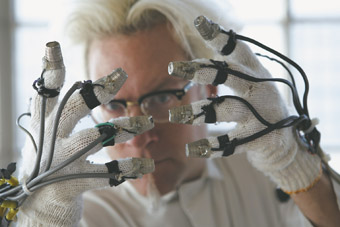
Marc Gunderson, The Evolution Control Committee
photo Brooke Buchanon
Marc Gunderson, The Evolution Control Committee
IN 1999 A GROUP OF RMIT STUDENTS PRESENTED A COLLECTION OF EXPERIMENTAL SOUND AND MUSIC EVENTS. TEN YEARS ON, THIS COLLECTION OF EVENTS, LIQUID ARCHITECTURE, HAS GROWN INTO ONE OF AUSTRALIA’S MOST SIGNIFICANT FESTIVALS WITH A NATIONAL TOURING PROGRAM OF CONCERTS, INSTALLATIONS AND FORUMS.
While there have been many contributing directors and collaborators, Nat Bates has been the mainstay for the entire decade. This heroic effort has allowed for consistency in both the quality and curatorial approach, however Bates is keen to point out that each Liquid Architecture is never purely his vision. “One of the key things for me is the team of curators. When we were a Melbourne only event there were a number of people I worked with [Bruce Mowson was co-director 2001-4, Camilla Hannan 2001-2] and now that it’s a national event I rely heavily upon the people in the other cities for input. That keeps it fresh and interesting, keeps me motivated, keeps me in touch with things that I’m missing. I’d feel very uncomfortable if it was purely my thing.”
Liquid Architecture started up a few years after What is Music? began challenging our senses. Over the last decade several other important festivals have also entered the landscape, including The NOW now. However Liquid Architecture has managed to maintain its own distinctive emphasis on national and international guests who offer historical perspectives on contemporary practices. Bates recollects that “in 1999, 2000, there was a lot of talk about new media but as a student I was learning that it wasn’t new, that there’s a history. So I was very keen to highlight established artists, who’d been working for a long time, alongside emerging artists. I think the festival has tried to do that continuously, whether it’s an international guest who has never been to Australia before and who has a decades-long career, or some particular practice or way of working that we want to highlight…This is tied in with the fact that the practices we’ve highlighted are still ongoing in some way. I’m not interested in doing retrospectives as such. So when Tony Conrad came out, he was still developing what he was doing in the 60s—it’s a living practice. It’s up to him whether he wants to play old works or present contemporary ones.”
Within this framework, the festival has always been diverse, covering a wide range of approaches to sound and music making. I asked Bates how this has worked for the event. “It’s been a struggle over the 10 years trying to establish a profile for the festival and to explain what it is. People wanted to pin ‘electronic music festival’ on us in the beginning and I was very reluctant to do that. We adopted the ‘sound arts’ label early on, which was contentious and difficult as well because there’s a lot of different understandings of what that is. Then we struck upon the idea of calling it a ‘sense-specific’ festival…The diversity in the programming is definitely a reflection of all the things that are going on, and not wanting to be narrowed down to a genre or particular area of practice. But it’s also a recognition that Australia has a small population—artistic communities are relatively small in number but we wanted to be broader than that and bring in as many communities as possible.”
What is unique about Liquid Architecture is the way the touring model has grown. The interstate elements of the festival are run by local directors who program their own concert series and events drawing on the international guests and adding locals into the mix. This year as well as Melbourne, Sydney, Brisbane and Perth, the festival will go to Castlemaine and Bendigo in regional Victoria, and Cairns in far north Queensland.” The truth is,” says Bates, “there’s got to be people interested [in this music] in all these places. Just because they live somewhere rural doesn’t mean that they’re not interested in things that happen mostly in the big cities. Part of the motivation for the festival is to provide opportunities for artists they wouldn’t get otherwise—to tour this kind of music and to play to audiences outside of the capital cities.”
I asked Bates to pick out a few highlights from the last 10 years of Liquid Architecture. Even though, like a proud father, he was reluctant to play favourites, he did cite a particular moment. “My number one highlight was Bernard Parmegiani playing in Melbourne, doing a speaker orchestra event, which is an area of personal interest to me. I never thought I’d get to see something that happens exclusively in Europe. It was amazing to meet him.”
It’s this meaningful connection with key artists that has kept Bates—an artist himself, like most promoters and organisers in this sector—forging ahead, despite the time it takes away from his own practice. “If I’m organising a show I get a real connection with [the artists]. First of all we have to talk about technical things: what gear do you need; how does this work; how do we orientate the space; how do we get an audience; how do we promote it. Just starting those conversations, it becomes a deeper artistic collaboration in a way.”
Liquid Architecture has previously operated under the auspices of RMIT, however it is now in the process of establishing itself as a separate legal entity. I asked Bates about the effect this is having on the future of the festival. “[In] some ways [the change] is motivated by asking how can we sustain what we’re doing, but it’s also raised the question of whether we should continue doing what we’re doing—should we be doing it differently? This is a very healthy thing but it does mean that there’s some uncertainty about whether or not the festival will continue in its current shape and form. But it’s got a very healthy base to build on and there are some things you just don’t throw out…Personally I wanted to start to formalise the informal ways that I’ve been working for 10 years in terms of the mentoring and advice that I get from various people…I’ve always relied on other people’s opinions. The Melbourne program is very much a collaborative effort. Local organisers and curators come to me saying ‘I want to do a series of shows, Can one of these be part of the festival and how can we fit them together?’ So I’m interested in formalising these making it clearer how we all work together.”
So what does the 10th Liquid Architecture have in store for us? Thanks to a partnership with the Goethe Institut, there is a strong German contingent. Asmus Tietchens offers the program’s historical context—his career started in 1965. With around 20 releases to his name, Tietchens remains an understated figure in the experimental landscape because his work does not adhere to any particular style or movement but instead is “simply the musical exploration of the studio, idea, or collaborative situation at that given time.” Particularly intriguing is the duo Kontakt der Jünglinge, which is Tietchens and another German guest, Thomas Köner, a renowned audiovisual artist with Golden Nica and Transmediale awards under his belt, who will also be playing solo sets. Also from Germany is Perlonex featuring Ignaz Schick (live-electronics), Jörg Maria Zeger (guitars) and Burkhard Beins (percussion) exploring the electroacoustic spectrum.
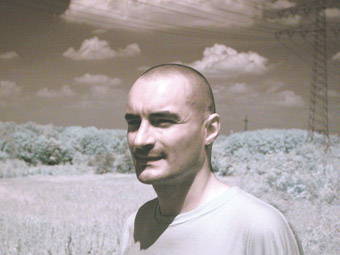
Thomas Köner
courtesy the artist
Thomas Köner
From the US comes The Evolution Control Committee led by Marc Gunderson (aka TradeMark G), plundering other people’s music to create whole new works and sticking it to the upholders of pesky things like copyright. Gunderson is credited with inventing the MashUp, in which two songs are slammed into each with surprising ramifactions. He is also credited with inventing the term ‘plagiarhythm’, which has made it into the dictionary and, through his software tinkerings, has created a musical interface, the Thimbletron.
Liquid Architecture has always featured exhibition elements and this year each of the major venues has something on offer. At the Brisbane Powerhouse there’s an exhibition by Eugene Carchesio and San Francisco-based media artist Scott Arford. Arford will also present work alongside Ruark Lewis, Vicky Browne, Lauren Brincat and the UTS instigated Memory Flows group at Performance Space, Sydney. Bendigo will present audiovisual installations by the Undue Noise Collective and Jacques Soddell. In Melbourne, WestSpace offers experimental instruments and installations by Alan Lamb, Dale Gorfinkel, Rosalind Hall and Peter Blamey along with Location Sound Films by Estonian artist John Grzinich. At Arts House, North Melbourne Town Hall, US/Swiss artist Jason Kahn will present Brown White Blue Pink, an installation using 4-channel audio disseminated over 40 two-inch speakers to explore the four colours of noise.
To have achieved a decade of consistent operation in the experimental music landscape is truly a remarkable achievement. With events across seven cities in 19 days for Liquid Architecture 10, it appears that enthusiasm from organisers, artists and audiences is strong and still growing and should do for another decade.
Liquid Architecture 10, national artistic and Melbourne director Nat Bates; Sydney, co-directors Shannon O’Neill, Jennifer Teo, June 24-27; Brisbane, director Lawrence English, July 3-4; Castlemaine, presented by ICU/Punctum, July 5; Perth, presented by Tura New Music, July 7; Bendigo, director Jacques Soddell, July 8-9, 23; Melbourne July 9-12; Cairns, presented by On Edge 09, July 12; www.liquidarchitecture.org.au
RealTime issue #91 June-July 2009 pg. 46
© Gail Priest; for permission to reproduce apply to realtime@realtimearts.net
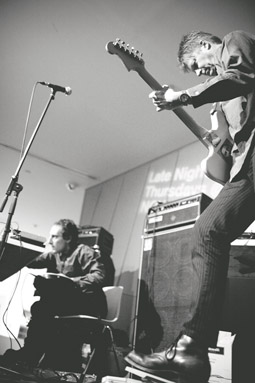
Oren Ambarchi, Nels Kline, Melbourne International Jazz Festival
photo Laki Sideris, www.melbournejazzphotos.com
Oren Ambarchi, Nels Kline, Melbourne International Jazz Festival
THE MELBOURNE INTERNATIONAL JAZZ FESTIVAL LOST ONE OF ITS STAR TURNS WEEKS BEFORE IT STARTED, WITH CECIL TAYLOR CANCELLING DUE TO ILLNESS. WHILE THAT’S AN UNDENIABLE BLOW, A STRONG FESTIVAL RECOVERS QUICKLY DUE TO THE OVERALL PROGRAMMING QUALITY; THIS EVENT, HOWEVER, FELT LIKE THE WALKING WOUNDED AFTER TAYLOR’S CANCELLATION. (WHY THEY DIDN’T ASK TAYLOR’S ACCOMPANIST TONY OXLEY TO COME REGARDLESS AND PLAY SOLO PERCUSSION IS BEYOND ME.) MY EXPERIENCE OF THE FESTIVAL WAS CHERRY-PICKED, I’M NOT ASHAMED TO ADMIT, BUT I’D LOVE FOR ONCE TO TURN UP TO ONE OF THESE FESTIVALS AND BE OVERWHELMED WITH CHOICE.
The festival for me started with a lock-out, unable to gain access to the Charlie Haden Liberation Music Orchestra, which had been moved from outdoors to BMW Edge due to inclement weather. My first encounter with artist-in-residence Haden, then, was the screening of Rambling Boy. It scored high for featuring some incredible footage of the Ornette Coleman Quartet in their element, but I couldn’t help but wish some of the choices of talking heads had been more inspired, and at points the film really lacked any kind of aesthetic backbone, relying too much on chronology and not enough on meta-musical content. More discussion of Haden’s place in the free jazz ferment of the 1960s and 70s would have been appreciated, for example. The question and answer session after the film could have pushed the discussion of the overlap of art and politics much further, particularly given it’s something Haden’s spent plenty of time addressing with the Liberation Music Orchestra.
Charlie Haden’s Quartet West played the following night at the Melbourne Recital Centre, a space that feels custom-designed for classical music. As such the sound left something to be desired, particularly Haden’s bass: it’s never a good sign when the star of the quartet you’re watching is mixed out of existence. Some of Quartet West’s music cloys, and the overarching theme of ‘music for film noir’ means things never really break into the feverish sweat I’m often after with jazz. But there were moments of revelation—a gorgeous rendition of Ornette Coleman’s “Lonely Woman” that slowly, almost deliberately, expounded on the melancholy at the heart of Coleman’s most enduring melody to great effect; and some of Ernie Watt’s turns on the tenor sax, particularly his solo in the first piece, which had my neighbour turn to me and proclaim, ‘it’s just like Slayer’—precisely the kind of cross-generic thought that should be brought to bear on a lot more of these shows.
Then to the National Gallery of Victoria on Thursday night, for their early evening ‘Art Chat’, this time with Oren Ambarchi and Nels Cline as willing victims. Question time with Ambarchi and Cline was like pulling teeth. While it’s hard to strike a balance between interrogation and openness, the questions felt remedial and stilted, and the answers were uninspired (if genial). The duo performance fared little better, partly due to Ambarchi’s immovability—one of the negative side-effects of so clearly defining your own aesthetic parameters is that it can be hard to break free of your own concepts and engage with your playing partner. And while there’s something to be said for the post-AMM, post-Keith Rowe ‘laminal’ approach to improvisation, where playing ‘parallel’ to those you share the stage with can provide some more intriguing outcomes than the traditional combative or ‘call-and-response’ modes of improvising, it didn’t work here, and Cline’s entreaties to coax Ambarchi out of his shell were met with paralysis.
Nels Cline’s solo set supporting the Laughing Clowns fared better, if only because it allowed him the chance to move through ideas at his own pace. But there’s something slightly unappealing about the phantasmagorical element of Cline’s playing; his preparations and FX get in the way of the internal logic and credibility of his performances, such that you walk away feeling his aesthetic has been defined by his tools, and not vice versa. This is surprising, given the richness and individuality of Cline’s music with the his trio or Carla Bozulich and Wilco. While he’s not overawed by his kit, he’s sometimes over-determined by it—that the moments where he plays it straight lapsed into clichéd jazz noodling or limp post-rockisms are, however, all the more puzzling. You risk being called a traditionalist within certain circles these days for asking a guitarist to play their instrument ‘properly’, but that’s where Cline really excels, and it’s a shame to have caught him in less than inspiring form.
If a lot of the Melbourne International Jazz Festival felt tentative, or ill-conceived, it seemed appropriate that Australia’s Laughing Clowns should sweep in from outside of jazz and completely own The Forum’s stage—indeed, this was final, irrefutable proof that we’re dealing with rock at its best, not ‘jazz-rock’ or ‘jazz-punk.’ If anything, what the band achieves is the kind of group solidarity at a meta-level that great jazz groups aspire to and occasionally reach—that’s their lasting relationship with jazz; it’s nothing as base as generic similarity. There’s a barely constrained fury at the heart of songs like “Everything That Flies” (the set’s stand-out) which I’d only caught glimpses of at Sydney’s All Tomorrow’s Parties. More surprisingly, the way their group-mind unfolds has me thinking more of noise artists like Borbetomagus or Wolf Eyes—a surprising outcome, but the way they translate their energy into almost uncontrollable streams of white light recalls the most rock-reverent noise groups I’ve seen or heard much more than any of Kuepper’s supposed ‘peers.’
I guess that, structurally, finishing with the Laughing Clowns made sense—save the best ‘til last, go out with a bang etc. But I left the Melbourne International Jazz Festival with a fairly sour taste in my mouth, largely because the opportunity of programming some genuinely provocative, risky shows was squandered. This is not a simple-minded call for more avant garde music. Truth be known, the problem wasn’t even that both ‘streams’ (mainstream and underground) were under-catered—it was that you could coherently read these streams in the program in the first place. What happens when you throw away these archaic notions, when the rule book goes missing? We’re probably going to have to wait a lot longer to find out.
2009 Melbourne International Jazz Festival, various venues, Melbourne, April 26-May 2
RealTime issue #91 June-July 2009 pg. 48
© Jon Dale; for permission to reproduce apply to realtime@realtimearts.net
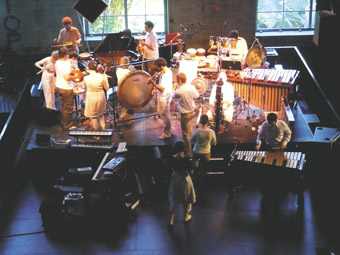
Queensland Conservatorium New Music Ensemble performing Ylem
photo Sharka Bosakova
Queensland Conservatorium New Music Ensemble performing Ylem
KARLHEINZ STOCKHAUSEN IS THE UBER MYTHIC CULTURE HERO. CHILDHOOD IN POVERTY, TEENS IN A NAZI YOUTH CAMP WHERE “EVERYTHING WAS ORGANISED…EVERY TOOTH, EVERY FINGERNAIL…”, HE MADE IT THROUGH WWII TO BECOME THE WUNDERKIND OF POST WAR COMPOSITION, RESHAPING MUSIC AGAIN AND AGAIN WITH RUTHLESSLY FOCUSED CONCENTRATION AND A MONASTIC WORK ETHIC. (TYPICAL STOCKHAUSEN WORKDAY: UP AT 5AM, GO TO MASS, WORK IN THE STUDIO UNTIL 7PM, GO HOME AND SKETCH OUT SOME IDEAS UNTIL 11, SLEEP, UP AT 5, GO TO MASS ETC ETC YEAR IN, YEAR OUT).
Then the story changes, he went a bit crazy-like, thought he came from outer space, descended into a megalomanic black hole and spent the next 30 years writing a grandiose opera, Licht, before delivering a final masterwork the day before he died. Make a great movie, the genius writ large then low. Some of it might even be true.
Jump to Clocked Out presenting an afternoon of Stockhausen in a free concert at the Powerhouse in Brisbane. The works go from Kontakte (1959) up to Octophonie (1990/91). Good crowd. Excellent performances. Great explanatory introductions to all the pieces from the engaging Stockhausen scholar Richard Toop.
Kontakte, for piano, percussion and electronics is a highlight. Originally designed to have performers improvising to four channel electronics, Stockhausen was unhappy with rehearsals and replaced the improvisation with specific instrumental parts to tighten up the sound play between performers and electronics. The performance by Ensemble Offspring and Jeffrey Hannam is precise and energetic. Gestures bounce sharp and fast between percussion, piano and tape. Form and theory, surface and structure, everything at every scale is smoothly coupled in a single movement of 35 minutes. (Stockhausen favoured single movements saying if he wanted to present two ideas he’d compose two pieces.)
Then Ensemble Offspring improvise with Pimmon to show Kontakte musically “in the context of the here and now.” But the problems with improvisation that Stockhausen found all those years ago reappear in the limited interplay between acoustic performers and laptop manipulations. Sharing novel and complex gestures is difficult unless the performers have many hours playing together or the genre is tightly constrained. Improvisation becomes restricted to the simpler task of exchanging and layering textures rather than developing musical gestures. This restriction drives the overall dynamics into a relatively static/ambient regime, unlike Kontakte which has enormous variety in dynamics.
A structured improvisation like Barrett’s Codex IX for the Elision ensemble sounds much more akin to Kontakte—Barrett could build in performer/performer interaction because of his many years of association with the musicians. This close connection between composer and ensemble is how Stockhausen worked throughout his career—he was always involved as performer or conductor and repeatedly rewrote works based on the experience of performance and rehearsal.
Move forward to 1972 and Ylem (played by the Queensland Conservatorium New Music Ensemble) presents Stockhausen as formalist system builder and believer in the paranormal. Ylem “best succeeds when the players establish telepathic communication with one another” (Stockhausen). The work is structured as an oscillation—out, in, then out again. Performers begin in a tight group then walk outward through the audience, return, move out again. Notes begin clustered then spread wider in pitch. Tempo starts fast, gradually slows. The effect is of time slowing down rather than notes being played differently. The process reverses, begins again. The final section has the performers moving beyond the audience and out into the space. It is as though we are observing a ritual, as though the performance is for performers rather than audience. It works beautifully and when the performers leave it is like being left alone rather than coming to the end of a piece—the music has moved over us and away.
Ylem is part of a substantial number of text and graphic scores where Stockhausen abandoned the extreme micro-control of sound structure found in Kontakte and focussed on the performer’s relationship to creating. Composing for behaviour rather than sound—or in conjunction with sound—has developed considerably over the last few years as composers write bio-behavioural models in software which then interact with live performers. Works such as those by Luke Harrald and others working with “live algorithms for music” (http://homepage.mac.com/oobop/lam/index.htm) can be genuinely musical. Fifty years ago Stockhausen had to abandon his original idea for Kontakte—performers spontaneously interacting with sounds-on-tape. Now, the computer (as person) interacts back.
Clocked Out, Stockhausen: a message from Sirius, Queensland Conservatorium New Music Ensemble; Ensemble Offspring; Pimmon; Michael Fowler; Jeffrey Hannam, Ben Marks, Tristram Williams; Brisbane Powerhouse, April 25
RealTime issue #91 June-July 2009 pg. 50
© Greg Hooper; for permission to reproduce apply to realtime@realtimearts.net
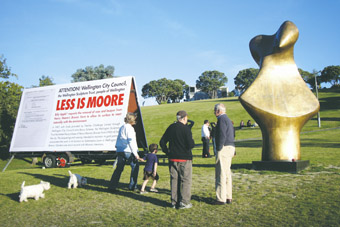
Billy Apple, Less is Moore, Wellington, 28 March 2009. Commissioned by Adam Art Gallery for One Day Sculpture
photo John Morrison
Billy Apple, Less is Moore, Wellington, 28 March 2009. Commissioned by Adam Art Gallery for One Day Sculpture
REALTIME MIGHT SEEM AN UNLIKELY CONTEXT FOR EXPLORING APPROACHES TO SCULPTURE, PHENOMENOLOGICAL PERSPECTIVES ON THE VIEWING EXPERIENCE NOTWITHSTANDING. HOWEVER, THE YEAR-LONG PROJECT ONE DAY SCULPTURE THAT HAS BEEN UNFOLDING ACROSS NEW ZEALAND SINCE JUNE 2008 OFFERS AN EXPANSIVE INTERPRETATION OF THIS GENRE FOCUSED ON PERFORMATIVITY, TRANSIENCE, DISPERSAL AND INSTABILITY.
Conceived by UK-based curator and theorist Claire Doherty, One Day Sculpture is a collaborative production with the Litmus Research Initiative at Massey University in Wellington, directed by Australian David Cross. According to Doherty, it is explicitly “not an exhibition”, but operates instead as a platform for a series of discrete works to be commissioned and considered in relation to an overarching set of ideas concerned primarily with duration and place (Curatorial Statement, http://www.onedaysculpture.org.nz). In turn, One Day Sculpture has initiated a network of partnerships with local institutions and independent curators across the country, devolving responsibility for commissioning and delivering much of the series. By the time the program winds up mid-year, 21 enormously diverse projects by international and local artists will have been staged, each within their own 24-hour time period, at venues spanning Wellington, Auckland, Christchurch, Taranaki and Dunedin.
In association with the commissioning series, a two-day symposium was held in March that sought to tease out the relationship of the project to current discourses and, in particular, the intersection between performativity, place, temporality and collaboration where One Day Sculpture largely resides. The symposium program was arranged as a series of four sessions within which a number of concurrent activities took place, such that the experience mirrored the partial and contingent encounter of a temporary, place-responsive artwork. Likewise, within the commissioning series, the dispersal of the program across a 12-month period and between different social and geographic locations has ensured an in-built itinerancy, which reflects the broader circulation of artists, curators and audiences between sites that is a significant effect of place-based commissioning practices. Both of these strategies point to the research interests of the project: its focus on sculpture as an activating agent within the public sphere, and attention to the related challenges of finding responsive ways to present work of this kind and articulate its impacts.
In his position paper on the symposium’s first day, Dr Mick Wilson broached these themes by reflecting on the experience economy in which temporary art events circulate. Wilson addressed the ways ‘the public’ has been conceptualised within site-responsive art practices over the past two decades and considered the impact of market forces on how such works function in the public sphere. Within a context where art is now frequently instrumentalised for the purposes of city branding, urban renewal and cultural tourism, Wilson proposed a rethinking of how we consider the ‘public’ within this schema. Drawing on the philosophy of Giorgio Agamben, Wilson suggested an understanding of the public not as an already existing body of subjects ‘in-common’, but as temporally produced by the artwork and constituted only by those to whom it matters; for whom it disrupts the continuity of experience and in doing so creates a shift in consciousness. This logic effectively works against an understanding of the public of place-based artworks as being represented, and proposes instead that it is through contact with the work that a public is created.
Documentation, in print and online, during and after the experience of these works, might play a significant role in evolving a public. Billy Apple’s billboard project Less is Moore, staged March 28 in the Wellington Botanic Gardens, subtly engaged with this idea by problematising the notion of a direct encounter. Simultaneously playful and incisive, Apple’s work was erected on the Salamanca Lawn next to a permanently installed bronze sculpture by Henry Moore, with which it formed a dialogue. Moore’s sculpture, titled Inner Form, was donated to the City of Wellington in 1988 and, at the time, the wishes of the artist were made clear in a fax that addressed the treatment of the sculpture’s surface. More than 20 years later, Apple used his own sculpture as a mechanism for directing attention to Moore’s, reproducing the fax in full alongside a cheeky declaration that the City had undermined Moore’s artistic intentions by applying a protective lacquer and wax to its surface as a means of maintaining the sculpture’s gold patina. Alongside Apple’s request to remove the protective layer on Inner Form and “allow its surface to react naturally with the environment”, the reproduced (and massively enlarged) fax attested to the City’s deliberate resistance on this account.
While the overt theme of Apple’s work might be considered ethical – exploring the impact of institutionalised frameworks on artistic intention and audience reception – Less is Moore also worked to unsettle a clear delineation between immediate and mediated encounter. Standing before Moore’s sculpture in 2009 with Apple’s billboard alongside, it became apparent that the Inner Form being experienced was stuck in a time warp, frozen in its virtually pristine original form. Since its deteriorated surface could only be imagined via the notations in the reproduced fax, the decades since its installation were collapsed. At the same time, the impervious, shiny protective layer that separated the audience literally and metaphorically from Moore’s sculpture undermined the idea that this present-day encounter was couched in the integrity of situated contact.
Apple’s concern with a dynamics of artwork-audience exchange was echoed at the symposium in Berlin-based theorist Jan Verwoert’s paper regarding the ways temporary art projects invoke a cycle of expectation and delivery. On the second day, Verwoert spoke to how temporary site-responsive projects interface with an increasingly pervasive event culture. Developing out of the question “What is it we expect from such work?”, he teased out the dynamic of anticipation and actuality in which the capacity to deliver an event, to be ‘eventful’, becomes a measure of an artwork’s accomplishment and shapes an audience’s willingness to engage. Proposing that artists can undermine this logic by resisting the pressure to produce something spectacular, Verwoert turned our attention to the values inherent in work that is overtly uneventful and un-monumental.
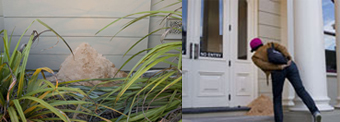
Roman Ondák, Camouflaged Building, Wellington, 27 March 2009. Commissioned by Litmus Research Initiative, Massey University for One Day Sculpture
photos Stephen Rowe
Roman Ondák, Camouflaged Building, Wellington, 27 March 2009. Commissioned by Litmus Research Initiative, Massey University for One Day Sculpture
Roman Ondák’s project, Camouflaged Building, which took place on March 27 at the site of the Old Government Building on Lambton Quay, reconciled effortlessly with Verwoert’s proposition for public intervention as non-event. Designed in an Italian Renaissance-style and erected on land reclaimed from the sea, the Old Government Building is made entirely from native New Zealand kauri and is the largest wooden building in the southern hemisphere. The structure is emblematic of colonial conquest and exemplifies pretence; the painstakingly carved timber appears as stone and has been subsumed into an overbearing narrative of Eurocentrism.
Ondák’s sculptural intervention comprised a handful of unassuming sawdust piles that were installed around the exterior of the building, pressing up against its facade. The piles hovered ambiguously between the suggestion of construction excess—thus drawing attention to the material of the building—and the opposing notion of deterioration, as though termites were surreptitiously corrupting the architecture’s domineering sturdiness. Ondák’s work operated as a subtle interruption to the daily order within this space, in which the certainty of permanence was revealed as a fiction, just as the building presents itself as something it is not. It demanded of its audience an element of attentiveness and exploration, though it delivered very little by way of something to physically examine when it was found. For many people who moved through the site on the day, Camouflaged Building was so restrained it might have passed unnoticed.
Of course, for a major audience contingent, the site was treated as a destination and the prospect of not noticing Ondák’s work was undone on account of knowing it was there and going specifically to bear witness. On the day, the sight of clusters of knowing art spectators peering intently at the sawdust piles seemed to highlight the difficulty of reconciling some of the more compelling perspectives expressed at the symposium with the pragmatics of the One Day Sculpture undertaking. The value of uneventfulness as a strategy to resist embedded audience expectations, and the ideal of maintaining a critical distance from the experience economy, for instance, played off against a highly visible and savvy marketing campaign around Wellington urging people not to miss the current projects with the strap line: “Here today, gone tomorrow.”
Likewise, the symposium’s inherent reliance on secondary documentation as an avenue for providing access to a range of works from the series was under-investigated—at least in this reviewer’s experience—in relation to how the publics of a project positioned as practice-based research might themselves be accessed and articulated in empirical terms. Wilson’s notion of the public as formed through contact with a work, rather than being represented by it, is certainly persuasive. But it raises the significant question of how the impacts of an artwork on a radically abstracted public might be accounted for and not just assumed or imagined, both in the immediate aftermath of a project’s presentation and over time. This topic was left virtually unexplored during the symposium, though perhaps it will surface in the research publication to be released after the commissioning series draws to a close. Whether this is addressed in the project’s public archive will be a telling measure of the extent to which One Day Sculpture has really explored the potential for temporary, place-responsive artworks to engage new publics in new ways outside of conventional art frameworks.
One Day Sculpture: An International Symposium on Art, Place and Time, concept Claire Doherty, convened by Litmus Research Initiative, School of Fine Arts, Massey University, Wellington, New Zealand in conjunction with the Museum of New Zealand Te Papa Tongarewa, March 26-28; www.onedaysculpture.org.nz
RealTime issue #91 June-July 2009 pg.
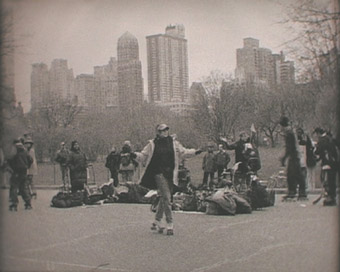
Laresa Kosloff, Sensible World, Artspace, Sydney, 2009
WHILE NOT PART OF A THEMATICALLY LINKED EXHIBITION, THESE THREE DISTINCT INSTALLATIONS ALL EVOKE A SENSE OF NOSTALGIA FOR A TIME OF SIMPLER TECHNOLOGY, PURER ARTISTIC PROJECTS AND MORE HUMAN-SCALE MODES OF REPRESENTATION. TOGETHER, THE MATERIALS AND FORMAL LANGUAGE THE ARTISTS USE, FROM EARLY MODERNIST ABSTRACTION TO SILENT CINEMA TO OBSOLETE VISUAL APPARATUS SUCH AS SLIDE PROJECTORS AND SUPER 8 FILM, SUGGEST A RESISTANCE TO THE GLOSS AND GLITZ OF 21ST CENTURY MODERNITY AND ITS THOROUGHLY MEDIATED SPACES; RATHER, THEY BETRAY A DESIRE TO TEND ONCE AGAIN TO THE VULNERABILITY AND LIMITATIONS OF THE HUMAN BODY AND HUMAN AGENCY. THAT FOCUS ON THE BODY IS UNDERLINED BY THE STRONG INVOCATION OF PERFORMANCE THAT THESE WORKS ALSO SHARE.
Laresa Kosloff’s Sensible World comprises four silent videos projected on small flat screens suspended from the ceiling. Kosloff has been documenting snippets of social interaction in public spaces for some years. Here she has juxtaposed glimpses of Central Park roller-bladers, jog-a-thon competitors, urban trapeze artists and a laughing club meeting around a fountain. Each video has been shot on Super 8, the technology that made the first home-movie possible, then transposed to DVD, three in black and white; each retains the graininess of the original medium, together with its nostalgic glow and analogue warmth. The uniform format, absence of soundtrack and faded documentary/home-movie aesthetics effectively de-contextualise the images from their specific time and place, rendering them equivalent. We are encouraged as viewers to look for the similarities in the scenarios: the way choreographed movement intersects with the cultivation of group identity and belonging, the way shared performance can positively claim pubic space, the way the idiosyncrasies of self-expression rely on drilling a common physical language. The images activate a tension between conformity and individuality, social control and its evasion, and the role of the performing body in negotiating this fine line. Yet the work ultimately affirms the ability of the individual and the casual group (as much as the artist) that each ‘performs’ in unexpected ways to resist the colonisation of public space by vested commercial and political interests. Moreover, the apparent ‘timelessness’ of the footage checks our instinct to treat this ability as quirky nostalgia.
Kosloff has in the past collaborated with Alicia Frankovich, and it is easy to see why, given their work shares certain sensibilities and concerns, both engaging with low-tech media and the poetics of the human body. Performance is integral to Frankovich’s practice, whether explicitly enacted or implicitly referenced. In part this comes from her background as a competitive gymnast. As a strict regime that openly aims to discipline the body and construct it in as technically perfect a form as possible, gymnastics is a powerful metaphor for the subtler injunctions to perform and conform that our bodies suffer everyday in contemporary culture. Frankovich’s performances, recorded on video and projected small-scale at floor level onto obsolete technological hardware, are reminiscent of seminal video-as-mirror works such as those by Bruce Nauman and Vito Acconci, where the artists recorded the banal minutiae of their studio routine, or observed their endurance of absurd physical rituals.
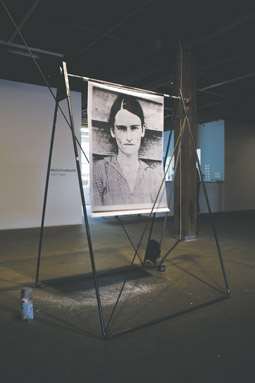
installation view, Alicia Frankovich
photo Silversalt
installation view, Alicia Frankovich
In the most compelling component of this installation, Frankovich has constructed a simple metal armature that brings to mind the uneven bars, complete with gymnast’s chalk. Here she has suspended a poster-sized photocopy of Walker Evans’ portrait Alabama Tenant Farmer Wife [Allie Mae Burroughs] (1936), an icon of both the Great Depression and activist documentary photography, made doubly famous by Sherrie Levine’s appropriation of it in After Walker Evans (1981). In Frankovich’s version, the image vibrates as the metal apparatus squeaks in a semblance of old-fashioned hand-cranked copying; the image is condemned to be endlessly copied to retain its acuity, just as a gymnast is condemned to endlessly drill her routine. Yet, as in Kosloff’s work, the low-tech aesthetics serve to remind us of the possibility of (manually, literally) intervening in the transmission of mainstream meanings.
Shane Haseman’s installation also makes reference to the potential of art to offer a counter-discourse; he borrows both the language of utopian modernist abstraction (especially Malevich and Rodchenko), and the title of The Rolling Stones’ 1968 hit “Sympathy for the Devil” that enveloped the band in allegations of devil worship given the song’s portrayal of Satan as “a man of wealth and taste” who playfully toys with mortals’ puzzlement at “the nature of [his] game.” Haseman’s work might be described as a tasteful puzzle. Despite being painted on cardboard, that quintessentially throwaway material, there’s nothing cack-handed about Haseman’s radically reduced abstracts. They are meticulously rendered and arranged along the gallery walls with geometric precision, propped up by poles that recall home-made protest signs. The gridlock in which the images are held belies their potential to liberate imaginings of alternative societies with their ground zero aesthetics. To crack the puzzle may require upturning this order, animating these symbols with the messiness of bodies that might ‘perform’ them in public. Yet the visual language remains exhausted and largely mute, such that the work adds little to the re-deployment of modernist abstraction by artists such as John Nixon and his acolytes.
A sense of small-scale, very human resistance to the lightning-speed, high-tech vision of contemporary culture permeates these works. They insist on the presence of the human body and the importance of the hand-rendered; they accentuate the continuing potential for transformation in the minutiae of everyday life. In particular, watching Kosloff’s grainy glimpses of social interaction in public spaces, we are moved by the integrity of human beings—incarnated both in the anonymous figures who roller-skate or laugh in public, and in the artist herself—who in their modest gestures pursue their Sisyphusian quest to render the world meaningful.
Laresa Kosloff, Alicia Frankovich, Shane Haseman, Artspace, Sydney, April 24-May 23
RealTime issue #91 June-July 2009 pg. 50
© Jacqueline Millner; for permission to reproduce apply to realtime@realtimearts.net
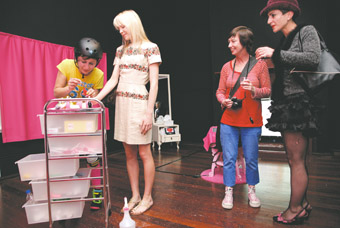
Tanya Visosevic with visitors to Cuticle
photo Justin Spiers
Tanya Visosevic with visitors to Cuticle
THE INTIMATE WORLD OF THE SUBURBAN NAIL SALON IS THE SUBJECT OF WEST AUSTRALIAN PERFORMANCE AND VIDEO ARTIST TANYA VISOSEVIC’S SHOW AT THE FREMANTLE ARTS CENTRE. WHILE THE TITLE, CUTICLE, DESCRIBES THE FINGERNAILS AND TOENAILS THAT DRIFT ACROSS THE SCREENS OF VISOSEVIC’S VIDEO WORKS, THE SHOW ALSO SUGGESTS THE SECOND MEANING OF THE TERM, THIS BEING THE SHELLS OF INSECTS. DIGITS ARE INDEED DETACHED FROM THE BODY, PERFORMING LOOPED ROUTINES WHILST CUSHIONED ON PINK SPONGES AND WHITE COTTON. THEY HAVE A LIFE OF THEIR OWN HERE, AS STARS OF VISOSEVIC’S SCREENS, TO PRODUCE UNCANNY EFFECTS.
Visosevic’s choice of soundtracks is symptomatic of this interest in the strange: Roy Orbinson’s In Dreams (1963), The Carpenters’ Close to You (1970) and Blondie’s In the Flesh (1976) have long been appropriated by cult filmmakers and musicians to evoke the strangeness of American suburbia. Here these dreamy songs ease our way into experiencing the other-worldliness of the show, as does an overpowering smell of cosmetic chemicals, and pink curtains that filter the sun into dim, pastel light.
Looming over the space is Fantasy Nailed, the projection of a diamond studded nail that dissolves into blurs of starry light. Through a series of video-era wipes, the effect is repeated to dazzle its viewer with the spectacle of diamonds and silver light. Yet this is an exception to Visosevic’s series of very small video screens that require us to lean close in order to peer into them. One is placed inside a handbag, another rests upon a child’s pink stool and a third lies in the drawer of a dresser. Their scale invites a certain intimacy, yet their scenes are disturbing, as performing fingers and toes encounter scissors and nail brushes, fluorescent varnishes and, in Pulsating Pink, a hammer-like movement of the camera that appears to break a nail. The seductiveness of the nail salon, its pink and white light, its promise of softness, is ruined as fingers are mutilated and distorted by Visosevic’s expert video manipulations. All this while the voice of Karen Carpenter echoes through the salon-gallery: “Just like me, they long to be, close to you.” The Carpenters’ classic appears obscene rather than innocent, a prelude to something sinister.
In an untitled work that first greets the visitor, a gloved hand reaches across the screen but stops, its fingers slowly curling into the palm. Cut to a sign on-screen that reads “Ring for Service”, but the hand cannot accept its invitation. Hand and sign are looped into an endless hesitation, an infinite regress of uncertainty. Is this because, like Rene Magritte’s pipe in The Treachery of Images (1929), there is no bell off-screen, but only this sign of a bell? This story will never resolve itself. Like a broken DVD we are destined to experience only this moment, this fragment, the rest of the tale forever hidden from us.
Visosevic’s performance of subtle uncertainty becomes the viewer’s own uncertainty in Candy Forever and Emergency. Candy Forever is a mobile phone video, available for visitors to download. A mouth sucks on a middle finger before it appears from between the lips with a green nail, sticking up as if to suggest the owner has given us the birdie, or to tempt us with its strange eroticism. The choice of the middle finger in Emergency Red also turns from seduction to aggression. Situated inside a dresser drawer, cushioned by cotton wool, the video shows a middle finger intercut with titles that recollect a daytime soap opera, a pink lollipop and Visosevic herself in a garishly decorated sadomasochist mask and pink dress. One of her fingers beckons while another urges us to be quiet, appearing to whisper to us some secret that lies within the nail salon, but which we cannot hear.
The montage is on the one hand erotic and on the other perverse and sadistic. It recalls David Cronenberg’s Videodrome (1983), in which footage of Deborah Harry’s lips merge with a television, inviting James Woods to merge with the ‘new flesh’ of the Videodrome universe. So too Visosevic’s invitation to join us on the other side of the screen, inside the fantasy of the nail salon, is at once a temptation and a perversion. The nail salon, ostensibly the subject of the show, is but a window into concerns about the perverse qualities of the screen and the life of digits themselves.
Tanya Visosevic, Cuticle, Fremantle Arts Centre, April 7-May 24
RealTime issue #91 June-July 2009 pg. 53
© Darren Jorgensen; for permission to reproduce apply to realtime@realtimearts.net
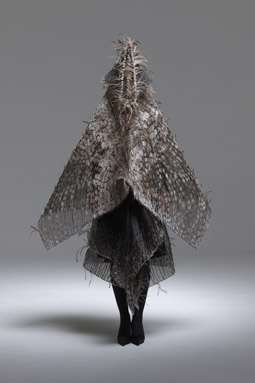
Ruana 2008, Lambda print on photographic paper, Emu Wear, Maria Fernanda Cardoso, GrantPirrie, Sydney
image courtesy GrantPirrie
Ruana 2008, Lambda print on photographic paper, Emu Wear, Maria Fernanda Cardoso, GrantPirrie, Sydney
THERE’S NOTHING QUITE LIKE A GALLERY CRAWL TO TAKE YOU OUT OF YOURSELF. ASSUMING MULTIPLE PERSPECTIVES OVER A SHORT SPACE OF TIME OPENS THE MIND TO ALL SORTS OF POSSIBILITIES.
Case in point. Who would have thought to take the components of an emu and reassemble them in a hybrid exhibition of sculpture, photography and exotic garments? Well, this idea has kept the ever-inventive Maria Fernanda Cardoso busy for a couple of years (2006-2008) and culminated in the surprising exhibition, Emu Wear at GrantPirrie Gallery in Redfern [p3].
Entering the gallery is like stumbling upon a sombre place of ritual or homage. At first you gaze in wonder at the garments on display, marvel at the immense variety of tone that exists within a palette of browns and greys. Then you’re struck by the sheer ingenuity of the artist’s intervention, the intricate weaving and shaping of variously sized and shaped feathers into capes, hoods, undergarments (!). Glamour glowers at the bird’s own mundane appearance. Unsettling sensations creep in. An eviscerated emu appears on a plinth, elsewhere a pair of preserved feet and legs hang from the ceiling, others are fashioned into the shape of boomerangs. Thoughts of the birds’ demise niggle. The large, stately photographs on the wall are telling. As if standing in for the artist, serious young models invoke a blend of faux indigeneity, ironic fashion statement and something else besides. Enveloped in the plumage of this ancient creature, they gaze inward or peer out at us from the other side.
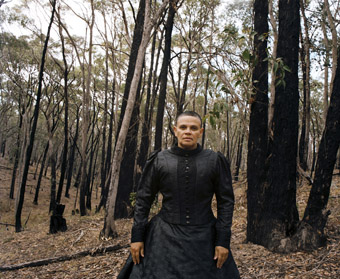
from triptych PolesApart3, 2009; c-type photograph, r e a, BreenSpace, Sydney.
images courtesy of the artist
from triptych PolesApart3, 2009; c-type photograph, r e a, BreenSpace, Sydney.
For different reasons, the same unsettling sensation is sustained at BreenSpace in media artist r e a’s PolesApart. Again, we enter a room of large photographs. Though it’s small, we might be in a gallery of McCubbin’s and Streeton’s. In this series of commanding triptychs, a narrative unfolds. Amidst a burned bush landscape, the artist appears wearing a black crinoline that might suggest mourning or service, perhaps both. Her hair close cropped, feet hidden beneath the dress, she flees from an unseen pursuer, glancing around her as if threatened from all directions. In one image she sinks to the ground, her dress ballooning around her. In another she hovers uncertain behind a tree. A small but imposing figure, she is dwarfed by and sometimes disappears altogether amidst the bleak grandeur of blackened tree trunks. In the adjacent darkened room, a video projected onto one wall completes the narrative suggested in the still frames. As the artist runs through the trees, moving furtively into frame, she is violently doused in red, white and blue paint by her unseen antagonists.
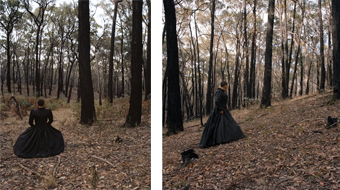
panels 1 and 3 from triptych PolesApart 2, 2009; c-type photographs, r e a, BreenSpace, Sydney
images courtesy the artist
panels 1 and 3 from triptych PolesApart 2, 2009; c-type photographs, r e a, BreenSpace, Sydney
The detailed exhibition notes by Dr Christine Nicholls discuss the work’s many references, in particular the experience of the artist’s grandmother and great aunt who were both stolen from their families in 1916 to be trained as maidservants. One escaped from servitude and returned home, the other worked for a time as the personal servant to Dame Nellie Melba and never again found her family. The choice of Daylesford in Victoria as the location for the images connects with the artist’s underlying research into the Heidelberg artists who worked nearby but “simply did not see the Indigenous presence in that country—Indigenous people were invisible to them.”
The artist takes colonial and art history, personal memory, painful lived experience and distils them into a powerful exhibition, which expresses the frustration and anxiety of living in a country that refuses to truly acknowledge its indigenous history and heritage.
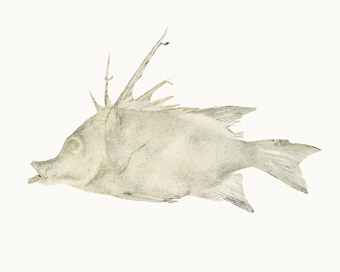
from The Summer of Us, Narelle Autio
courtesy the artist and Stills Gallery
from The Summer of Us, Narelle Autio
Finally when my visual appetite is almost sated, Narelle Autio’s The Summer of Us at Stills Gallery revives the senses. Once again, this photographer whose element is the sea, displays her serious regard for its power and poetry. The gallery is ablaze, white walls displaying a multitude of coloured objects photographed against more shiny white. Gathered by the photographer over one summer from beaches near her home in Adelaide, an accumulation of objects appears at first a taxonomy of refuse. Autio has transferred flotsam and jetsam to her studio and photographed each item in loving detail, using large format film and a light table. Retaining the patina of its age, the depth of detail in its edges and crevices, she turns each piece of trash into a glowing treasure.
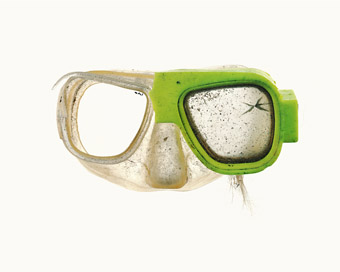
from The Summer of Us, Narelle Autio
courtesy the artist and Stills Gallery
from The Summer of Us, Narelle Autio
Beyond the glare, the pleasures of profusion, the delicate detail enhanced by the photographic process, vision floats. The room becomes a mind or a memory in which you venture connections. Clothing, bottles, toys, tyres, technology’s tacky remains are all in a process of conversion and disappearance. You observe the subtle shifts of nature (fish to sand sculpture, glove to flowering seaweed) whether converting its own familiar materials or appropriating humanity’s remnants. Noble in death, the corpses of birds and fish are preserved in salt and sand. Art approaches science. Autio, curator of everyday spectacle, lays out her evidence in multiples—comparing shark eggs, crab claws, anemone shells, fishing lures. There’s so much to see here that, my head swimming, I have to be dragged away.
At the end of the day, as they say, after this series of shape-shifting experiences, there’s an uncanny sense of resonance and a strange kind of coherence. Historical, zoological, political, personal and anthropological merge in what has been an unexpectedly magical mystery tour.
Maria Fernanda Cardoso, Emu Wear GrantPirrie, Redfern, April 30- May 23; r e a PolesApart, BreenSpace, Waterloo, April 3-May 2: creative team: co-ordinator/director Gail Kelly; designer Amanda Fairbanks; photographic/technical Cathy Laudenbach; camera/editor Peter Oldham; video shoot Assistant Sumai McLean; Narelle Autio, The Summer of Us, Stills Gallery, Sydney, March 25-May 9
RealTime issue #91 June-July 2009 pg. 54
© Virginia Baxter; for permission to reproduce apply to realtime@realtimearts.net
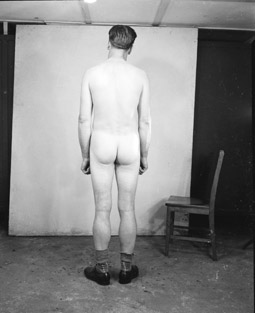
indecent assault on boys, Chatswood, Aug 28, 1952
courtesy Justice and Police Museum Collection
indecent assault on boys, Chatswood, Aug 28, 1952
WE’RE IN SYDNEY. IT’S JANUARY, 1946. THE WAR HAS JUST ENDED. THE TROOPS ARE RETURNING HOME. SHELLSHOCKED. STEPPING OFF A BOAT TO A CITY THAT HAS CHANGED IN THEIR ABSENCE. THE INFLUENCE OF AMERICAN SOLDIERS. THE BEATS OF JAZZ. THE WOMEN MORE STREETWISE. AN UNDERGROUND SOCIETY LIVES UNDER OUR FEET. CHILDREN WHO HAVE BEEN ABANDONED, SLEEPING IN SEWERS AND DRAINS.
And on the fringes, where the city meets the bush, there are places forbidden. Where women are exploited. Making films for soldiers to leer at. We’re drawn to Chinatown. The rooms above the shops. There’s the smell of blood. Closet abortions. The allure of smoke. Men with potions. A place to drift. We join a civilian chaplain who’s on the beat with detectives. Down at Central Street Police Station. He records the daily grind. The small confessions. The advice of cops. The places where crime happens. Murders, beatings, opium, prostitution, porn.
These are the dark spaces inhabited by Ross Gibson’s latest work of fiction, The Summer Exercises—part of UWA Press’s New Writing Series, which encourages innovative texts by emerging and established Australian writers (including Josephine Wilson, Emily Ballou, Fiona MacGregor [RT88, p40] and Sue Woolfe). Gibson comes from a background as a curator and producer of film and interactive media, and along with being former creative director of ACMI, he has also created installations (in collaboration with Kate Richards) for a series of exhibitions based on the collection at the Justice and Police Museum in Sydney: the major immersive audiovisual installation Bystander in 2008-09; and the installations Darkness Loiters in 2001 and Crime Scene in 1999-2000.
The Summer Exercises surfaced from Gibson’s research at the museum and its style is alive and manic in a meld of Peter Corris-pace and place, and the hardboiled terseness of Raymond Chandler—so hot the pages feel they are burning in your hands. Here there’s no nostalgic reminiscence about a bygone era; this is a dark and dirty Sydney, somewhere to try to escape from, not to return to. A stinking city of stifling heat, the kind of place where:
a competition has brewed up among the beat constables: tally every type of rain that can fall on this town.
Rain that is:
cutting
sandy
the size of a coin
smelling of sleep.
And along with a city gone to ruin, there’s an assault on the landscape of the body: the shot memories of a detective cowed and beaten, rediscovering his senses (“Imagine there’s some bladder in the brain and it’s squirting his past life back to him”) and putting himself under interrogation (“What does your flesh have stored up for you?”); the lament of a detective close to retiring (“Pain is rusted on to his lower back. Corrosion has both his knees now”); the intimate meanderings of our chaplain as he watches women dance, on film in tents, tries to resist, subjugated to their peachy flesh:
On the rump of a woman in the burlesque club tonight:
The faint outline of a man’s thumb
+
an intimate welt given by a flicked strap
+
high up where the thigh hinges—some pale skin that promises the taste of pear or vanilla
The only hiccup to the intensity and sophistication of the writing is the fictionalised Publisher’s Notes that interrupt the chaplain’s observations. These notes reflect meanings back to us before we’ve had a chance to discover, like a full stop to our imagination; it’s as if the writer is scared the reader will get lost in the seeking. But the searching is what keeps us enthralled.
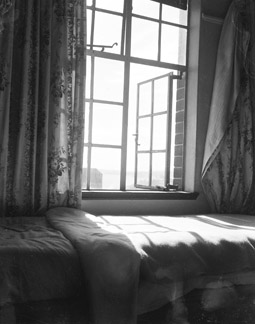
death by accident, Carncleuth St, Kings Cross, Feb 9, 1954
courtesy Justice and Police Museum Collection
death by accident, Carncleuth St, Kings Cross, Feb 9, 1954
After spending five years poring over thousands of negatives in the loft of the Justice and Police Museum, Gibson has selected 230 black-and-white photos of true-crime scenes to accompany his text, and it’s the nature of the real-life images and their delicate placement within the fictional text that packs a punch. We devour each image looking for clues. We map out the Sydney we know and try to find it located in these scenes. Is that Broadway? That building near Railway Square? We wonder at that mugshot: Is that our character who makes the pornos? We try to piece the images together with the text as we read. We wonder at the emptiness within the frames. Why the open window? The eagle-eye view down onto the street? Why is that picture on this page? Where is that lonely stretch of water? We bring the images up as close as they can go to examine the minutiae. Is that a body we can see smeared under the wheels of that truck? Are they doctors’ instruments? The images start to repeat—do they have added significance now?—so we return to earlier parts of the text. The images tease and encourage us. They make us conscious of our need for narrative coherence, to sort, to tie up those loose ends. We glance off them. We try for a deeper reading. These are images to pore over for hours. They demand our attention. We begin to create stories of our own, to see where they lead.
And by the end of the book, the nature of the images is revealed in the List of Illustrations (don’t search them out at the beginning). These are photographs of crime scenes (or places of suspicious activity) where the violence is generally absent: “Man killed by fall, Room 202, Hotel Metropole, Sydney City, 19 March 1954”; “Drowning of family, Sugar Loaf Bay, Middle Harbour, 28 May 1959.” But the sadness, the melancholy, the fear—these emotions linger in the images themselves, traces of disturbia that inform the book’s mood and create a resonance that stays with us, like “an impossible pebble afloat in bubbling water. Disobedient to gravity. Opiate pebble. Blue smoke going in, grey smoke going out.”
Ross Gibson, The Summer Exercises, UWA Press and Historic Houses Trust of NSW, 2008, UWA Press New Writing Series, www.uwapress.uwa.edu.au/fiction
RealTime issue #91 June-July 2009 pg. 55
© Kirsten Krauth; for permission to reproduce apply to realtime@realtimearts.net
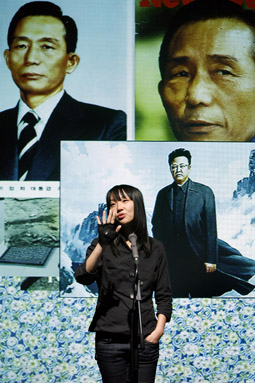
Miriam Yung Min Stein, Rimini Protokoll
photo Barbara Braun
Miriam Yung Min Stein, Rimini Protokoll
IN RECENT YEARS, THE PERFORMANCE GROUP RIMINI PROTOKOLL HAS DEVELOPED AN INTERNATIONAL REPUTATION FOR ITS GROUNDBREAKING, EXPERIMENTAL WORK. FORMALLY ESTABLISHED IN 2002, THE GROUP CONSISTS OF STEFAN KAEGI, HELGARD HAUG AND DANIEL WETZEL WHO FIRST MET IN THE EARLY 1990S WHILE STUDYING AT THE INSTITUTE FOR APPLIED THEATRE STUDIES AT GIESSEN UNIVERSITY IN GERMANY. ALTHOUGH DISPERSED ACROSS THREE DIFFERENT COUNTRIES (KAEGI, WETZEL AND HAUG ARE BASED IN SWITZERLAND, GREECE AND GERMANY RESPECTIVELY), RIMINI PROTOKOLL HAS SERVED AS THE TITLE UNDER WHICH THEY HAVE PRODUCED AN EXTRAORDINARILY ECLECTIC BODY OF WORK.
What draws this work together is the emphasis placed on developing a performance, art, theatre and radio practice driven by ordinary people, experiences, encounters and events. In Cargo Sofia-X (which toured Europe in 2008), the audience was placed in the back of a converted, glass-sided truck manned by a Bulgarian truck driver who recounted stories about his work and life as he manoeuvred the audience between service stations, roadside diners and border checkpoints. In interviews, Rimini Protokoll describes these non-actors as “experts” rather than amateurs, because what interests them about the performers is the specific knowledge and forms of experience that they bring to bear on the work in question.
Among several Rimini Protokoll works currently touring Europe is Black Tie—a performance I attended at the HAU 1 Theatre in Berlin in March and which is being staged at the Vienna Festwochen in May and June this year. Black Tie is essentially a one-woman show performed by Miriam Yung Min Stein, a German woman born in South Korea in 1977 and adopted seven months later by a German couple who raised her, together with their other children, in Osnabrück in north-west Germany.
Like most of the “experts” who feature in Rimini Protokoll’s productions, Stein does not have a background in acting. Although she studied dramatic writing in the USA and worked with Christoph Schlingensief on his 2004 production Kunst und Gemüse (Art and Vegetables), she has largely practised as a journalist and a director in advertising and music television. In 2008 she published Berlin-Seoul-Berlin which recounts a 2006 journey to South Korea in search of her identity. It is around this preoccupation with tracing her roots that Black Tie is structured.
It is clear that the performance is going to be an intimate affair. Instead of entering via the usual doors, we are ushered in via the backstage entrance to take our places on temporary seating at the back of the stage which directs our gaze towards the well-lit auditorium. At the front of the stage, facing us, is a very simple set which features a large screen for projections, a podium and a small platform for an accompanying musician, Peter Dick.
A casually dressed Stein introduces herself to us, scans her adoption certificate, which promptly appears on the screen behind her, and informs us that, as a newborn baby, she was found in a box outside the Seoul town hall wrapped in newspaper (a story which, she later informs us, was revealed to her as a fabrication). While the set is sparse, Stein uses a remotely wired glove to add and move images on the screen behind her, including close-up images of sections of the daily papers in South Korea on the day she was “discovered”—images which prompt her to reflect on whether her small body was wrapped in the international politics section, or perhaps in advertisements for fruit and vegetables.
Stein also uses the screen to provide us with a potted history of the country in which she was born: a chronicle illustrated via a colourful collage of images pasted together almost like a child’s scrapbook. This digital ‘scrapbook’ also includes images of her (very blonde) German family taken when she was a child, along with a copy of a letter written by her German mother a year after she was adopted, in which she explains the difficulties Stein experienced in her first year growing up in Germany. Stein herself also reflects on these, citing painful moments in her life when her “difference” was made clearly apparent. She recounts, for example, the sense of pain and confusion she felt when the waiter at the Chinese restaurant she was dining at with her family spoke to her in Chinese; a traumatic event that prompted her to spend the rest of the evening under the table.
These memories and images are contrasted with photographs of “what might have been” via the introduction on stage of Hye-Jin Choi, a South Korean woman living in Berlin who draws on images from her own family album to provide us with a picture of traditional family life in South Korea. The cultural differences between Germany and South Korea are also highlighted via a clip from a South Korean reality television program in which a German woman is reunited with her birth parents on stage. As the young German woman moves toward her newfound South Korean relatives, they quickly begin distributing presents to her and her German family. Both parties look confused, nervous and uncomfortable, and the reunion is painfully awkward.
While Stein has no interest in appearing on such a program, Black Tie is about the central position her South Korean identity (or lack thereof) occupies in her life. While grateful to her German family for the opportunities with which they have provided her, she is clearly angry and, to a certain extent, bitter about what she describes as the “schwarze Löcher” (“black holes”) that are opened up in people’s lives by international adoption. This anger was clearly compounded when, after arriving in South Korea, she discovered that all information about her birth parents was lost when the adoption agency was destroyed in a fire.
As is revealed towards the end of the performance, in a last ditch attempt to learn more about her identity, Stein ordered a DNA profile, after spitting into a tube and posting it to an overseas lab. Among other things, the profile reveals that she has a one in five chance of developing Alzheimer’s. As the profile is projected on screen, the performance concludes with Stein’s melancholic reflections on the relationship between remembering and forgetting, on dates that have been lost, and on sense memories, people and places that have yet to be (and perhaps never will be) discovered.
The ending itself is a very open one (leaving the audience unsure when to applaud). Any attempt, however, to wrap up Stein’s story would have undermined the active, imaginative mode of engagement fostered by the eclectic collection of materials from which the performance is constructed. The strength of the work, however, rests primarily on Miriam Yung Min Stein’s performance, and on the “expert” manner in which she communicates a sense of her, at times, difficult experience growing up as a German strangely “out of place” in Germany.
Rimini Protokoll, Black Tie, script, direction, design Helgard Haug, Daniel Wetzel, performers Miriam Yung Min Stein, Hye-Jin Choi, music Peter Dick; HAU 1, Berlin, March 11-14
RealTime issue #91 June-July 2009 pg.
© Tara Forrest; for permission to reproduce apply to realtime@realtimearts.net
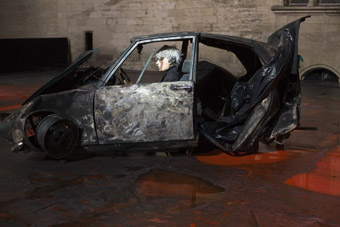
‘Andy Warhol’, Inferno, Romeo Castellucci,
photo Luca Del Pia
‘Andy Warhol’, Inferno, Romeo Castellucci,
ON THE DAY THAT THE G20 SUMMIT CONVENED IN LONDON AND BANKERS WORE JEANS TO WORK TO AVOID VIOLENT ATTACK, THE SPILL 2009 LAUNCH SAW HEADS LITERALLY ROLL. OR DID IT? AN AUDIENCE, FROM THE CITY AND BEYOND, MERRILY WATCH MARISA CARNESKY, MAGICAL PERFORMANCE ARTISTE, “MAKE SOME CUTS.” SHE PUNISHES AN AUDIENCE MEMBER FOR POINTING THE FINGER BY SLICING IT OFF WITH A GUILLOTINE; SHE GRADUATES TO A HAND, A HEAD AND A CHAINSAW TO THE STOMACH. AS WE CHEER HER ILLUSIVE MASSACRE ON, IT SEEMS THAT THE FESTIVAL WILL BE ABOUT COMPLICITY, EXCESS AND AMBIGUITY. SO WHAT DOES THE FUTURE HOLD FOR US AMIDST THIS LANDSCAPE OF BLAME AND RUIN?
Romeo Castellucci’s Inferno is an ever-evolving cycle of striking images from an (after)life that is familiar, yet distant. White noise thunders painfully as we see our reflection in the mirrored wall of a giant cube. Suddenly the surface flicks into a transparent panel, beyond which a group of toddlers play with colourful toys, oblivious to the black silk cloud that ominously expands above them. Their amplified giggling pierces the auditorium. Next to the cube, a sinister Andy Warhol lifts his Polaroid camera and snaps us, the flash imprinting itself onto our retinas. Later, a crowd of many people gather around the now black-surfaced cube as haunting choral music intones oppressively. One by one, they climb onto the cube-top and, arms outstretched, drop backwards into white light, a stunning, angelic freefall of anonymous departure. As each of them plummets, the title of one of Warhol’s works appears on a screen above them.
Life is hell, art in its ephemerality is death, and this is the story of everyman, everywoman, everyone, of past and present and future. Like the recurring image of a circle that links the trilogy, it is now and forever. Inferno moves through the motions of a detached self-reflexive aesthetic, never drawing us close enough to feel the heat of its magnitude. Flames envelop a grand piano as the crowd stands by and stares, but I am left cold amongst eternal possibilities of meaning.
Following on from the harrowingly beautiful Purgatorio (RT 87, p4), Paradiso is an installation in which, five at a time, we clamber from a small white space through the circle of a dark tunnel into an endless, sightless, humid black. The sound of running water embraces us. Our eyes adjust to see arcs of a waterfall gushing from a gap high in the wall. And then something wriggling there, pale and small. An insect? An angel? Caught at its waist it squirms, panting and yelping, an embodiment of solitary helplessness.
Just as we can’t save the toddlers from the ‘dangerous’ cloud, we can do nothing to free this figure from its hostile eternity, yet we are imaginatively active in placing it there. We are continuously reminded of the necessity of our presence, but also of our powerlessness within this structure. Yet we struggle on.
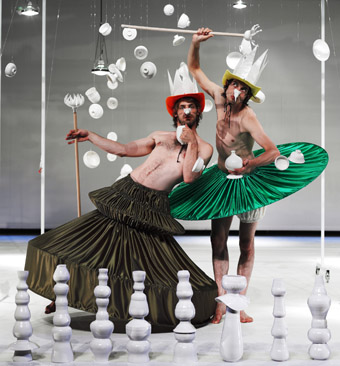
The Porcelain Project, Needcompany
photo Miel Verhasselt
The Porcelain Project, Needcompany
In Grace Ellen Barkey and Needcompany’s The Porcelain Project, a pristine white stage is fronted by a line of mismatched undulating vases. Sturdy structures are dotted about, showcasing the delicate porcelain pieces. A table over-laden with precariously stacked crockery suddenly starts to shake autonomously, the piles clatter and fragments drop heavily to the floor. To the uneasy music of drawn out discords and irregular clicking, a long-haired, bearded dancer creeps into view, bare-chested and white-trousered, with a long white spike of a porcelain nose. He looks at us mischievously and leaps through this porcelain playground, landing on the revolving platform of a circular podium. His nose protrudes through a string-curtain of jagged porcelain scraps, making them tinkle and sing. This jester is joined by a female companion in orange silk breeches and a bikini, the top two pointy porcelain funnels. She sinks onto her back beneath a clothes rail and, as the fool deftly manipulates strings to make a row of bowls dance above her, she arches her back to follow the porcelain wave, marionette-like.
More characters enter this absurd court to cavort around, kings and princesses in luxuriously coloured crinolines and hose, with oversized crowns and grotesquely phallic porcelain appendages. Their balletic elegance sweeps through into overtly sexual gestures, and the decadence of the porcelain seems to fall in on itself amid a strange exoticism, like some sort of disquieting colonial madness. The king orates nonsensically into a microphone, men grapple beneath women’s skirts and everyone is objectified by their porcelain appendages. The dancers continually look to us for approval with a childlike innocence that jolts when juxtaposed with the trembling, unsated eroticism of their dance. Drawn into this chaos, we’re never released from tension, abundance colouring this smooth, white, fantastical world. So what have we been responsible for creating?
Made during the Bush era, Rajni Shah’s durational performance, Dinner with America, is loaded with many images through which we must find our own path. The expansive floor is divided by a bark-chip maze that is gradually rearranged by two handmaidens, forcing us to relocate to new territory out of their way. Shah wears long gloves, a blonde wig and a white dress that stretches out across the floor around her. Her face is waxy white, both ‘beautiful’ and rigidly artificial. She slowly sings “Amazing Grace”, summoning echoes of the Trail of Tears, the Civil War, the evangelical South. She strikes potent gestures—a hand on the hip or a fist in the air—evoking multiple icons, from the Statue of Liberty to Marilyn Monroe. She continues to sing, glamorous, bored, defiant, sexy, poised, hollow, immaculate, and we watch on in solitary worship of this figure that morphs before and within us.
Speakers feed the voices of many Americans into the space; they talk with pride and shame about freedom, opportunity, racism, democracy. Meanwhile, the lights dim and we peer closer. Shah removes her dress and gloves to reveal not white, but brown skin, a sparkly mini-dress, stars-and-stripes platforms. Her postures become extreme, she crouches open-legged, her voice strains and quavers. And later, in a moment of captivating silence, she removes the mini-dress, boots, false eyelashes, wig, and finally the latex mask. She stands naked, small and strong and beautiful in the half-light: a crystal moment of fragile, powerful honesty.
She leaves, returning—casually dressed—with platters of fruit and chocolate, and small envelopes containing questions about cultural identity, America, freedom. The landscape of spirituality, segregation and spectacle transforms into a shared community space for laughter and debate. Perhaps a new perspective is all it takes.
In Gob Squad’s Saving the World, a huge semicircular panorama of seven screens envelops the first few rows of the audience. Three members of the Gob Squad team arrive onscreen, caped and alert, ready to ‘save’ as much of the world as they possibly can, from the 180 degree landscape of the early morning pavement on London’s South Bank. With the help of a magician, a clown, Cupid, the Grim Reaper and lots of silly costumes, rather than setting off on a G20 protest, they instead go about recording the world; committing it to film, banking it as a playful, life-affirming archive of the everyday. As the sun rises over the city, they address us—we’re posited in an unknown future—describing contemporary life in a seemingly improvised free-flow, like eccentric kids’ TV presenters. They run across the promenade pavement, energetically illustrating aspects of modern life: the Thames is an ocean, North of the river—“the land of plenty”, a row of restaurants—Hollywood. As the day progresses they enlist the help of bemused passers-by to explain concepts such as “dancing”, “expectations”, “soul”, “money”. The film is beautifully put together (though not edited, rewound or reshot during the 24 hour filming period), the manic pace broken with close-ups of individual members of the public on each screen.
But it’s hard to fit everything in, and the team argue about what to save. They speak out to their future selves, who sit amongst us in the audience, but things haven’t worked out as well as hoped: no big lottery win, a broken heart better left unmentioned, and a new look that doesn’t suit. The present selves jump back into the film to restart the celebration: the future might not work out so well, but let’s live in the moment, enjoy what we have, and make a circus of the mundane every chance we get.
SPILL 2009: Romeo Castellucci, Inferno, direction, set design, lighting, costumes Romeo Castellucci, music Scott Gibbons, choreography Cindy Van Aker, Romeo Castellucci, set-design collaboration Giacomo Strada, Istvan Zimmermann, Giovanna Amoroso, lighting design Andrea Berselli; Barbican Theatre, April 2-3; Paradiso, conception Romeo Castellucci with Dario Boldrini, Michelangelo Miccolis, set Giacomo Strada, Istvan Zimmermann, Giovanna Amoroso, Barbican Silk Street Theatre, April 2-9; Grace Ellen Barkey and Needcompany, The Porcelain Project, concept Lemm&Barkey, choreography Grace Ellen Barkey, porcelain Lot Lemm, set, costumes Lemm&Barkey; Barbican Silk Street Theatre, April 14-15; Rajni Shah, Dinner with America, performed & created by Lucille Acevedo-Jones, Lucy Cash, Rajni Shah, film Lucy Cash, lighting design Cis O’Boyle; LABAN Theatre, April 6-7; Gob Squad, Saving the World, concept Gob Squad, video Miles Chalcraft, Martin Cooper, sound design Sebastian Bark, Jeff McGrory, costume, props Emma Cattell, Kerstin Honeit, Greenwich Dance Agency, April 9-10; SPILL, London, April 2-26
RealTime issue #91 June-July 2009 pg. 5
© Eleanor Hadley Kershaw; for permission to reproduce apply to realtime@realtimearts.net
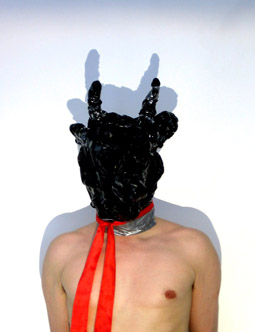
A Forest, Pacitti Company
photo courtesy Pacitti Company
A Forest, Pacitti Company
HERE’S A STORY. NOT A BEDTIME STORY, BUT A STORY TO WAKE YOU UP. THE STORY OF A FLEET OF JET-BLACK RAVENS WHO DIVE BOMB DOWN TO EARTH. KNOCKING OUT THE POWER PLANT OUTSIDE OF TOWN, THEY KEEP COMING, CRASHING THROUGH THE BASEMENTS, THE LIVING ROOMS, THE POLITICIANS’ CORRIDORS AND ALL THE TRAPPINGS OF BOURGEOIS LIFE.
This is one of the dark fairy tales told in Pacitti Company’s A Forest, an intimate performance for a small audience gathered around a gleaming mound of coins. Three performers cohabit the space: Robert Pacitti telling stories from the circle’s periphery; Sheila Ghelani serving as hostess, an intermediary between audience and event; and Richard Eton as the stooge, the fall guy, his body a canvas for Ghelani’s manipulations. She circles the space coyly, offering first her breasts and later a pair of pig’s feet. Eton burrows into the coins, dances to exhaustion and finally becomes a landscape of small trees, affixed with hot wax to the contours of his supine body. Pacitti tells story after story in a carefully modulated tone that is both demure and gleeful, taunting us to join in an indulgence of depravity and refusal. It feels as if the work itself wants to be like that hole in culture, the one blown open by the ravens; it wants to transform the pile of money we are staring at into an empty void, capitalism’s hollow heart. This is a deliberately audacious piece of theatre, and its success depends on each individual audience member choosing to go along with it. But then this is spelled out at the very beginning. Pacitti says, “You have two choices: believe everything is okay, or drown in shit.”
Pacitti is also the founder and curator of the biennial SPILL Festival, now in its second instalment. Just as he intends A Forest to be an interruption within culture, the works he has selected for the festival also feel like irruptions of culture’s dark side. Julia Bardsley’s Aftermaths: A Tear in the Meat of Vision draws an extended and multi-textured analogy between the current crisis of capitalism and ideas of religious rapture and apocalypse. Bardsley appears on a cross-shaped catwalk as part space cowboy, part revivalist preacher, her teeth gleaming with diamonds and a horsehair tail trailing behind her. The audience stands in four inwardly facing sections, divided by the catwalk and surrounded on the outside by large video projections.
Capitalism can be a soft target, especially when it’s already down, but Aftermaths digs below the surface to expose primal fears and desires, a craving for accumulation which hopes desperately to forestall annihilation. “Welcome to the black market”, Bardsley declares, “I will be the eye by which you see the sight of things hidden.” Her visuals and immersive sound experience are striking, and the glossy, black catwalk a powerful theatrical statement. But despite being surrounded on all sides by fleshy, visceral images, and despite the dance-club feeling of the throbbing soundtrack, the experience still feels distant; the piece remains too theatrically self-conscious to be totally immersive. Maybe this makes sense: rather than replacing the spectacle of capitalism with the spectacle of anti-capitalism, Bardsley leaves her viewers questioning, free to choose, as individuals rather than members of a congregation of converts.
In keeping with the festival’s commitment to audience engagement, at its centre was an unprecedented mashup of art, counterculture and politics: the 12-hour, dusk-till-dawn Visions of Excess. This swirling mix of provocations and performances included Bruce Labruce’s troupe of blue-eyed, (fake) blood-drenched, masturbating zombies; Ron Athey’s wig-wearing, (real) blood-soaked self-fisting; Samantha Sweeting’s one-to-one breast-feeding encounter; and host David Hoyle’s sharp-tongued mix of universal bonhomie with strident class and gender militancy. Visions of Excess admirably expands the frame of the art festival and the kinds of work to which it lends legitimacy. But this expanding frame also overlaps with others. An unsettling coincidence was the fact that Visions’ venue (the Shunt arches under London Bridge station) placed it next door to the London Dungeon attraction, with its own less transgressive deployment of blood-soaked zombies. Inside the event, the atmosphere and audience shared much with London’s club scene, bringing its own celebratory sense of community, but also its hierarchies and exclusions. And throughout the evening, I often found myself twice-removed from the events, being unable to directly see what was happening and instead looking through a glowing swarm of digital camera displays. Overall, the event produced a complicated, shifting blend of different forms of community: we were sometimes consumers, sometimes voyeurs, sometimes engulfed within a collective, and sometimes singled out as intimate partners.
For me, the works which were most effective in this context of expanding and overlapping frames were those which attended to their circumstances, creating or commenting upon their own framing. In Zackary Drucker’s interactive performance, crowded onlookers, hungry for spectacle, were twisted into unwitting accomplices. Pushing forward to try to glimpse his reclining, hermaphroditically posed body, we were invited to help ‘perfect’ the image by plucking all the hairs from his body with individual tweezers. And Franko B’s I’m Thinking of You featured first Franko and then a series of volunteers each sitting naked on a gilded swing for an hour. The idyllic, beautifully lit scene was a point of constancy through the evening. Amidst an orgy of complex images, mesmerising, unsettling, innocent and provocative, its simplicity worked its way subtly under the skin.
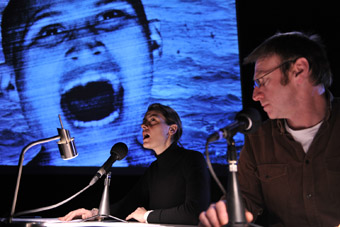
Cathy Naden, Richard Lowdon, Void Story, Forced Entertainment
photo photo Hugo Glendinning
Cathy Naden, Richard Lowdon, Void Story, Forced Entertainment
The festival also saw the premiere of Forced Entertainment’s Void Story, in which the famously risk-taking company try out a radical new direction: narrative. The piece depicts the awful misadventures of a hapless couple who through an endless night are shot, evicted, chased through sewers, knifed at a fun fair and harassed by ghosts. The story is presented through two elements: four seated actors who, as in a radio play, read from visible scripts and manufacture sound effects; and a backdrop of projected black and white illustrations of the narrative. The images are crude photo-collages, filled with glitches and artefacts and the same set of recycled pictures. They are beautiful: stark and deliberately imperfect, obviously handmade, a welcome refusal of the seamless computer-generated characters and landscapes that have become ubiquitous in mediatised culture. In contrast, this is work in which the seams are very much visible, flaunting its status as make-believe.
And yet, despite everything, I start to feel something for these two characters. When one has his leg caught in a bear trap, the sound of breaking bone is only electronic crackling, and the projected image is just a picture of a trap pasted onto a photo of an actor, and the howling actor is not feeling any pain; and yet my stomach turns anyway. This discomfort is part of a wider pleasure, which is the reality of being told a story. It’s like something the narrator says in Tim Etchells’ 2008 novel, The Broken World, which describes an immense and unending computer game. Rejecting those who question the reality of the game, he asks, “Is it reality to be even asking if it’s reality in the first place?…In the end The BW is just a part of reality. It is in the world—a part of the world. That’s all there is to say.”
The final theatre piece of the festival is another Pacitti Company work, Intermission, a mesmerising solo performance by Sheila Ghelani. Ghelani alternates between nine microphones, each labelled with a mode of performance: fact, fiction, high horse, karaoke… The piece appears to set itself up as the chance to tell it like it is, once and for all, on a series of controversial topics: abortion, death, religion, cannibalism. But as Ghelani shifts between topics and modes of address, what emerges is less a strident, coherent manifesto and, more interestingly, a complicated overlap of different voices and contradictory beliefs. As with the storytelling in A Forest or Void Story, as with the theatricality of Aftermaths, and as with the overlapping audiences in Visions of Excess, Intermission foregrounds the fact that there is no place outside culture from which to stage an intervention. Any intervention into the way things are will always be made out of things that already are—readers, actors, witnesses, places—just twisted, made strange, spilling out of their boundaries.
Pacitti Company, A Forest, conceived and directed by Robert Pacitti, co-devised and performed by Richard Eton, Shelia Ghelani, Robert Pacitti, music Sebastian Castagna; The Pit, Barbican Theatre, April 7-9; Pacitti Company, Intermission, made by Robert Pacitti and Sheila Ghelani, performer Sheila Ghelani; Soho Theatre, April 22-24; Julia Bardsley, Aftermaths: A Tear in the Meat of Vision, created and performed by Julia Bardsley, music Andrew Poppy; Laban Centre, April 13-18; Forced Entertainment, Void Story, Soho Theatre, April 21-25; Visions of Excess, curators Ron Athey, Lee Adams; Shunt Vaults, April 12
RealTime issue #91 June-July 2009 pg. 4
© Theron Schmidt; for permission to reproduce apply to realtime@realtimearts.net
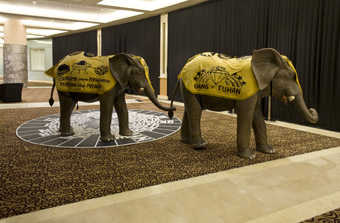
Cari Selamat installation, Eku Nugroho
image courtesy of Jakarta Arts Council
Cari Selamat installation, Eku Nugroho
I’M WELL-DISPOSED TOWARD ANY FESTIVAL THAT LETS FRESH IDEAS SEEP INTO THE STARCHY CONSERVATISM OF NATIONAL INSTITUTIONS. I ALSO HAVE A SOFT SPOT FOR ANY EVENT WHOSE LAUNCH PARTY HAS PEOPLE DANCING WITH THEIR UNDERPANTS ON THE OUTSIDE. THUS I WAS HELPLESSLY INFATUATED BY THE JAKARTA BIENNALE LAUNCH AT THE NATIONAL GALLERY OF INDONESIA. SECONDS AFTER THE DIGNITARIES HAD LEFT, A RAMSHACKLE TRUCK LOADED WITH SPEAKERS WAS BLARING MUSIC FROM THE SIDE COURTYARD, AND A RENT-A-CROWD OF OVERSTIMULATED RAVERS MATERIALISED TO THRUST AND JIGGLE UNDER THE VIDEO PROJECTIONS IN DAY-GLO PLASTIC COSTUMES.
Apparently the genre of hectic Hi-NRG techno on display is called Pantura. It’s a truckstop disco genre, I’m told, with extra glowsticks. As for the thronging crowds sporting pool floaters and coloured goggles, I don’t know where they fit into the biennale picture, nor did I get the overall message of the performance—except that it would supposedly be to my benefit if I shook my “pantat.” Nonetheless I’m convinced that every exhibition launch should have one of these as antidote to launch-speech bombast. And I can’t imagine a launch for any public event here lasting long if it were shy of raucousness.
Jakarta seethes and steams, and frankly, stinks its way into the air of every event that takes place in its messy, corrupt, crowded confines. You can’t for a moment forget where you are, as you fight through traffic to reach the venue, as your accommodation floods, as the toxic traffic pollution settles in a thin, carcinogenic layer on the roof of your mouth. The Jakarta Biennale has a pervasive sense of place that some other cities lack the sloppy public health standards to provide. It’s therefore possibly the only thing that could succeed in such an environment—a messy, ambitious event that revels in, riffs upon and constantly interrogates the intrusive urban morass it calls home. Oh, and did I mention how big the city is? Depending where you draw the boundary, Jakarta contains between seven and 30 million people in continuous urban agglomeration. It’s a whole, inescapable, world.
This year’s biennale, titled Arena, has been much anticipated due to the rogues gallery of cult art scene figures pulling the levers: artistic direction by Ade Darmawan, curators from his notorious Jakarta arts collective Ruang Rupa, and Bandung’s Selasar Sunaryo gallery—a crew that traverses the spectrum between high end commercial gallery society and ratbag media activism. It’s something like an arts A-team. I’m not sure if the festival’s belligerent naming stems from the inevitable themes of art in a city such as this or, perhaps, if it was named in an act of resignation to the combative stances of the curators and artists themselves. Whatever the causal link, the result is a festival that fits its title singularly well: an engaged, aggressive and sometimes clashing tumult.
the fluid zone
Of the three sub-programs, just two are active while I am in town: Zona Pertaraungan/Conflict Zone, and Zona Cair/Fluid Zone. I’m not sure which of those sponsored the gallery rave, but in general they are both less underpants-driven. The launch kicks off a good, though variable, exhibition. The Fluid Zone makes more conventional use of gallery space. Most prominently, Jompet’s elaborate, grandiloquent installation keeps me captivated for a good half hour. He has filled an entire hall with ranks of a robotically animated historical Indonesian army band, complete with drums, playing an eldritch military tattoo intercut with multiple channels of video on miscellaneous screens, depicting the artist recreating the ancient Javanese dances of dedication performed amongst the machines at an old Dutch sugar refinery. The proud and problematic icons of Javanese culture reinvented as empty poltergeists reads to me like an essay in the revisionist cultural iconography implicated in the ANZAC legend but here with a different kind of colonial angst.
Around the main hall I’m grabbed by the emergent theme of reappropriation of mundane objects: Tintin Wulia (Denpasar/Melbourne) has created a muted rainbow of forged passports. Roslisham Ismail (“Ise” to those who caught his residency at Sydney’s Artspace) has collaged loanshark handbills into a lurid wall banner spelling out NEP, the euphemistic acronym of the Malaysian affirmative action economic regime. The most eyeball-searing work in the category is David Grigg’s photo documentary of Philippine slum gang tattoos. I can’t tell if I like its inarticulate bloodiness, but I can’t look away, which amounts to the same thing.
And the show goes on, a rush-hour pile-up of works in this crossroads of southeast Asia. The Fluid Zone has the lion’s share of international artists, with attendees from across Australia and ASEA. This regional focus, we are told by curator Agung Hujatnikajennong, is less an attempt to leap into the globalised biennale circuit than a logical outgrowth of Jakarta’s cosmopolitan history. He presents the event as something of an exchange between neighbouring peers as opposed to, I suppose, marketing for the entrenched oligarchs of a global art market to which Indonesia is peripheral. It’s as much noble sentiment as it is a great way to save on airfares.
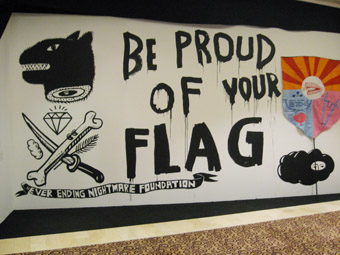
Zinester Flag, Eku Nugroho
photo Dan Mackinlay
Zinester Flag, Eku Nugroho
the conflict zone
Across the gallery courtyard from the slick internationalism of the Fluid Zone, is the gallery component of Zona Pertarungan/Conflict Zone. This program is curated by Ardi Yunanto, editor of the bilinigual Indonesian contemporary art magazine Karbon. At Ruang Rupa, Ardi has also managed the Jakarta 32ºC program of urban interventions. Sydneysiders may recall him presenting a retrospective of that project at the recent Sydney Biennale event, Constellations 3: Extra/Ordinary Cities: The Cultural Dynamics of Urban Intervention. It’s clearly a core passion for him—urban intervention is everywhere in the program Ardi has assembled. And where the Fluid Zone is regional, Zona Pertarungan is consciously parochial, and relentlessly political.
This program is also more physically dispersed, colonising an exhausting inventory of public sites across the city. Works are anything from murals to subverted advertising on billboards, to outright illegal fake street signage. The gallery show, then, is less the works themselves than a convenient digest of pieces scattered throughout the city for those too lazy to sift through the chaos of Jakarta slums trying to pick out which bits might be art. However the show’s role is not solely documentary—some works are too ephemeral to find, such as the Carterpaper collective’s hilarious culture jams, and some are entirely imaginary, such as Ari Dina Krestyawan’s attempt to insert surreal stream-of-consciousness “public announcements” into the LED displays above the city’s main road. That latter work exists only as a composited video, not the only work whose installation was cancelled in last-minute failures in negotiations with the sign’s owners.
As heated as the debate about Australia’s diminishing supply of art spaces can get, Jakarta’s space is so constrained in comparison that it seems a cautionary fable. Every inch of streetscape is the subject of multiple conflicting regimes of ownership, corrupt regulation, protection rackets, and so on. Curator Ardi recounted the story of a large mural of chess pieces on the pylons of a freeway flyover. The work, by designers Saleh Husein and Kudaponi is a painted tribute to the impromptu chess playing tables that set up in the shade. Between the council fees, the bribes and outright protection rackets the cost of keeping it there is comparable to renting commercial billboard space. The chess mural treads a little close to faux-folksy celebration of the poor by richer artists for my taste, although Ardi is quick to itemise the exhaustive community consultations that the artists had gone into spanning months—not to mention an ignominious defeat in a chess tournament for the artists.
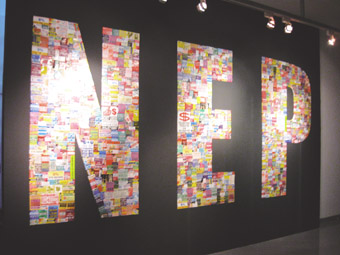
NEP, 2009, Roslisham Ismail aka Ise
photo Dan Mackinlay
NEP, 2009, Roslisham Ismail aka Ise
in the malls
When the Fluid Zone program escapes the national gallery it is not to the streets, but to the shopping malls. Most prominent is Indonesia’s richest, the Grand Indonesia Shopping Town, which is a Biennale sponsor and has artworks nestled between their Gucci outlet and their Moulin Rouge-themed foodhall. The show here is not light on politics nor social critique, both implicit and blatant. On the former side, Australia’s Craig Walsh has installed the latest in his series //Incursions//, where a video projection conjures an apparent flood destroying the contents of the shopfront. It’s strangely effective here, in this city of flash floods and broken plumbing, compared to regulated, risk-assessed Australia.
Other works are on the didactically anti-consumerist side. Manila-based Poklong Anading’s work “caskets” is a climbing wall up the sides of the mall atrium, whose holds are resin casts of consumer ephemera. It’s a defiantly ugly, uncollectable work that seems strangely at home amidst the cacophony of advertising that is the mall. Eko Nugroho delivers his photocopy-based, polemical zine aesthetic with a brash critique of the corruption of politics and religion told through the medium of giant model elephants and graffiti robots. The quieter satire of Wiyoga Muhardranto’s erogenous shopping bag sculptures, with their breasts and voluptuous curves, mocks the empty seduction of advertising, even as they themselves function as exquisite, and exquisitely acquirable objects of consumption.
This last work crystallises a contradiction in the biennale progam. It’s not just that, between the commercial festival sponsor branding and Indonesian mall-kitsch backdrops it’s hard to pick the faint critical signals from the noise of shopping. Agung argues it’s a pragmatic necessity if the biennale is to be relevant. Jakarta has no public space, as Ardi has discovered, and if one does wish to be engaged with a middle class public and not just the poor, where else should the work be hung? Fot me, it’s a rude shock—in Australia, I explain, we demurely conceal this conflict with a polite separation between the consumerism of the art market and the romantic purity of the artist.
between conflict & fluidity
The problem that perturbs me more is the distinction in venues and media, and subject matter, between the Conflict and Fluid Zones. If it’s a concession to the necessities of engaging with diverse audiences then it seems unfortunate to sequester the subject matter and the audiences, leaving the urban elites to dally in sophisticated self-critique and the poor to celebrate their tribulations in best-practice community development projects.
On the other hand, I also wonder where else I could find a festival that is so thorough in its attempt to engage with a whole city, from the wealthiest to the poorest, all on their own terms. It’s a vindication of the biennale’s boldness that I can even make these criticisms, that I may muse on the small failings in presentation of a director and curators who have so thoroughly engaged with their city. This biennale has been one of the most thought-provoking events I have witnessed, a bold dive into the the details of a city that seems larger than my entire country. I’m coming back.
Jakarta Biennale, Arena, 2009, artistic director Ade Darmawan, Jakarta, Feb 6-27, www.jakartabiennale.com
RealTime issue #91 June-July 2009 pg. 8-9
© Dan MacKinlay; for permission to reproduce apply to realtime@realtimearts.net
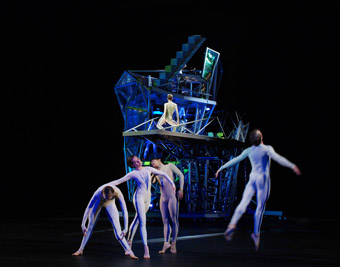
Nearly Ninety, Merce Cunningham Dance Company
photo Anna Finke
Nearly Ninety, Merce Cunningham Dance Company
MERCE CUNNINGHAM TURNED 90 ON THURSDAY. THAT DAY, I AM AT THE NEW MUSEUM ON THE LOWER EAST SIDE AT AN EXHIBITION TITLED THE GENERATIONAL: YOUNGER THAN JESUS, A JAM-PACKED SURVEY OF 50 ARTISTS UNDER THE AGE OF 33, WHICH “(DRAWS) FROM THE BELIEF THAT SOME OF THE MOST ENDURING GESTURES IN ART HAVE BEEN CARRIED OUT BY ARTISTS EARLY IN THEIR CAREERS.” AS THOUGH AGE HAS SUDDENLY BECOME A DEFINING FACTOR, ACROSS TOWN AT BAM IS THE PREMIERE OF CUNNINGHAM’S NEW WORK, NEARLY NINETY, WITH MUSIC BY SONIC YOUTH, JOHN PAUL JONES AND TAKEHISA KOSUGI, UNDER THE SEASON’S TITLE OF MERCE CUNNINGHAM AT 90.
Cunningham was 25 when he presented his first solo show. He was 34 when he formed his company with John Cage, and set about ridding modern dance of expressionism, narrative, cause and effect and most particularly, its dependence on music. His intention was, and still is, that dance itself should be the subject of dance. To serve his ideas, he formed a movement vocabulary that in turn became a technique, which is where I first encountered him at 16 in a church hall on Friday nights. (Coincidentally I was first listening to Sonic Youth about the same time.)
Despite writing an abundance of essays on his influence on dance while at university, Nearly Ninety was the first work of Cunningham’s that I have had the opportunity to see live, and I was both excited and slightly apprehensive that I would find it outmoded, particularly with all those unitards.
The stage is filled with dancers warming up, stretching and rehearsing phrases. I get a thrill watching this casual run through. Here they are: the stag jumps, the triplets, the jolting moves into the air that come from nowhere and evaporate just as quickly. The precision of the dancers is evident, even in tracksuits.
The first part of Nearly Ninety has the dancers performing downstage in front of a screen, serving for both video projections and as an opaque division for a metal tower behind, part Tower of Babel, but mostly Dr Who Tardis, inside which the musicians play on three levels. The dancers begin in duets, supporting and moving into one another with an attitude that suggests the partnering is coincidental, and just as easily move away from each other. From my position, up high, I am reminded of science videos of cells free floating, attaching and separating. They are wearing unitards, complete with gloved hands on one side, with patterned angles of black and white. On the white side, there is the clear ripple of muscle: the muscular effort involved in executing this Cunningham vocabulary.
It is hard work, all this theory. The independence of each dancer, the independence of each move that enforces an almost clinical clarity, calls for an intense virtuosity, but not the kind that shows itself off in a flinging abandon or finds a release. This is constricted, solid, intellectual. I feel my own muscles tightening in empathy.
The dancers are constantly on and off stage, and always within the dance as they enter and exit. There are moments of almost extreme slow motion, punctuated by flickers of speed, each dancer with their own timing and phrasing. Legs arc out and bodies lean, creating protractor-like measurement of angles between body and floor, between limbs, and space between bodies. There is no movement outside the Cunningham lexicon, nothing pedestrian which, knowing my dance history, shouldn’t be a surprise, but is.
In the second half, the screen disappears, and the tower behind is turned so that the musicians become more visible, a larger part of the visual texture. The movement now is faster with more of the company on stage for more of the time. The overall feel is fluid, though individual movements are just as staccato and autonomous. There are brief moments of silence where the dancers’ footfalls and jumps are audible, but mostly the music score takes its turn in precise intervals between Kosugi, Jones and Sonic Youth: ambient, static-y or swirling.
I enjoy watching this dance. I enjoy thinking through again what a great innovator Merce Cunningham was, evident here within his movement. I am almost moved to tears seeing him in his wheelchair for the curtain call, dressed in a soft velvet suit.
Yet this performance occupies a strange place. It is incredible to see this technique, these dancers live, in the here and now. But it also has a certain museum quality—the innovative phase of the choreography has passed. Placed against what the New York Times calls the “trendy” elements (the music, the tower, the video projections), I find the work jarring. I cannot put Kim Gordon, in heels, playing her guitar with her super cool stance together with these unitard-clad dancers in front of her. This is partly because Sonic Youth’s music sprawls, spirals and builds towards a climax in a most un-Cunningham-like way, but also because choreographer and musicians seem from different eras.
This is, of course, most likely the point—to reframe the dance continually, to allow it to be constantly re-seen, and though one might argue that Cunningham did make his ‘enduring gesture’ early in his career, it still certainly endures. It’s like a live mash-up, not too dissimilar from the sampling of random elements of the much younger ‘digital natives’ over at the New Museum.
Merce Cunningham Dance Company, Nearly Ninety, choreographer Merce Cunningham, music composed & performed by John Paul Jones, Takehisa Kosugi, and Sonic Youth (Kim Gordon, Thurston Moore, Lee Ranaldo, Steve Shelley), decor Benedetta Tagliabue, costumes Romeo Gigli, lighting Brian MacDevitt, video design Franc Aleu; BAM, Howard Gilman Opera House, April 16-19
RealTime issue #91 June-July 2009 pg. 10
© Jane McKernan; for permission to reproduce apply to realtime@realtimearts.net
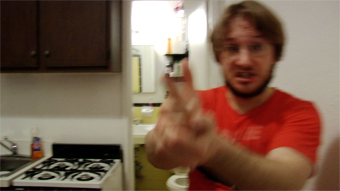
Zachary Oberzan, Rambo Solo, Nature Theater of Oklahoma
photo Peter Nigrini
Zachary Oberzan, Rambo Solo, Nature Theater of Oklahoma
UPFRONT I WILL ADMIT TWO THINGS. ONE: I HAVE NEVER SEEN THE FILM RAMBO. TWO: I AM UNABASHEDLY A FAN OF THE NATURE THEATER OF OKLAHOMA, HAVING SEEN THEIR PRODUCTION NO DICE (RT89, P6) AT THE SYDNEY FESTIVAL IN JANUARY THIS YEAR.
So in some ways I come full of expectations, and in other ways with none at all. Rambo Solo is, as the title suggests, a solo show performed by Zachary Oberzan, conceived and directed by Pavel Liska and Kelly Copper, the directors of Nature Theater, in conversation with Oberzan. To describe the show is possibly to undermine the brilliance of its simplicity, but I will because, like good conceptual theatre, the stating of the idea goes nowhere near the experience of it. It is simply this: we the audience are invited individually into the theatre by Oberzan, who, wearing a dressing gown and ugg boot style slippers, leads us to a cushion on the carpeted floor.
When we are all seated, and he has changed into track pants and an old red T-shirt bearing the words “Putting the Man into Romance”, he ascends the stage, which is more like a sideways gangplank across the room, and the show begins. Behind him hangs a white sheet onto which are projected a triptych of video versions of Oberzan in his tiny New York apartment. All four Oberzans, though we only hear the live one, begin to narrate the story of Rambo or more correctly the plot of the novel, First Blood by David Morrell, on which the movie version of Rambo was based. This continues, following various sub-plots, right through to the bloody end.
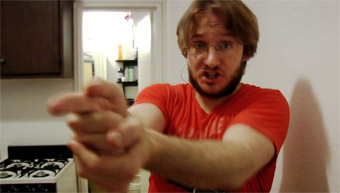
Zachary Oberzan, Rambo Solo, Nature Theater of Oklahoma
photo Peter Nigrini
Zachary Oberzan, Rambo Solo, Nature Theater of Oklahoma
The video Oberzans, with various stages of facial hair growth, utilise locations within the apartment to flesh out the story. The bath serves as both a prisoner of war camp and cell; the loft bed, the top of a sheer cliff; a standard lamp next to a chair with the cord draped over his arm, a hospital. The live Oberzan gives us the story without props or set, except for a large bag of M&M’s, a bottle of water, a belt, and later a large Rambo style knife. He mirrors the actions of the video versions of himself, including some fairly feeble martial arts moves whenever he mentions that Rambo is a “green beret” or, more often, “fucking bad ass.”
To anyone who has suffered through a friend’s retelling of the plot of a novel or film in far too much detail—much like listening to the narrating of someone else’s dream—this might sound like an arduous night in the theatre. It is, however, quite the reverse.
As in No Dice, Rambo Solo uses the repetition of a recorded conversation, with all Oberzans wearing iPods. However this time, the only part of the conversation we hear is what we presume to be Oberzan’s, though it mostly takes the form of a monologue and there are recurring moments when Oberzan is silent, or ends his sentences with a question as though asking for confirmation that he is right. At the beginning he asks how much he should describe, “like as though you don’t know the plot?”, to which there is no audible answer. But towards the end of the show, when he asks “Hello?” as if to check he is still being listened to, the audience on the night I was there were so sucked in that they felt compelled to answer out loud, “Yes!”
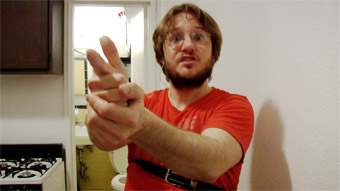
Zachary Oberzan, Rambo Solo, Nature Theater of Oklahoma
photo Peter Nigrini
Zachary Oberzan, Rambo Solo, Nature Theater of Oklahoma
The use of the video versions of Oberzan, filmed repetitions of him retelling the story, and the repeated iPod material, emphasise the plain storytelling nature of the piece but also undo notions of any stable reading. Equally, Oberzan’s particular delivery, more naturalistic than No Dice’s hyperbole, but similarly stilted, made me question whether he was doing a Stallone impersonation or that was his actual speaking voice. At one point, when talking about the film version of Rambo, he says, “I don’t know about acting anymore”, I too feel I don’t know about acting an more. Is he acting? Is he enacting himself—a man who has an unreal obsession with a trash novel, and a slightly frightening attitude to weapons and self-protection—or is this a knowing characterisation?
The line between authenticity and pretence keeps shifting, particularly when we learn that the trailer for a film, Flooding With Love For The Kid (Oberzan’s own adaptation for screen from the novel), shown at the end, is advertising a real film that Oberzan has made (in which he plays all the characters) and is selling in the foyer.
In one part of Rambo Solo, Oberzan calls First Blood his Hamlet. I feel like Nature Theater are my Shakespeare with their ability to find the poetic within the most everyday subject matter, to talk about theatre at the same time as making it, and to be so entertaining and funny in that faux amateur performance style, yet somehow tingeing it all with a sense of melancholy and despair. They are themselves, as Oberzan would say, “Fuckin Bad Ass.”
Nature Theater of Oklahoma, Rambo Solo, concept & direction Pavol Liska & Kelly Copper in conversation with performer Zachary Oberzan, design & video Peter Nigrini; Soho Rep, March 19-April 19
RealTime issue #91 June-July 2009 pg. 12
© Jane McKernan; for permission to reproduce apply to realtime@realtimearts.net
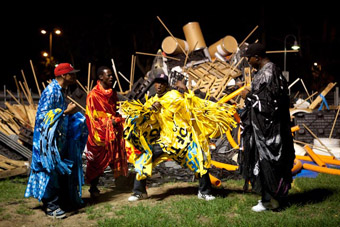
Darrio aka Manifest, Kon aka J.Manifest, Yasim aka J.Krucial, Omar aka Scrappy, ACTIVATE 2750, Ash Keating
photo Alex Kershaw
Darrio aka Manifest, Kon aka J.Manifest, Yasim aka J.Krucial, Omar aka Scrappy, ACTIVATE 2750, Ash Keating
samson & delilah wins camera d’or
Warwick Thorton’s Samson & Delilah, featured on the cover and in interview and review in RealTime 90 (pp 23, 24), has won the Camera d’Or at the 2009 Cannes Film Festival for Best Debut Feature Film. The film was programmed in the Official Selection and shown in Un Certain Regard—a category for “films that express a personal vision, with an emphasis on special cultural expression and cinematic innovation.” The film is currently screening in Australian cinemas and will be shown later this year on ABC TV.
kronos quartet plays jon rose
The American string quartet, Kronos, have collaborated with Australian violinist and composer Jon Rose (RT90, p48) on Music From 4 Fences, a work commissioned by the Sydney Opera House and premiered June 5. Rose has played fences around the world for decades and, more recently, with partner Hollis Taylor has sounded them across Australia (as documented in Taylor’s book, RT82, p40). After hearing Rose’s Rabbit-Proof Fence, Kronos leader David Harrington came to Sydney to meet the composer. A work for barbed wire fence (with its connotations of brutal containment of land, animals and humans) is the result.
heart library: st vincent’s hospital
George Khut researches the use of biofeedback “for re-imagining how we think of, and experience ourselves in relation to our bodies.” After its successful showing at Campbelltown Arts Centre as part of the 2008 Mirror States media arts exhibition, Khut’s The Heart Library Project will make its first appearance in a hospital, Sydney’s St Vincent’s, where it will be open to patients, staff and the public. In 2008, Keith Gallasch wrote, “The Heart Library goes much further [than previous Khut works] in transforming states of being into artistic mirrorings and with greater audience-as-co-maker participation. The visitor retires to a gently darkened space, stretches out on a cushioned platform, holds a sensor in each hand and encounters themself, life-sized, on a screen above. The pace of the heartbeat yields a flow of snow or blossom-like drift over the body and changes in colour and sound. For some participants the variation is subtle, for others relatively dramatic in intensity. On leaving the space, you enter another hung with full-scale drawings by other participants reflecting what they’d just experienced. A number are distinctive artworks and all are revealing about where people see their bodies, centred or off-balance, wounded, anxious or enjoyed” (RT87, p34).
As part of this Australia Council supported research project and in collaboration with dLux Media Arts, Khut reports that “he will also be collaborating with clinical psychologist Steven Albert and youth arts-health worker Emma Watkins of Urban Arts Base to explore the potential of this work as a vehicle for promoting mental health awareness to young people negotiating issues such as anxiety, panic attacks and depression.” The Heart Library Project at St Vincent’s, An Interactive Art Project by George Khut, Level 4, Xavier Ward, St. Vincent’s Public Hospital, Darlinghurst, Sydney, July 6-19, www.georgekhut.com
emerge festival
Multicultural Arts Victoria’s Emerge Festival will be a potent reminder, and news for many, of the dramatically changing Australian multicultural landscape, not least with its large contribution from immigrant African artists. Emerge is a celebration of Victoria’s many undiscovered refugee cultures and includes a much warranted focus on the plight of the Burmese people. The festival commemorates the United Nations World Refugee Day and celebrates Refugee Week in Australia with a series of concerts and events around Melbourne, June 16-July 26.
The festival commences with a five-hour Fitzroy Town Hall concert featuring many African artists alongside Australian Indigenous and Maori performers. The town hall event includes an Ethiopian coffee ceremony, a wide range of cuisines, workshops in and displays of Pacific Island body percussion, African drumming, belly dancing, henna tattooing, hairbraiding and concert performances from African communities from across the continent: Guinea, Sierra Leone, Burundi, Sudan, Ethiopia, Tanzania, Congo, Zimbabwe and Ethiopia. Other events in Emerge embrace cultures from Afghanistan and India to Turkey and Japan. www.multiculturalarts.com.au/events2009/emerge.shtml
it’s a jungle out there
Martin del Amo sees the city as a rich source of choreographic material. His new work will premiere at Campbelltown Art Centre, June 24-27. Titled It’s a jungle out there, it will “physicalise Sydney’s labyrinthine, many-faceted nature, distilling the complexity of the urban experience into a multi-layered performative fabric made of dance, story telling and electronic sound design.”
www.campbelltown.nsw.gov.au
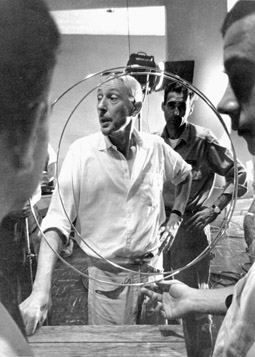
Len Lye on the set of Fountain of Hope, 1959
image courtesy Len Lye Foundation
Len Lye on the set of Fountain of Hope, 1959
len lye retrospective, acmi
For lovers of experimental cinema who live outside of Melbourne, it’s time to invest in a bargain airfare and head to the Australian Centre for the Moving Image for a remarkable world premiere, a major retrospective of the work of Len Lye. One of the great, innovative artists of the cinema, New Zealander and cosmopole, experimental filmmaker, poet, painter, kinetic sculptor and theorist Len Lye (1901-1980), is being celebrated at ACMI in collaboration with the Govett-Brewster Art Gallery (New Plymouth, NZ). As well as major creations, the retrospective will include, says ACMI, “art works and materials never exhibited before—ranging from early sketches, paintings and batiks, through to his photographic work, animation and documentary films, and extraordinary motorised kinetic sculptures.” Lye worked in New Zealand, Sydney, Samoa, London (where her exhibited paintings in the 1936 International Surrealist Exhibition) and moved to New York in the 1950s. He pioneered the still hugely influential technique of ‘direct filmmaking’—painting, drawing, animating and stenciling directly onto celluloid. In RealTime 92 (Aug-Sept), Brisbane co-director of the Otherfilm Film Festival, Danni Zuvela, will review the exhibition and interview its ACMI co-curator Alessio Cavallaro (working with Tyler Cann, Curator of the Len Lye Collection and Archives). Len Lye—An Artist in Perpetual Motion, ACMI Screen Gallery, admission free, ACMI, Federation Square, Melbourne, July 16-Oct 11, www.acmi.net.au
ash keating’s activate 2750
Images from Melbourne artist Ash Keating’s ACTIVATE 2750, a work created earlier this year as a C3West project in Penrith, 50 km west of Sydney, postcode 2750, in association with SITA Environmental Solutions, will be shown at Breenspace in Sydney in June-July. Keating was invited by the MCA as part of C3west (with Penrith Performing & Visual Arts; Campbelltown Arts Centre and Casula Powerhouse) to work with SITA to create a new work. Keating decided to engage with key public places and “areas of consumption” in the city. As he reports in his blog, “It would involve me physically intercepting and manipulating material waste destined for burial at the SITA landfill in Kemps Creek. Activate 2750 would be the culmination of a series of waste interventions I had actioned over the course of a year starting with 2020? in May 2008, followed by Label Land in August, working in Korea on an Asialink residency with ten first year art students intercepting fabric label waste and manipulating it into costumes which we later paraded around Seoul in a series of public actions.”
Since 2002, Keating had worked for his late mother’s waste audit and consultancy company, travelling “Australia wide, as a visual auditor assessing the amount of commercial and industrial waste sent to landfill. This experience opened my eyes to the disregard that industry in general has for sustainability…” Keating salvaged 52 square metres of waste material to create “an apocalyptic zoological habitat. As well, shopping trolleys were manipulated into eccentric movable waste machines by the local artists and art students who were all encouraged to…push them, in a series of performative processions” along the highway, the city’s shopping strip and into Westfield Plaza. “Another part of Activate 2750 involved dance performances by Darrio Phillips and his Krumping students.” Activate 2750, writes Keating, “highlighted the disposal of commercial and industrial waste, by redirecting it into the public realm.” Ash Keating, ACTIVATE 2750, Breenspace, Sydney, www.breenspace.com; http://activate-2750.blogspot.com
realtiming
RealTime staff have been busier than usual in 2009 with the publication of Experimental Music: Audio Explorations in Australia (UNSW Press), edited by Gail Priest, who was also one of the participating artists in a recent Artspace show, Between Site and Space, that came out of a 2008 residency with Tokyo Wonder Site. Priest has been working on the sound design for Karen Therese’s performance work, Riot Act, which has premiered at Campbelltown Arts Centre, and Martin del Amo’s It’s a jungle out there, at the same venue. Keith Gallasch and Virginia Baxter led a reviewing team at Dance Massive in Melbourne in March and, in May, travelled to Adelaide for Artlink’s symposium, Changing Climates, on the future of arts magazines (Artlink will be placing the papers online). In April, Keith ran a review-writing workshop in Cairns as part of the Induce program for artists, and will return in July for more workshopping at the On Edge Festival. He recently returned from Korea where he was guest of the Chuncheon International Mime Festival (see RT92 for a report on this distinctive event).
RealTime issue #91 June-July 2009 pg. 13
© RealTime ; for permission to reproduce apply to realtime@realtimearts.net
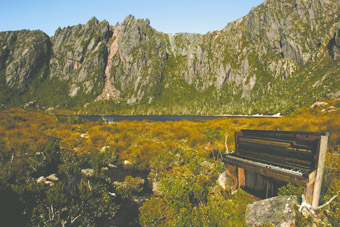
Ross Bolleter’s Ruined Pianos
photo Peter Whyte-Roar Film
Ross Bolleter’s Ruined Pianos
ONE OF THE TRADITIONS OF TEN DAYS ON THE ISLAND SEEMS TO BE TO PRESENT AN ASTONISHING THEATRICAL SPECTACLE RICH IN GRANDEUR AND VISIONARY SCOPE. TWO YEARS AGO, WE GOT DREAM MASONS, AN OUTDOOR SHOW THAT WAS HUGE IN SCOPE AND VISION, AND AN AWFUL LOT OF PEOPLE SAW IT. I THOUGHT IT WAS BREATHTAKING, BUT IT ALSO HAD A FEW PROBLEMS. METAMORPHOSIS WAS FASCINATINGLY SIMILAR—AMAZING THEATRE, YET SOMETHING NOT QUITE RIGHT. IT WAS ALMOST TOO AMAZING.
Metamorphosis, a collaboration between Theatre Vesturport of Iceland and David Farr’s Lyric Theatre of Hammersmith, is an interpretation of Franz Kafka’s The Metamorphosis. Gregor Samsa awakens one day to find himself transformed into something hideous, something not human. His family are terrified and disgusted by his new state. His sister tries to communicate but, in the end, she cannot and Gregor dies alone.
The incredible, two storey set for this work must be one of the most lavish I’ve encountered, so finely tuned that every tiny detail glowed. On the second floor, we saw Gregor’s room as if looking down into it—this clash with the normal perspective downstairs produced vertigo and discordance. The Nick Cave-Warren Ellis soundtrack added richness, yet even more incredible was the feat of athleticism accomplished by Gísli Örn Gardarsson in his performance as Gregor. He scuttled about, even hanging from the ceiling, totally in control of his physicality and his realisation of Gregor. The rest of the cast gave stylised, almost robotic performances that contrasted strongly with the humanity exuded by Gardarsson, asking us, who is human.
It was all too easy to pick sides here though, as what we could see was actually an athlete who could elicit compassion from an audience while hanging upside down five metres in the air. He was too easy to like, and the family too easy to judge. Or was it that spectacle itself disallowed the complexity I craved?
When I saw the Auckland Theatre Company’s Hatch, everything that had left me uneasy about Metamorphosis was thrown into sharp relief. Hatch is the real tale of Joseph Hatch, who made a fortune boiling down thousands of penguins for their oil on Macquarie Island. Nasty. The idea of exploring the history of a repugnant capitalist and environmental vandal supreme is a peculiar one. The man is unlikeable, yet such was the craft of this performance that I was seduced.
Historically, Hatch had pleaded his case to the public after his licence to operate was revoked. The show is a recreation of the lectures he gave in Hobart. But this is a lot more than historical recreation; the show presents us with a clash of ideologies embodied in the ultimately tragic story of an intriguing character. Hatch gave us his point of view for an hour: he spoke of industry, civilisation and progress. He spoke of hard work, tackling the elements, economic vision and daring—and it was fascinating. The man’s life, his epic migrations, his contribution to the history of Australia, New Zealand and Tasmania were gripping theatre. I’d never known of him, but here was a life that encountered historical giants such as HG Wells, Sir Douglas Mawson and Baron Rothschild as opponents during the movement against his slaughter of penguins.This was very probably the world’s first pro-environmental campaign.
Stuart Devenie is a masterful actor, bringing Joseph Hatch to robust life, and even making him likeable. For an arch capitalist, a murderer of thousands of beautiful wild birds he comes across as charismatic and funny. The ambiguity is palpable and discomforting. I was amused and challenged by this show, as well as being impressed by how effectively one man and a slide projector can hold an audience. Especially poignant was the chime of the Hobart GPO clock marking time; sheer coincidence and yet Devenie worked the chimes into the performance. When the clock finally struck seven, Hatch wordlessly stared out the City Hall window, open mouthed, maybe afraid. His time was up. The theatrical power of this small, perfect moment was memorable, but so was everything about this admirably tight show.
I can’t truly say that Hatch was a better show than Metamorphosis, that isn’t the point. This isn’t some contest of theatrical styles, but I did wonder if populist spectacle is the answer to our needs. I was glad to see Ten Days catering for all comers in the end.
Ross Bolleter’s Ruined exhibition at the Bond Store of the Tasmanian Art Gallery & Museum offered a glimpse into the extraordinarily creative and unique mind of one of Australia’s most vital—what? What is Bolleter exactly? This isn’t an easy question, for although he is certainly a gifted musician, he is also an historian and a curator. He collects ruined pianos—pianos that have been left to the mercy of the elements, stored on their sides in sheds and covered in tools, gone mouldy and had possums draw their last breath and rot in them.
Bolleter plays the pianos, talks about them and presents each one’s story. His investigations into the sound made by ruined pianos requires a precise sensitivity to history, as well as a very refined understanding of the potential for sound to convey meaning. When one considers the importance of the piano as a centrepiece to the colonial household, which Bolleter drove home in his enlightening and informative lectures, one begins to grasp the sheer scale of his project—investigating colonialism and its residue by concentrating on a particular object. Bolleter plays ruined pianos with a great deal of respect for “what the piano offers”, and this would appear to be the resonance of history itself. There are no wrong notes; there is only the presence of time and the impact of place.
Much is implied by the simple tale of how a piano got to be left in the bush, how it was taken up river, who it was played by and every other tiny detail that has affected the sound that Bolleter coaxed from it, even if there was nothing but a rusty frame to be tapped and plucked. In doing so, he is pointing to our nation’s past and in this fractured, yet totally and deeply considered music, lies Australia’s colonial history: its triumphs and its shame. This is a powerful and moving project, clearly years in the making. Ross Bolleter is a unique artist with an engrossing vision.
I liked a lot about Ten Days on the Island this year, but Ross Bolleter’s Ruined stood out as unique, truly engaged with the people (of the towns of Stanley, Derby and Ross) and with the history of Tasmania.
Theatre Vesturport and Lyric Hammersmith, Metamorphosis, adapted & directed by David Farr and Gísli Örn Gardarsson, performers Nína Dögg Filippusdóttir, Ingvar E Sigurdsson, Kelly Hunter, Jonathan McGuiness, Gísli Örn Gardarsson, music Nick Cave, Warren Ellis, design Börkur Jónsson, costume Brenda Murphy, lighting Hartley TA Kemp, sound Nick Manning; Theatre Royal, March 27-April 1; Auckland Theatre Company, Hatch, writer Geoff Chapple, director Colin McColl, performer Stuart Devenie, design Denise Hosty, Tony Rabbit; Hobart Town Hall, March 27-30; Ruined, exhibition curation and demonstrations by Ross Bolleter, The Bond Store, Tasmanian Art Gallery & Museum, March 27-May 5; Ten Days on the Island, Hobart, March 26-April 24
RealTime issue #91 June-July 2009 pg. 14
© Andrew Harper; for permission to reproduce apply to realtime@realtimearts.net
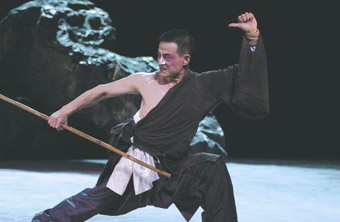
Wu Hsing-kuo, Lear, Legend Theatre
courtesy of the artist
Wu Hsing-kuo, Lear, Legend Theatre
TO A CHAOTIC, CLASHING MUSICAL JANGLING, WU HSING-KUO ENTERS THE STAGE DRESSED IN A FLAMBOYANT CHINESE SILK ROBE DECORATED WITH RED FLAMES. HE JERKS AND ROCKS BACK AND FORTH ON HIS CURVED-SOLED PLATFORM BOOTS, FLINGING HIS MANE OF WILD HAIR AND FANNING A WAIST-LONG WHITE BEARD IN A COMIC DEMONSTRATION OF UNSTEADY, UNDIGNIFIED OLD AGE. ABOVE THE STAGE THE ILLUMINATED SUBTITLES READ: “ACT I: THE PLAY (KING LEAR).”
The chronology has been compressed. Lear is already on the heath, at the climax of his insanity triggered by his betrayal by daughters Goneril and Regan, and his regret at disowning Cordelia. One moment, enraged by his loss of respect, he yells: “Dost thou know me?” The next, however he plays peek-a-boo behind his sleeves, humorously embodying Goneril’s “old fools are babes again.”
In the tradition of Beijing Opera, the monologues in Contemporary Legend Theatre’s one-man production are spoken and sung in Mandarin. Little of the original play’s script is replicated verbatim and the audacious decision to rewrite Shakespearian dialogue demonstrates the confidence and creativity of this Taiwanese company, which aims to reinvigorate traditional art forms by recontextualising classic stories and producing genuinely intercultural productions.
There’s a surprisingly postmodern moment when Lear removes his wig and beard revealing Hsing-kuo underneath. “You’re not Lear!”, he tells these props, implicating himself—the actor who plays no less than eight characters in this performance—in this struggle for identity. Self-strangulation submerges Hsing-kuo’s personality and with a minor costume alteration he is transformed into the virtuous nobleman, Kent. Now he speaks of himself as Lear’s “shadow” and “storyteller.” Thus the brilliant weaving of metaphor and double meaning continues.
In Act Two, “The Playing (Fool)”, Hsing-kuo is a consummate jester, amusing us with a fast-paced mixture of physical comedy, linguistic riddles and irreverent impersonation. He sarcastically replays the situation that lead to the king’s demise, where daughters Goneril, Regan and Cordelia must declare they love their father best to get a cut of his kingdom. We know that Regan’s proclamation is a pernicious lie when, dressed in pink skirt, he parodies her moonwalking, flourishing a sequinned rag over her twitching shoulder and begging for a bigger “piece of meat.”
Hsing-kuo’s portrayal of the suicidal Gloucester and the fighting half-brothers, Edgar and Edmund, are equally engaging though more sober portraits. This superb singer, actor and movement artist commands the stage absolutely—as Act Three, titled “A Player: Wu Hsing-kuo”, explicitly acknowledges. In order to depict Lear mourning the needless death of Cordelia, the performer is pared back to his raw abilities. Wearing a simple black cloak, he speaks with unaffected voice and sings without the accompaniment of instruments. It’s a powerful portrayal of a man who has been stripped of everything.
The performance ends with Lear’s death, which is represented by his slow ascent into a column of icy light. This lifting of Hsing-kuo’s limp body from the stage was probably the only way my fixation on this truly amazing artist could be broken.
Contemporary Legend Theatre, Taiwan, King Lear, adapted from the play by William Shakespeare, director, performer Wu Hsing-kuo, Ten Days on the Island, Theatre Royal, Hobart, April 4-5
RealTime issue #91 June-July 2009 pg. 15
© Bec Tudor; for permission to reproduce apply to realtime@realtimearts.net
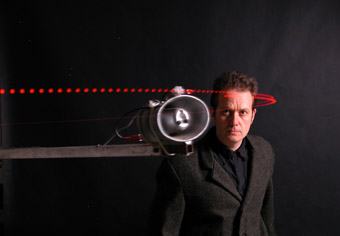
Ray Lee, Siren
courtesy the artist
Ray Lee, Siren
IN A FIELD OF STEEL TRIPODS TWO MEN WAIT AT THE READY. CABLES SNAKE ACROSS THE FLOOR AND STEPLADDERS REST BELOW SOME OF THE TALLEST DEVICES. DOZENS OF HORIZONTAL ARMS OF VARIOUS LENGTHS EXTEND OUTWARDS FROM THE TOPS OF THE TRIPODS, SUPPORTING AT THEIR EXTREMITIES BARE SPEAKERS TIPPED WITH RED LEDS. FOUR FLOODLIGHTS AND A CHAIN OF YELLOW LEDS, FORMING A CORDON AROUND THE INSTALLATION, PROVIDE THE ONLY LIGHT WITHIN THIS CAVERNOUS WAREHOUSE SPACE FOR SIREN, A WORK BY UK ARTIST RAY LEE.
With the efficient air of a technician at work, one man steps up to a device and switches it on: “BAAaaaaaaaaaa…” A single bold note is delivered into the still atmosphere. The musical quality is like that of a piano accordion, yet it is so perfectly pitched and consistently sustained that the source can only be artificial. As each instrument is brought to life, small torches and screwdrivers are used to make adjustments and in response to this tweaking the tonal cry of an apparatus rises or drops. Occasionally the hair-raising lilt of an air raid siren is mimicked amidst a building and discordant cacophony.
Wandering around the periphery of this installation, I approach a speaker pointing directly at me and make a remarkable discovery. This instrument’s note travels in a physical beam and when I’m in its trajectory all other noise peels away so that, despite the soup of sound around me, a single pure note is all I hear. When the workmen set the mechanical arms spinning, this phenomenon of physics, the Doppler effect, creates even more astounding results. Like the mythical siren song, for a time I hear female voices. Later, it’s a repeated orchestral cadence. Yet the synchronicity that creates these impressions is ephemeral and the beautiful illusions break down, disintegrating back into the thick aural chaos from which new patterns build.
This sensorial bombardment morphs and builds for almost 40 minutes, the tension exacerbated by the urgent flailing of apparatuses. So at the performance’s climax when the main lights are cut, the vision of tangled red tracings created by the spinning LEDs is a glorious visual delight. This magical final scene—free from mechanical operations that hitherto focused my attention—sketches in three dimensions the environment of artificial sound that’s been built before me.
The performance ends and I am thrust brusquely back into reality with an unceremonious flood of houselights. My eyes struggle to adjust, my teeth and inner ears are aching and my sternum still buzzes with vibration. I feel pummelled and perforated, not just physically, but also emotionally. Exiting into the dark Sunday evening, I’m overwhelmed with something like loneliness. The inhuman quality of this beautifully strange encounter leaves me thirsty for the warmth of human contact.
Siren, creator Ray Lee, performers Ray Lee, Harry Dawes, Queen Victoria Museum & Art Gallery, Inveresk, Launceston, Ten Days on the Island, March 27-April 5
RealTime issue #91 June-July 2009 pg. 15
© Bec Tudor; for permission to reproduce apply to realtime@realtimearts.net
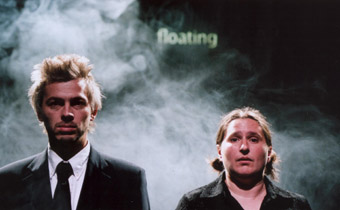
Hugh Hughes, Sioned Rowlands, Floating
photo John Baucher
Hugh Hughes, Sioned Rowlands, Floating
“HELLO EVERYONE!” HUGH HUGHES, THE CREATOR-PERFORMER OF FLOATING (FROM ANGLESEY, AN ISLAND OFF WALES) SMILES DISARMINGLY AT US ALL FROM FRONT OF STAGE. THE HOUSE LIGHTS ARE UP AND WE ALL SAY ”HELLO” BACK, IF A LITTLE SHEEPISHLY. “THIS SHOW IS ABOUT MAKING A CONNECTION.” HIS GRIN WIDENS AND HE WHIPS A SQUARE OF LAMINATED CARD OUT OF HIS POCKET. THE WORD “CONNECTION” IS HANDWRITTEN ON IT IN CAPITALS. HE GOES ON TO DESCRIBE, IN HIS WELSH BROGUE, HOW WE HAVE ALL MADE A “CHOICE” (ANOTHER CARD PRESENTED) TO BE HERE TONIGHT AND THAT FOR A MOMENT HE WOULD LIKE US TO FORGET EVERYTHING OUTSIDE OF THE WALLS OF THE THEATRE.
It could be said that every artist aims to make a connection with their audience, ranging from lodging an interesting proposition to leaving any one person transformed. Three Ten Days on the Island shows—Floating, Evolution and S20—explore the idea of connection in ways that push the comfort envelope.
I don’t think I’m alone in wanting to shrink in my seat when confronted with participatory theatre. “No”, I cry in cowardice, “I want to be entertained, not be the entertainment.” The first few minutes of Floating are loaded with this fear. The show is a fantastical, low and high tech extravaganza devised to tell a ‘what if’ tale about the day the bridge connecting Anglesey and the mainland fell down, thereby setting the isle adrift in the Atlantic. With Hughes playing himself throughout and co-performer Sioned Rowlands flitting between characters, the pair first lead us painstakingly through all of the components of their story using props that include a few sticks of furniture, key pieces of clothing, a Powerpoint presentation, a slide projector, two screens and a large tub of water. They engage audience volunteers to connect with aspects of the imminent story from the comfort of their seats, handing around items like an inflated globe of the world, old wrestling magazines and a ‘clicky ball.’
Floating is a beautiful exercise in making do and getting by in order to tell a vast adventure of an island let loose in the Atlantic and it sits somewhere between theatre, school lesson and Powerpoint lecture. Beginning shrunk in my seat, I found myself sitting taller, engaging in the madness and delighting in being part of a room full of giggling adults. Ironically, once Hughes and Rowlands actually fell into the throes of their story telling, they slipped away from the interactive atmosphere which I felt was the heart of the show and my attention drifted like their island. Once they had followed Anglesey through a delightful loop of the Atlantic and Arctic oceans—including Hughes being temporarily snap frozen in the Arctic—the isle was returned to its rightful place and the players refocused their attentions on the audience. I’ve wondered since, what made this interactive experience different and I think it’s that these players were upfront about the discomfort, mitigating it with humour and charm. Having successfully dissolved that membrane between stage and seat, the show didn’t really end. Hughes had to cheekily tell us that we should probably ‘get back out there’ when nobody wanted to move from their seats. Many hovered outside, holding to this temporary bubble of community.
While interaction is not compulsory, I’m caught in the gaze of Patricia Piccinini’s Big Mother. Her liquid, brown eyes stare directly at me and in them I think I see pain, longing or perhaps conflict. A suckling human baby at her breast, this creature’s bodily characteristics mix human with ape. I find it hard to look away. I’m very familiar with images of Piccinini’s work, but I wasn’t prepared for the prickling, emotional sensation of standing in front of this life-sized primate built from silicone and animal hair.
In a coup for the Tasmanian Museum and Art Gallery, Piccinini has mounted a large collection of her work in a show titled Evolution, including several custom-made pieces. Drawing from her family of creatures in silicone, automotive and video format, the works are spread throughout the entire museum, including witty installations within the colonial, archaeological and popular biological collections. The latter is where Bottom Feeder now lives—a small creature standing within one of the dioramas—its fleshy bottom presented to the room and its small shark-like head peering at us from behind.
Catching a lengthy floor talk by the artist, I’m equally surprised by Piccinini’s presence. Expecting someone cool in more ways than one, instead here is a woman who appears to wear her heart and her beliefs on her sleeve. Rather than trying to scare people with nightmarish visions of the future, she talks of her desire to present solutions to problems. For example, her Surrogate Mother, which has multiple pouches on her back, tiny clawed feet emerging, has been imagined as a safe way to raise hairy nosed wombats, thereby saving them from extinction. She says, “I hope that my work evokes a gut response.” It did.
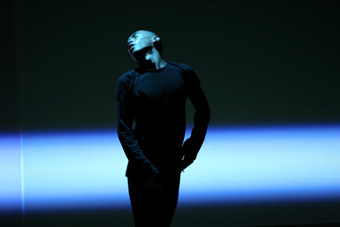
Hiroaki Umeda, while going to a condition, S20
photo Julieta Cervantes
Hiroaki Umeda, while going to a condition, S20
Moving from unexpected comfort to its opposite, Japanese dancer Hiroaki Umeda suggests that his work is devised to strip thought in favour of pure, physical experience. The work comprises three distinct, yet linked pieces, exercises in bitter-sweet endurance—loud, silent, frustrating, uncomfortable, discordant, repetitive, meditative, poetic and delicate.
In the first work, Duo, Umeda barely moves from the one spot in front of a screen. Front lit, he and his sharply outlined shadow are twinned with a life sized digital avatar projected in real time onto a screen to his left. Initially he is completely still within the wall of white noise that greets our ears. We watch, we wait. What follows is dance that mirrors contemporary life, where we may find ourselves watching a screen version alongside nearby reality. Umeda’s fine movements, tiny flicks of the hands or legs, are utterly controlled and elegant, and yet my eyes constantly shift to his mimicking digital self, that is more flicker than flick. As the energy of the dance increases, the avatar is more manipulated, breaking into white noise or slowing such that the sweep of his digital arms leaves a painterly trace. Throughout, the blips and bass beats of the accompanying soundscape are loud and deep enough to resonate within the bodies of the audience.
Umeda’s last piece, titled While going to a condition, tests the bounds of our attention. With Butoh-like concentration, Umeda builds the work slowly. From complete stillness, he gradually layers in repetitive movements. Lines across the two screens behind him continually shift between notional column, arch, field and horizon, creating a space for the work. I find myself lost within the performance and its ‘noise scape’, my thoughts drifting. It’s difficult to remember Umeda’s exact movements, but I still register the feeling of muddled anticipation, as though we are wading towards a release, which eventually arrives after minutes of intense strobing. Umeda’s tight movements give way to fluid, passionate, exhausting dance madness, then return to silent stillness as the work ends. I, for one, sigh with a mixture of relief and respect. Umeda pants with exertion as he bows in thanks.
“Remember, the more you put in, the more you get out of it”, intones Hugh Hughes with a parental note in his voice and I feel that this is true for all of these works. Surrendering to Umeda’s wall of noise, Hughes’ moments of “connection”, or a Piccinini hybrid’s eyes provided for unique, if not always comfortable experiences. Registered in my body in ways that go beyond the cerebral, they’ve stayed with me—like tiny art scars.
Hoipolloi Theatre, Floating, creator-performers Hugh Hughes, Sioned Rowlands, Playhouse Theatre, April 2-5; Patricia Piccinini, Evolution, Tasmanian Museum & Art Gallery, March 14-June 14; S20, Duo & while going to a condition, creator-performer Hiroaki Umeda; Montevideoaki, Hiroaki Umeda, video Octavio Itube, camera Miguel Gromponse; Peacock Theatre, March 27-29
RealTime issue #91 June-July 2009 pg. 16
© Judith Abell; for permission to reproduce apply to realtime@realtimearts.net
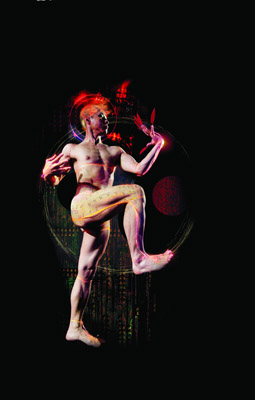
Daniel Yeung
courtesy the artist
Daniel Yeung
THE UNTITLED DOUBLE BILL WITH DANIEL YEUNG AND RAKA MAITRA FEATURES INDEPENDENT SOLO PERFORMANCES BY THESE TWO ACCOMPLISHED DANCERS. WITH YEUNG BEING FROM HONG KONG AND THE INDIAN-BORN MAITRA BASED IN SINGAPORE, THIS TEN DAYS ON THE ISLAND EVENT REPRESENTS A SELECT SAMPLE OF ORIGINAL CONTEMPORARY DANCE FROM ASIA.
Yeung’s Medi.C proposes applying healing principles from traditional Chinese medicine to the body, mind and soul of New China. This ambitious concept is explored through highly energetic, virtually non-stop movement. Yeung’s scantily-clad body is nimble and flexible—running, bending, spinning, pivoting and cartwheeling in a veritable demonstration of the physical abilities of a human body in its prime.
Moving image projection, with a rhythmic soundtrack of industrial and bodily noise, is central to Yeung’s performance. He engages with a low-positioned projector to create a series of fantastic visual effects with and on his body. When the apex of split and mirrored cityscape footage aligns with the centre of his chest, he appears to speed through time and space. Later, his form becomes a pulsing network of multicoloured meridian pathways.
Yeung is constantly tethered to the audio-visual components of his production. For the most part, his synchronisation is a testament to his supreme discipline as a physical performer. On the few occasions where his timing fails I am conscious of watching a routine that has, perhaps, been too strictly choreographed. Yeung’s background in visual art may account for his intellectual approach to dancing, and his concern here to integrate his artform so tightly with other media.
In contrast, Raka Maitra’s performance—an exploration on the theme of water—is a freer, slower paced and more evocative experience. Digital projection is employed with greater delicacy, abstract imagery being projected downwards onto the stage floor creating a series of ‘pools’ to be traversed. Maitra’s journey is both psychological and emotional: she begins by ‘floating’ in a foetal position, glides and struggles through various tidal forces, and eventually stands with her face turned joyously into the rain.
As a dancer, Maitra is more accessible to her audience than the disciplined Yeung. Her body is the primary tool of communication and accordingly her movement, rather than any other element of the production, holds full attention. Though her curvaceous form is veiled in a full-length crimson dress, Maitra moves articulately, full of femininity and strength. The influence of Odissi and Serraikella Chhua, traditional dance forms derived from martial arts, brings qualities of the warrior to her often earthy and primal physical expression.
These are disparate performances exploring the flexibility of dance as a communicative and inherently visual medium providing raw insight into the potential of two rising contemporary dancers.
Daniel Yeung and Raka Maitra; Ten Days on the Island, Earl Arts Centre, Launceston, April 4-5
RealTime issue #91 June-July 2009 pg. 17
© Bec Tudor; for permission to reproduce apply to realtime@realtimearts.net
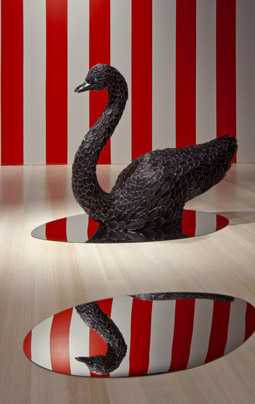
Installation detail, Hospitality, Icelandic Love Corporation
photo courtesy Ten Days on the Island
Installation detail, Hospitality, Icelandic Love Corporation
WALKING INTO ICELANDIC LOVE CORPORATION’S HOSPITALITY IS LIKE ENTERING A SURREAL CIRCUS TENT. MIRRORS REFLECT RED AND WHITE STRIPED WALLS, AN OVERSIZED JEWEL-EYED SWAN RESTS BENEATH A DISCO BALL, WHILE A PROJECTED VIDEO PROVIDES A HARMONICA SOUNDTRACK. THE OPENING NIGHT PERFORMANCE ADDS TO THE SENSORY OVERLOAD, WHEN THE ARTISTS’ SPECIALTY COOKING FILLS THE SPACE WITH THE AROMA OF SPICY FRIED PASTRIES. IT’S AN UNLIKELY AND OVERWHELMING ENVIRONMENT, AND YET THE PARTICIPATORY PERFORMANCE TURNS THE OTHERWISE ANXIETY INDUCING SPACE INTO A WELCOMING AND FUN EXPERIENCE.
The Icelandic Love Corporation (ILC) is a collaborative trio of female artists Sigrún Hrólfsdóttir, Jóni Jonsdóttir and Eirún Sigurdardóttir who work across a range of mediums but are most renowned for their performances. Their art is celebratory and humorous, exploring themes of love and the unexpected.
Elements of play are evident everywhere in this bizarre exhibition. Amidst the uneven lighting, the giant black swan and a velvet tent are dramatically spotlit. Hand crocheted eggs nestled within the dark tent require some co-ordinated bending to view. Those of us wearing skirts at the opening avoid the perilous egg-shaped mirrors on the floor. The disco ball is a quirky addition although, disappointingly, it doesn’t throw any light against the walls.
The objects, clustered in the centre of the gallery, take up little floor space but the carnivalesque red and white stripes fill the walls, breaking down the seriousness, and emptiness, of the gallery’s white cube, creating an illusion of intimacy.
The video, A Black Swan, projected onto the only unpainted section of the wall in an uncomfortable location, opens and closes with animated red and white striped curtains that rhyme with the surrounding walls. It’s a somewhat tragic but simultaneously humorous tale, which conveys the ILC’s mantra: “Love conquers all! The future is beautiful.” The story is closely related to the exhibition’s title, Hospitality, exploring as it does the topical issues of unwanted foreign guests and fear of the unknown.
The native Australian black swan is believed to pose a threat to the native European white swan, and the killing of black swans is actually encouraged in Denmark to prevent interbreeding, which would apparently result in grey swans. In the video, we follow the journey of a crudely animated pair of black swans departing Australia. One is shot as they pass over Europe and, after briefly meeting a white swan, the lonely bird is plunged into a fiery landscape of crocheted flames. Eventually, the reluctant bird exits through a barrier where it meets a white swan, falls in love, and after caressing and contentedly curling up together, they eventually morph into grey scale birds—the dreaded half-breeds. The quirky symbolism, jerky animation and simple harmonica soundtrack are quaint, and the inclusion of the crocheted flames and other craft references connect the animation with the rest of the exhibition beyond the swan subject matter.
Googled, The Black Swan Theory refers to an unpredictable, unexpected but high-impact event or occurrence. In Europe, it was long assumed that all swans were white, and the term ‘black swan’ was used as a metaphor for something that did not exist. However, when Europeans discovered the native Australian black swan in the 18th century, this long-held belief was destroyed. The term can be widely applied,for example to the literary phenomenon of Harry Potter, 9/11, the current financial crisis or the introduction of rabbits and cane toads into Australia—all entities and incidents that seem foreseeable in hindsight. Hospitality doesn’t appear to explore the theory per se, despite the suggestion of the text accompanying the exhibition. However, the video does relate to the origins of the theory, and the exhibition certainly tries to create an unexpected gallery environment by combining a selection of improbable images and objects.
The performance appears quite disconnected from the exhibition. It involves an inverse interpretation of the notion of hospitality. Our Icelandic ‘guests’ set up a temporary kitchen at one end of the striped gallery, cooking for their ‘hosts’ traditional Icelandic deep-fried pastries, or Kleiners, which are to be accompanied by a glass of cold milk. Unlike regular openings, where the exhibiting artists mingle with the viewers, there is little personal communication between the ILC and us. The trio stand behind a table, churning out the cardamon spiced treats, handing out copies of the recipe, complete with crude illustrations, for us to try at home, and stopping people as they try to walk away with wine rather than milk. As someone who is unable to drink milk, I’m one of the many who is pulled up; and while I’m embarrassed at the time, on reflection I realise that this is not the first time I’ve felt the uncomfortable predicament of whether or not to refuse food that people have hospitably cooked for me at the risk of my feeling sick. This familiar, and yet incredibly personal, dilemma, whether or not to offend, made the performance for me. While I understand that there are probably good reasons why there was no documentation of the performance shown during the four-week exhibition, it’s a shame that most viewers were oblivious to what I felt was the strongest part of Hospitality.
Apart from the performance, I found myself engaging with the exhibition rather intellectually, marvelling at the kitsch, the effect of the striped walls, the shine of the swan’s beak. I don’t necessarily see this as a bad thing. Hospitality is a fun experience, living up to the ILC claim that they “like to have a dialogue and discussion with [their] audience and humour is a good way of doing that.”
The Icelandic Love Corporation, Hospitality, CAST gallery, Ten Days on the Island, Hobart, March 26-April 24
RealTime issue #91 June-July 2009 pg. 17
© Lucy Hawthorne; for permission to reproduce apply to realtime@realtimearts.net
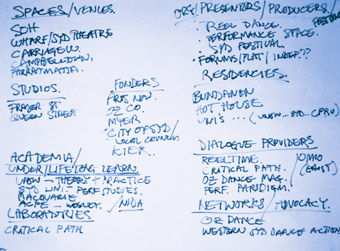
White Board, Where is Independent Dance in Sydney? Symposium
photo Erin Brannigan
White Board, Where is Independent Dance in Sydney? Symposium
The flotsam washed up on an Adelaide beach and collected by photographer Narelle Autio, as displayed on the cover of this edition of RealTime, becomes material for her faux taxonomical reverie on the peculiarly consoling if sometimes disturbing beauties of transience and decay (p54). There are times when artists themselves feel like detritus tossed about and discarded by economies in flux and the restructurings of funding bodies. In RealTime 90 we bewailed Arts NSW’s application of callous funding criteria and its abandonment of the independent dance sector [p22]. In a message to artists, performer Jeff Stein, disturbed by the millions spent by Events NSW on the first Vivid Festival while the small to medium arts sector languishes, aptly proposed a counter-festival titled Gloom. Stein regards it as hypocritical that “the NSW Government through Events NSW is celebrating how creative Sydney is at the same time, through Arts NSW, increasingly not supporting the arts, especially the small to medium sector, which is really struggling.” In this edition we focus on arts infrastructure issues in Sydney: the survival of the independent dance sector, the ennabling role of the Queen Street/FraserStudios spaces for artists [p21], and the visions of the directors of Performance Space and CarriageWorks [p19-20] so critical to many of Sydney’s innovative artists. The emergence of independent creative spaces like Red Rattler in the inner west [p27] and the growing strength of adventurous and supportive arts centres in Sydney’s west, provide new hope for artists. Marcus Westbury’s extensive Catalyst forum program at the MCA capitalises on a city brimming with invention. But unless basic issues of subsistence and survival for the small to medium arts sector are seriously and formally addressed by the NSW Government, the city’s under-funded innovators may well be washed up on the shore of lost hope.
RealTime issue #91 June-July 2009 pg. 1
© Keith Gallasch; for permission to reproduce apply to realtime@realtimearts.net
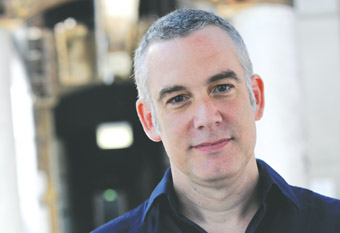
Daniel Brine
photo Heidrun Löhr
Daniel Brine
DANIEL BRINE HAS BEEN IN THE JOB AS DIRECTOR OF SYDNEY’S PERFORMANCE SPACE FOR SOME SIX MONTHS. HE’S AFFABLE, BRISK AND ENGAGING, RECENTLY FACILITATING SESSIONS IN THE WHERE IS INDEPENDENT DANCE IN SYDNEY? SYMPOSIUM (P22) WITH REASSURING EASE, ENSURING A CONFIDENT RESPONSE FROM PARTICIPANTS.
Now that he’s settled into his new role and is deeply immersed in creating the organisation’s business plan for 2010-2012, it seemed timely to ask about his developing vision for Performance Space, including his thematic approach to programming, a public program for building the artist-audience-Performance Space relationship and publishing possibilities that will expand and deepen our responses to artists’ work.
But I also wanted to ask Brine about the origins of his fascination with and commitment to interdisciplinarity, not least because it gives us a stronger sense of him as curator, programmer and director working closely with artists in a range of circumstances here and overseas, but also because his career is tied intimately to the recent history of interdisciplinary and hybrid practices. Brine’s responses to my questions follow in this edited version of our conversation.
vision, practicalities, discourse
Vision is a difficult word. I think the challenge is making things happen. In the last few years Fiona Winning (former Performance Space artistic director) focused on the transition to CarriageWorks. I think there’s a real challenge to match vision with what’s actually practical and possible within the constraints of where we are.
The way I’ve imagined things happening has been flavoured by what I’ve heard people talking about since I’ve arrived. I’ve found them really interested in the way discourse and discussion can be central to work. This is something that I’ve said I want to make central at Performance Space. So part of the vision is about trying to integrate discourse and discussion much more fully with the program, not just tacking an artist’s talk on the end of a show. I’m interested in ways that we read work, the ways audiences come to work and how that can be informed by things other than just sitting on a seat and watching it.
This is partly about how we understand programs of work and, specifically, the four discrete seasons Performance Space has at CarriageWorks. The four seasons idea is a practical solution financially but it also offers us programming opportunities in the ways we curate performance, finding threads of interconnection between the works. In a season we’ll have, say, four performances in Bay 20, plus an exhibition and a couple of residencies. It’s not big, so different sorts of discussions around different sorts of works can come together at one time. The loose thematic is the structure that we’re beginning to play with. But the works will inform the thematic rather the thematic dictating the work we select.
Were starting with umbrella themes. For instance, in 2010 we’re calling the first one You Are Here. Essentially it’s about location. We’ve been looking at works that make sense within that, gathering them together, going back to look at the theme and see if we can tighten it, re-define it and maybe call it something else. So we’re seeing how work and theme inform each other, which is our process of curating performance. Of course, questions of interdisciplinarity and risk, inclusion of practice that might be excluded by other critical frameworks, these are founding principles within which Performance Space works and these remain core to what we’re doing.
The second theme will be Generations—what it means to be part of a generation, a group of people of the same age and experiences. But also it might be about rejecting traditions or passing the baton between generations. The third Theme is Live Works—questions of things that happen in the world that you don’t really quite understand—with a focus on small works of performance art or live art. The final season we’re calling Rights and Responsibilities, drawing a little on the Performing Rights work that was done with the Live Art Development Agency and the Queen Mary University of London. They’re the four areas we’re looking at. For early 2011 we’re thinking ahead about sci-fi, utopias and distopias, all rolled in together.
the art life
I was born in Melbourne, lived in Edinburgh until I was six years old, then in Adelaide from 1972 until the early 80s. I did the full Architecture Degree, but I knew towards the end that I probably wasn’t going to practice and that I would be going down the route of architectural historian or architectural critic of some kind. But I couldn’t make a penny writing about anything and sort of fell into a job at the Australia Council. My very first job was working on a scheme called Community Environment Art and Design. That was looking at the intersection of visual art, public art and architecture. As soon as I was at the Australia Council I felt very much at home, really interested in practices and what was happening with artists. I was very lucky to work on the international program. It was a fantastic introduction to the visual arts in Australia. I was there for about three years.
At that time in Australia there was a movement in craft criticism, looking at questions of interdisciplinarity. A university, gallery and craft association consortium won one of the tenders in Australia Council Contemporary Craft Curators Scheme and I got the job. For me it was really interesting because it was about interdisciplinarity. I ended up writing my Arts Administration Masters on questions of interdisciplinarity in craft. My first show was called Homocraft (1995). I still think it was quite a good show. It was about the ways that artists’ sexuality was informing their practice using signs and symbols—signifiers and codes with a history, especially in gay communities.
I didn’t do that job very long because my partner was offered a residency in New York so I went to New York and did a stint at the American Craft Museum. And I enjoyed New York. I felt really liberated. I very much enjoyed the research at the museum. I liked being part of the institution. The craft wasn’t necessarily the sort of work I was interested in but I was learning a lot about collections, management and patrons.
In Australia I’d been offered the job as curator of the Tamworth Fibre and Textile Biennial so I was finishing that off while in New York. I’d selected the show before I’d left, did the catalogue in New York, came back to Australia to hang the show, went back to New York and started to look for jobs in the UK where I had family connections. I applied for a job in what was called the Combined Arts Department of the Arts Council of England. I got that job, principally I think because I could talk about interdisciplinarity.
from combined to live arts
The Combined Arts Department was a really weird mix—it was where arts centres, disability arts and multi-disciplinarity arts were housed. But the department had an Interdisciplinarity and Live Art wing and I found myself working on that. It was great, introducing me to a whole range of practices—including new media. Digital dance was particularly interesting at that time, a whole range of motion capture stuff going on. Live Art was sitting alongside new media but other artforms were also beginning to dabble in these areas. It was a great scheme to be working on and I got to know a whole lot of artists . Blast Theory, for example, had a strong performance practice in theatres but was just beginning to really push new media boundaries.
I was at the Arts Council when it was restructured, moving Live Art from Combined Arts back to the Visual Arts. The Combined Arts department was scrapped, although there was the creation of an Interdisciplinary Arts Unit. It was an interesting decision to separate Live Art from Interdisciplinary Practice. There are a whole lot of arguments as to why that might have happened, but it was simply a rationalisation and I went with it to Visual Arts. It was an old-fashioned understanding of what live art was [seeing it as performance art].
My ambition at the time was to be working in the field. There was a really good festival in the UK called the Now Festival run by Andrew Chetty. I left the Council and Andrew and I job-shared the Now 2000 festival. It was a great experience. The festival gave Gob Squad some of its first outings. Lone Twin and Blast Theory performed there.
live art development agency
In 2000, Lois Keidan had set up the Live Art Development Agency with Catherine Ugwu. They’d both been at the ICA. London Arts put out a tender for an agency to develop live art. Lois and Catherine bid for the tender and the Live Art Development Agency was formed. Catherine moved on to a very successful event-management business and I joined as Associate Director in 2001. At that point it was quite difficult. We were both working part-time. The agency was very small. We were working two or three days a week, but it was really fascinating. I knew the sort of artists that the agency was working with and it just made sense.
Lois had seed funding to raise the profile of performance in the visual arts field with a plan to hold an event at Tate Modern [Live Culture, 2003]. It consumed Lois and I for a number of years—a fantastic project to work on. And there was always the core of the agency’s work: professional development for artists including a bursary scheme we ran for years. The way we worked at the agency was that each project was set up with a different set of partners. China Live [with live art works from China] was officially a project of Live Art UK, a national network of live art promoters. We selected works as a curatorium, trying to be as inclusive as possible. At the same time, the agency drove it. I put the screening project together. There were other projects: a collaboration with Bluecoat placing performance within the Liverpool Biennial, linked in with working with Guillermo Gómez-Peña who was part of the international program of the biennial, as well as ours and the Tate program. We used his work as a springboard to ask questions about cultural identity in the UK, trying to get away from simply looking at cultural diversity as a question of race, asking broader questions about cultures and coming to the UK.
The fantastic thing about the agency is that we were small and we did everything. I even kept the books for many years. The nice thing about being small is also that you can focus where you want to focus. Lois and I were both interested in publishing so we did as much as we could there. We also established The Study Room, basically our library, for artists to use. It was something that happened organically, providing people with the opportunity to see stuff. I feel really proud of that. It was about cataloguing and saying to everyone we met, “Will you give us a DVD of your work.” We were trying to keep the room practice focused. We didn’t want it to go down the academic route. We wanted artists at the centre of what we were doing. And that’s why that space was really for artists or people who were studying the work.
I think we’ll start some form of library here. As things get going in 2010, we’ll collect material, pinch the Study Room idea and do it in our own way.
the attractor: performance space
I was attracted to Performance Space because there are very few organizations around the world specifically focused on questions of interdisciplinary performance practice, risk and innovation. That’s where I want to stay in terms of the artists I want to work with. After eight years working at the Live Art Development Agency, the model that we had was working extremely well. We’d also decided that the best thing for the organization was to remain small and focused and fleet of foot. I was personally looking for the challenge of working with a slightly bigger organization. There’s something right about coming back to Australia—interesting things are happening here, and I thought it’d be good to come back and be part of it.
programming the public
I think we’re going to try to create a physical space within each season, locating it in Track 12 where we’ll create public programs in the broadest possible sense. Existing events might happen there, like Reeldance’s Cinemoves, where artists gather to watch DVDs. Others will be artist-run discussion groups and other activities. They might be very, very simple. If an artist goes overseas, meets other artists and is interested in their work, brings a DVD back, we provide a space where they can hold a night, show the work, bring people together to discuss it. So it’ll be a mix of us instigating things and hopefully artists saying I want to use the space to do this.
This can also provide a space where audiences can meet. It might be academics from across Sydney who want to discuss performance in some way and want to set up a network in a neutral space. Or it might be local people from Redfern or Newtown coming together around our program. I’m imagining we’ll look at popular forms of engagement, like book clubs, and ask how we might use them. I’m imagining that this is also the space in which the library would happen, so in one corner there’ll be a little shelf that will grow to big shelves over time, where people will deposit materials and others will come and look at them. We’ll have screening and internet services as well and the capacity for small, impromptu performances.
We’re lucky enough to have funding from the Australia Council for a young and emerging producer who will run our public program, a full-time post for 18 months allowing us time in 2010 to experiment with the concept. It’s a risky strategy and we have to animate it to be successful.
publishing & connecting
We want to start to publishing on the web. It’s publishing in the loose sense, providing different ways for audiences to engage with work. I’d love a very short film for every single show we put on with the artist saying why they made the work—a little talking head or a tiny interview, whatever is comfortable for the artist, just to begin to suggest different ways of engaging with the work. I want to find ways for artists to write other sorts of texts. I’m hoping too that for every show we put on we’ll have an artist’s page published on our website—it might be an image, it might be an interview, or a critical text they’ve commissioned, something that they think provides audiences with another way to enter their work. I’d love to keep publishing these and at the end of the year, print them all off in some very cheap and cheerful way, bind them all together and make them publicly available.
a bright future
Sydney’s performance scene has long had a strong sense of community. Daniel Brine’s careful planning holds the promise of opportunities to strengthen and expand it, to develop a sense of its history, especially at a time when a potent new generation of performers is emerging, and to engage more closely with its audiences through conversation and publishing.
Performance Space at CarriageWorks, Sydney, www.performancespace.com.au
RealTime issue #91 June-July 2009 pg. 19
© Keith Gallasch; for permission to reproduce apply to realtime@realtimearts.net
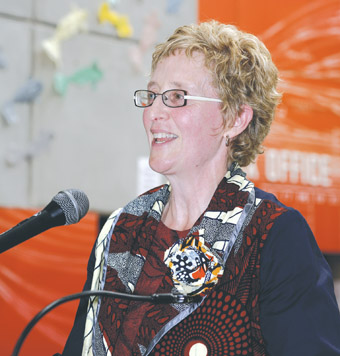
Sue Hunt
photo Keith Saunders
Sue Hunt
NOW IN ITS THIRD YEAR, CARRIAGEWORKS, “SYDNEY’S HOME FOR CONTEMPORARY ARTS AND CULTURE”, IS BECOMING AN ACKNOWLEGED PART OF THE CULTURAL LANDSCAPE. YOU KNOW THIS WHEN TAXI DRIVERS RECOGNISE THE NAME AND HAVE A PRETTY GOOD IDEA WHERE IT IS.
On a recent Friday, the huge Bay 17 housed a contemporary classical music concert by Chronology Arts, Bay 20 a production of Richard III, while in the so-called Tracks, Tess de Quincey performed Ghost Quarters and, next door, spoken word and hip hop artists presented a version of Alice in Wonderland. The vast foyer, at the same time, was crammed with Finders Keepers Market stalls displaying clothing, jewellery, publications and art works by dozens of largely young artisans selling to many hundreds of curious, eager purchasers. This was CarriageWorks, and its cafe and bar, working at full capacity. Its many different audiences (including those for the regular recording of So You Think You Can Dance) and users certainly know where it is.
readiness
The enormous task of opening CarriageWorks, six months on from her appointment in mid 2006, fell to the indefatigable Sue Hunt. With a background as a stage manager and as technical director for the Victorian State Opera for six years, she became the general manager of the Geelong Performing Arts Centre (1995-99) and was senior executive responsible for the business management of the Queensland Theatre Company (1999-2003). She was subsequently Director of Performing Arts for the Sydney Opera House (2003-06).
Asked if she thought her work prior to the CarriageWorks appointment prepared her for the monumental job it became, Hunt replies in the affirmative. “I think I was prepared for this job, in lots of ways. I’d done a number of building projects before if not of this scale. When I was at Geelong Performing Arts Centre, we did a re-fit of the building and I essentially project-managed that. At Queensland Theatre Company, we were funded to find a new home for the company, so I did all of that. I was certainly able to step in and say, I know what a client is, I know what the builders are talking about. I’ve run large and small organisations now and I think that gave me the ability to say, well, I’m creating a small organisation. And I’ve done a lot of work in my practice about organisational development and business improvement. I’ve also done a lot of work with theatre companies, opera companies, in management and production management and producing roles. Working with artists is my first love really—particularly having spent a lot of time as a production manager and technical director, making people’s visions happen, taking the vision of a creative team and fitting that with a budget and a schedule and a theatre and all of that kind of stuff. I always say stage managers are born and I was born a stage manager. And you know, I think stage management prepares you for almost anything!”
In her third year with the organisation she’s still bright eyed: undaunted and optimistic about CarriageWork’s future. Yes, she would love to have more funds to invest in Australian work and attract international productions, but, as with the building of a committed audience, these are long-term goals: “Unless you take a generational view, unless you think 25 years, you’re not going to think of the full potential of a place like this. And that goes to the level of investment that’s been put into it now and needs to be put into it in the future as well.”
the spirit of the place
Hunt thinks that central to the challenge of making the centre work is having a clear sense of it as a unique place: “Our vision for CarriageWorks is that it’s a place for creativity and innovation with a unique spirit. We spend a lot of time thinking about that. What has to be developed, and nurtured, cared about and loved is that spirit, and it comes with artists, resident companies and other users. So CarriageWorks Limited, who run the venue, needs a unique spirit as well. When Arts NSW first showed me through CarriageWorks I was absolutely taken by the size and scale but the thing that struck me most was what was possible for the contemporary arts sector.
“But how do you create something that doesn’t exist anywhere else? I’ll never forget, before we’d even opened, someone asked me: “What model are you basing CarriageWorks on?” I think there was a sense of, ‘Oh well, she’s come from the Opera House; is she going to create another Opera House?’ No. But there isn’t a model for it. There is CarriageWorks with its own sense of place and its unique spirit and geography.”
In terms of geography, Hunt recalls the thoughts of the architects, Tonkin Zulaikha Greer, that came from talking with the reference group, including Performance Space and other resident organisations. “There was a sense of bookending the city. You’ve got the Opera House at one end, which is large and grand and in the place that everyone thinks of as Sydney—the harbour. Generally the Opera House is for more traditional artforms and bigger companies. At the other end you have what will become a hotbed of invention and discovery and creativity. It is already, of course, but it will become known as that. I’d like to see it in the psyche of Sydney in the same way that the Opera House is and I’d like to see it internationally placed.”
audiences and community
Hunt is more than pleased with CarriageWorks’ progress: “Overall we’ve been very successful. We started with virtually no audience. No-one knew us. No-one had profiled CarriageWorks before it opened. So we were starting from zero. For a young organisation, we’ve done quite a bit of market research. We’re thrilled to know we do have a traditional audience that comes with Sydney Festival or Sydney Dance Company shows, but we do have a significantly different, younger profile, which is exciting—children, young adults and through to 35. It’s an audience that a lot of arts companies would kill to have. It comes with a great sense of community. We’re operating at over 80% capacity, and close to 90% activity most months.
“We’re up to nine organisations, including ourselves, that have offices in CarriageWorks. The café is starting to draw people who don’t have any other reason to be there. The diversity, whether it’s Sydney Children’s Festival or the Hip Hop Festival or Underbelly, which we had for a couple of years, or Performance Space’s work in its multifarious ways of being, these all build community.”
strategies & challenges
Hunt’s aim from the beginning, she says, “was to come up with a creative organisation, in and of itself—not a group of centre managers as was suggested to me, or a venue for hire—which assists companies and artists to be creative. What’s important to me is that the organisation learns as well and grows and develops, is adaptive to change and can operate differently. So I think the role of the CEO is to provide that vision and leadership, to keep people following that direction. I let my staff get on with what they need to do.”
A major challenge for CarriageWorks had been its responsibility for developing a commercial strategy for the undeveloped half of the site, but now the State Government has taken that over, which, says Hunt, “makes our job less labour-intensive. We can focus on getting the art space right and it means that we’re no longer responsible for being self-sustaining. We’re responsible for running an arts centre and money will flow to us for that, but the conversation is about how to continue to support and supplement what CarriageWorks needs while the other part is developed, the whole of the North Everleigh precinct and so on. All of that is very exciting. And we’re still deeply involved in the conversation.”
Securing a steady flow of hirers is critical, says Hunt. “Beyond Performance Space, there aren’t a whole lot of regular hirers as there are with venues like the Opera House and other arts centres. So you actually have to generate a lot of activity yourself. We have a producing team of one and a half—an executive producer and a part-time person. They work closely with marketing whose job is about not only shows or festivals we’re presenting but also helping to sell the building as a facility. Then there’s an operational team, which is really about taking bookings, contracting, planning all the events and delivering them, whether that’s front or back of house. Then there’s a finance person. So there are 14 or 15 people now and that’s about the level that we think will be sustainable. It took us the best part of 2007 to put in place the basic team. We’re really only just getting stable now and thinking what is sustainable, that means people don’t have to work 60 hours a week. The team feels like it’s a team.”
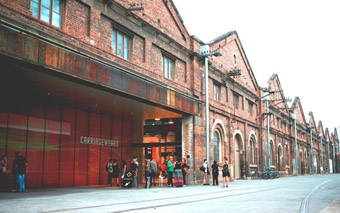
CarriageWorks
photo Keith Saunders
CarriageWorks
programming & investing
With its four annual seasons occupying the second of the performing spaces, Bay 20, the gallery and the rehearsal/workshop Tracks, Performance Space is a key resident—”the kernel of CarriageWorks’ contemporary arts focus”, says Hunt emphatically. From the beginning she thought that “what was important was not to double up on what Performance Space was doing, not to risk their program in any way. So then, we asked what’s an audience interested in within contemporary culture? What does an audience, rather than an artist, want to see in this place? Then, where’s the next bright thing coming from? So although we don’t have the ability right now to present a lot of work, we’ve been able to put in place some capped investments. Virtually every time we’ve said to those artists, you keep the box office, because their ideas and work came to us unfunded. We partnered companies and events that no-one had heard of at the time: The Rabble, Rinse Out Incorporated, Underbelly, Street Art. Hopefully, one day we will be able to support more works, bring in shows from Brisbane and Melbourne and overseas—because that’s an important part of getting an international focus. But right now we’re into a staged approach, with growth from within. We’ve been able to commission resident companies. We were able to put some money into developing ERTH’s Petting Zoo from an outdoor show to a theatre show; we’ve co-presented with Force Majeure; we’ve been able to present Stalker’s Stiltbreak as part of the Hip Hop festival and we’re co-presenting Marrugeku with Performance Space later in the year.”
In 2008, CarriageWorks generated an impressive 65% of it revenues, with the State Government providing the balance. “It’s pretty amazing for the second year of operation. Funding doesn’t cover all of our base fixed costs, so we’ve got to top that up and then what we’ve got left, we’re able to put into programs.” Hunt says that CarriageWorks “is a little over-dependent on So You Think You Can Dance in terms of venue rental” but, on the other hand, she’s glad that the organisation “is not reliant on box office in a big way” or on major sponsors, especially given the vulnerability of both areas in a recession, she says, recalling the devastating impact of the early 1990s downturn and the likely impact of the current one. “We’ve got to ensure that that level of venue rental keeps going. Otherwise, that’s when you start to worry.”
Hunt is emphatic that CarriageWorks operates as a state-subsidised organisation: “And that’s as it should be if you decide you want something like this. There’s not one arts centre in this country that isn’t supported by a government. There might be commercial theatres but they’re not art centres. So, being subsidised, that’s as it should be. It’s not a commercial house. It doesn’t have an 1,800 or 2,000 seat space. It doesn’t have a shopping centre above it. It was established for a particular sector and with particular community outcomes in mind—and I use ‘community’ in the broadest sense, of artists and their public.”
the future
Clearly the dream of being a commissioning and producing house rather than a venue for hire, if a strategically curated one for contemporary arts, is deeply attractive to Hunt: “If we were able to be the Sydney presenting home of our resident companies, that would be awesome. I’m sure we’ll get that sort of presentation money together over time; that’s when it will start to feel like it’s the real thing, and if, for example, Force Majeure’s new work premiered at CarriageWorks, then we could set it up to tour around the world. But, as I say, that’s in the long term.”
Hunt is also alert to the challenges faced by artists trying, with limited means, to make the most of CarriageWorks’ large spaces and technical and safety demands, a point strongly made by Fiona Winning in her 2009 Rex Cramphorn address. Early on came the realisation, says Hunt, that costs would be beyond some groups and that partnering would be essential, and there was a lot of it, she points out, in 2007 and 2008. Some artists—Tess de Quincey, Joey Ruigrok Van Der Werven, Song Company (for their bracing Easter performance, Tenebrae, have excelled at exploiting the massive foyer; and Alan Schacher transformed Bay 20 for The Bland Project. As Sue Hunt keenly points out, CarriageWorks uniquely offers opportunities for artists that yield audience responses like, “Oh my god, I couldn’t have seen that anywhere else.”
With its distinctive programming strategies, including a broad contemporary culture ambit (embracing hip-hop, huge street art creations, experimental music, works for children and special events like a photo exhibition “giving youth a say about Hepatitis C”), CarriageWorks, together with Performance Space’s radical explorations, indeed provides a home for diverse contemporary practices and audiences. Of course, neither organisation can meet all the needs of the growing numbers of rarely well-funded innovative artists, so it’s not surprising that new, smaller creative spaces are opening up, not least in Sydney’s inner-west (see p21). But it’s CarriageWorks above all that provides an invaluable, supportive gathering point for embracing and promoting contemporary culture in a city brimming with it.
CarriageWorks, Sydney, www.carriageworks.com.au
RealTime issue #91 June-July 2009 pg. 20
© Keith Gallasch; for permission to reproduce apply to realtime@realtimearts.net
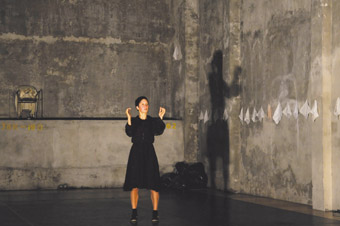
Alexandra Harrison, Dark, Not Too Dark, creative development at FraserStudios, Feb 9-27. Harrison will continue this development at Performance Space August 17-28
photo Heidrun Löhr
Alexandra Harrison, Dark, Not Too Dark, creative development at FraserStudios, Feb 9-27. Harrison will continue this development at Performance Space August 17-28
CHIPPENDALE HAS BEEN A HUB OF POOR BUT HAPPY CULTURAL ACTIVITY FOR A WHILE NOW. FIVE YEARS AGO, YOU COULD DO AN ART CRAWL OF AMAZING VENUES, ALL WITHIN THE FEW BLOCKS RUNNING BETWEEN CLEVELAND, ABERCROMBIE AND REGENT STREETS. PERFORMANCE SPACE DELIVERED PERFORMANCE, DANCE, MUSIC AND VISUAL ART; SPACE 3 OFFERED VISUAL ARTS AND IMPROVISED MUSIC; PELT CONCENTRATED ON SOUND PERFORMANCE AND AUDIOVISUAL INSTALLATION; AND FURTHER DOWN IN THE VALLEY LAN FRANCHI’S PRESENTED ALMOST ANYTHING YOU COULD IMAGINE.
Today all those spaces are gone—closed except for Performance Space (the only ‘legal’ venue), which moved to CarriageWorks at Eveleigh. However there is another wave of artists clinging to the few vacant spaces surrounding the massive construction site that once was the old Carlton Brewery on Broadway. Amazingly one of these spaces, FraserStudios, is a direct result of the construction, as the property developers have offered up the old warehouse on Kensington Street as a temporary space for artists.
The project development of FraserStudios has fallen to Sam Chester and James Winter, the tireless duo who have been behind Queen Street Studio, a rehearsal space for hire just around the corner in Chippendale. The pair started Queen Street in 2005 in response to the news that The Fromagerie (formerly Omeo), a well-loved dance rehearsal space in the old silos in Newtown, was set to close. And it was a big and scary venture. Winter says, “when we went through the signing of the lease we had all the people in our lives, including the solicitor we got pro bono, saying ‘you’ll go bankrupt in three months.’” As it was a commercial lease the financial pressures were considerable but within 6-9 months of opening they were operating at 50-70% occupancy, with the majority of hirers being independent artists. Winter believes it succeeded “because we know how we need to be treated as performing artists. We just applied that to how we ran with the business and the fit worked.”
Besides the hard work, and support from friends and volunteers, a key to the early success for Queen Street was a very amicable relationship with the landlords. However this relationship became problematic after the landlords changed their core business and renovated the building, removing the sound insulation. Chester says: “It just goes to show that in a commercial lease situation, that relationship is crucial and when it goes sour, it’s over, get out.”
Chester and Winter decided not to renew the lease on those premises however it was around this time that the City of Sydney and Frasers approached the team to take up the FraserStudio tender. Queen Street had received some small project grants from the City of Sydney and apparently had made an impression. Winter says, “We were really wanting to activate Chippendale as well as the top floor of our little studio. And so City of Sydney were really keen for the program to be delivered by people who were already kind of established, had a connection with Chippendale, and could deliver on what they said they were going to do.”
The pair resisted the offer for a while, wary of the prospect of working with big property developers. Chester says: “Queen Street’s only got a name… We don’t have lots of money.” However once the decision was made it was all action. Chester explains, “We turned it around really quickly. Frasers spoke to us at the end of June, and there was a lot of pressure to get it up. I think we had artists moving in within a month.”
The initial plan from Frasers and City of Sydney was to offer studios for visual artists. However Chester and Winter expanded the brief to include space for performing artists. Winter says “the whole picture involves [the performing arts] community and we’re not interested unless we can make that happen.” Chester continues: “There is no ongoing funding from [Frasers or City of Sydney]. They don’t pay us, we still run it as a Queen Street Project so everything that is created is created by us and administered by us and facilitated by us. So the performing arts space was a negotiated thing. They said we want visual arts and we said okay we’ll deliver that but we want [studio] 12 and 14 to make income so we can subsidise the project.”
As neither Chester nor Winter has a visual arts backgrounds they’ve brought in artist Peter Volich to oversee the visual arts program. Volich says that the studios offer “a fantastic opportunity for artists to work on a specific idea within their practice. Whether it be to prepare and finalise a body of work for exhibition—which many artists have used the residency for—or to develop a seed idea.” Over 30 artists have benefited from the free studio space and Volich believes the calibre of artists has been very high. “There have been a multitude of outcomes for the artists who have worked here: exhibitions both locally and interstate; curators and arts workers who have come in for studio visits etc…”
The performing arts component of the project began in January 2009 and not only is the space available for hourly hire, but there is also a series of subsidised programs, supported by Arts NSW and AusDance, providing free rehearsal space. Interestingly the first round of recipients reads like a list one would have expected from a residency program at the old Performance Space with a mix of established and emerging artists: De Quincey Co, Stalker, Rosie Dennis, Sue Healy, Jane McKernan, Alexandra Harrison, Rolandi Alejandro, Eddie Sharp, Mark Haslem and The Imperial Panda Festival. This program is clearly filling the gap that has developed since the move by Performance Space to CarriageWorks, which has concentrated the programming into four six-week blocks, thus offering fewer residency possibilities. In the light of some current funding imperatives that encourage inner-city artists to work in west and south western Sydney (from whence many artists initially fled), the eligibility criteria for these grants is particularly refreshing giving “priority to local performing artists (defined as inner-city Sydney) whose practice has been disrupted by development in the local community” [Queen Street Studio website].
Other programs are also facilitated by the Queen St team including ToolKit, a series of intensive workshops with artists such as Martin del Amo, Kate Gaul and Linda Luke; and Off the Shelf, a program for writers and directors to develop text-based works. These all reflect the ongoing philosophy of both Chester and Winter, which is about embracing and celebrating the entrepreneurial spirit of artists.
Of course this spirit is reflected in not only the work happening at FraserStudios but across a range of artist run spaces in Sydney. On the other edge of the construction site, Serial Space (initiated by Tameka Carter and Louise Dibben, and now run by Alex White, Zanny Begg and Alice Williams) is ramping up having just received an Autralia Council ARI grant. A few blocks across, Bill & George Studios appears to be thriving. In Marrickville, a dynamic group of women, fed up with the tenuous status of these kinds of venues have gone so far as to buy a warehouse and set up Red Rattler, a totally legal venue for experimental performance [p27]. And there are many more spaces hidden across the city. In fact Rebecca Conroy, one of those behind Bill & George, has recently formed Space Syndicate, a network of 24 independent spaces and intitiatives across the Marrickville and City of Sydney local government areas to lobby for the importance of these spaces in the overall cultural landscape.
Given the City of Sydney’s long-term Sustainable Sydney 2030 plan, The Queen Street/FraserStudio model is being watched closely. At this stage Sam Chester and James Winter are very positive about their partnership with the big end of town. Winter concludes: “We’re talking about a small arts organisation working with a multinational Singapore-based developer. But it’s the realisation that cutting all that status shit away we both have similar objectives in regard to this project. They need to revitalise this street, they need to placate the community and also be seen as being generous in regard to giving space to artists. Those things are important to us… What we have been able to achieve is above and beyond expectation and [Frasers has] actually realised that the people in the arts work extremely hard to make anything happen. I was saying to [a representative from Frasers] today that it’s been a really fascinating relationship. ‘We’ve had to change our perception of you and you’ve had to change your perception of us. But as soon as that’s happened we are actually in partnership.’ It’s a true partnership because we both share the agenda and the agenda is honest. And the agenda is about revitalisation.”
The word at the moment is that Queen Street/FraserStudios will remain active until September 2010 at least.
Queen Street/FraserStudios, 13 Kensington St Chippendale. The fourth round of applications for visual arts studios is coming up in July, and an open day will be held on June 21. www.queenstreetstudio.com/fraserstudios.html
RealTime issue #91 June-July 2009 pg. 21
© Gail Priest; for permission to reproduce apply to realtime@realtimearts.net

White Board, Where is Independent Dance in Sydney? Symposium
photo Erin Brannigan
White Board, Where is Independent Dance in Sydney? Symposium
ON APRIL 7 A SYMPOSIUM FOR INDEPENDENT ARTISTS AND ARTS PROFESSIONALS, WAS HOSTED BY THE SCHOOL OF ENGLISH, MEDIA AND PERFORMING ARTS (UNSW) AND PERFORMANCE SPACE WITH THE SUPPORT OF REALTIME AT UNSW KENSINGTON CAMPUS. WHERE IS INDEPENDENT DANCE IN SYDNEY? WAS SWIFTLY ORGANISED IN RESPONSE TO THE ARTS NSW FUNDING OUTCOMES FOR 2009 ANNOUNCED EARLY THIS YEAR THAT HAD A DEVASTATING IMPACT ON THE LOCAL INDEPENDENT DANCE SECTOR, MAINLY DUE TO A CHANGE IN FOCUS AWAY FROM INDIVIDUALS AND TOWARDS ORGANISATIONS AND PROGRAMS.
The broad aim of the symposium was to create an event where the community could “connect with peers, identify strengths and gaps in provision, and take a proactive role in determining the future of independent dance.” With many people commenting on the novelty of all being together in one room (highlighting the absence of effective social and industry events for Sydney’s dance community), the event was successful in providing a sense of focus and plans for concrete action.
The six hour symposium was attended by some 35 artists and administrators (from long-standing members of the community such as Tess De Quincey and Nikki Heywood to newcomers Rachel Morgan and Rachelle Hickson), and was framed by an opening ‘provocation’ from Julie-Anne Long and ‘case study’ in the person of Emma Saunders. Long talked about perceived or imagined binaries separating the independent community dotted around the inner city from institutionalised dance centring around the harbour; the possibility of choosing independence; and the reconfiguration of this binary to accommodate flows in both directions. Her descriptions of the Sydney Opera House as a UFO heading off out of here, and the Wharf precinct as a liner about to depart for other shores, were images that encapsulated the tenuous nature of current connections with these ‘edifices.’
Performance Space director Daniel Brine guided us through a variety of frameworks for discussion in smaller groups around two major themes: what “we” need (the infrastructure map); and what “I” need (the artist’s map). Topics such as our strength in diversity of practice, the imperative for independents to maintain their status through collective action, the entrepreneurial bent of this group of artists and the ideal of maintaining an uncompromised position in one’s practice produced exciting discussion. And a creative task in personal map-drawing produced some surreal and sometimes frightening results that would be perfect for the walls of the Arts NSW office on Elizabeth Street.
Ultimately, the visual maps with gaping holes and vortexes, along with Emma Saunders’ emotional articulation of everything we-always-wanted-to-say-but-didn’t, brought to the surface much of what had been simmering just beneath for many individuals feeling isolated and disheartened. Having been involved in this community for more than 20 years, it does seem to me the time is ripe for action with so many key players signing up in support. The foundational work done by artists such as Rosalind Crisp at Omeo Studio and supporters of local practice such as Performance Space, One Extra Dance and Critical Path has, over many years, produced a groundswell of activity, bringing in to focus the profound deficiencies in practical and financial support for ongoing practice, production and presentation. I guess we all anticipated what a choreographic laboratory like Critical Path in Sydney would mean; excellent work with nowhere to go.
Things did get a little fuzzy in the sixth hour, but my summary notes emphasise the desire for a clearer articulation of the sector in order to educate funding bodies and have the practice properly valued; to pursue places and spaces where the community can exist and connect; and to seek some relief from administrative work that eats up precious time and resources. Identifying the people and places already negotiating the objectives, such as the inimitable Sam Chester at Queen St and FraserStudios (p21), appeared to be one of the most logical steps forward.
The following is an excerpt from a letter sent to Mary Darwell (Executive Director, Arts NSW) which resulted from the day. It was signed by around 40 members of the Sydney dance community who met a few weeks after the Symposium:
“The sector was alarmed by the application of assessment criteria (audience numbers, financial sustainability) that severely disadvantaged most members without taking into account the challenges faced by the sector. Our gathering recognised that the independent dance community is a strong, supportive one, but that the lack of grants in 2009, the paucity of studio spaces for ongoing training and development of works, the modest commissioning funds at Performance Space and CarriageWorks, the absence of a major University-based School of Dance in NSW, all mean that independent dance artists in NSW work in an anxiety-making, fragmented environment…
“We believe that the issues of the health and future of the independent dance sector, as a whole, need to be taken into account in the 2010 funding round. We urge Arts NSW to consider the recommendations we have made here and those outlined by Ausdance NSW in its issues paper, particularly that assessment criteria be modified so that they are responsive to the actual conditions under which the sector operates; that peer assessment be made by peers; and that Arts NSW partner the sector to address studio space and administration issues.”
Other outcomes of the follow-up meeting included the setting up of a volunteer rotating working group of five (Alexandra Harrison, Nikki Heywood, Sue Healey, Julie-Anne Long and Martin del Amo); sponsorship from Sam Chester at FraserStudios in the form of space for meetings and communications support; and a briefing with Arts NSW regarding the new guidelines for funding released May 15, to be hosted by Ausdance NSW.
Where Is Independent Dance in Sydney?, symposium for Sydney dance artists and workers, facilitated by Daniel Brine, Director of Performance Space and Dr Erin Brannigan, Lecturer in Dance, School of English, Media and Performing Art, UNSW; April 7
RealTime issue #91 June-July 2009 pg. 22
© Erin Brannigan; for permission to reproduce apply to realtime@realtimearts.net
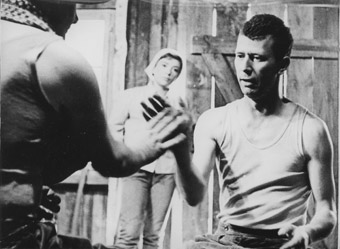
Spur der Steine/Traces of Stone
photo Günter Marczinkowsky
Spur der Steine/Traces of Stone
THE FESTIVAL OF GERMAN FILMS THIS YEAR BENEFITED GREATLY FROM THE PRESENCE OF SIX FILMS FROM THE ‘OTHER’ GERMANY: THE DEUTSCHE DEMOKRATISCHE REPUBLIK (DDR), THE GERMAN DEMOCRATIC REPUBLIC (GDR), OR ‘EAST GERMANY.’
Nestled alongside present-day productions at the festival set in the GDR or pertaining to its legacy—12 heißt: Ich liebe dich/12 Means: I Love You (Connie Walther, 2007) and Novemberkind/November Child (Christian Schwochow, 2008), both of which concentrate on familiar Stasi/police-state stories. Seeing films actually from the GDR puts contemporary treatments into some relief as (with exceptions such as Christian Petzold’s Yella, which screened at 2007’s festival) rather superficial and, perhaps surprisingly after all these years, ideologically determined.
Although Poland, Czechoslovakia and Hungary are considered to have produced more internationally recognised Eastern bloc filmmakers than the GDR, throughout its short existence from 1949 to 1990 its film industry was (as the festival program somewhat condescendingly states) ‘surprisingly’ productive and diverse. The films presented here concentrate on the work of three well-known and respected GDR directors: Frank Beyer, Heiner Carow and Konrad Wolf, none of whom can be considered straight propaganda artists (while being, to different degrees through the years, committed to their new state and its proclaimed socialist ideals even as they inevitably had problems along the way).
Perhaps the most ‘typical’ of these films in terms of socialist folk-heroism is Frank Beyer’s Karbit und Sauerampfer/Carbide and Sorel (1963), which tells the light-hearted story of a manly worker—though given idiosyncratic characterisation as a vegetarian non-smoker—after the war in 1945, who has to transport carbide from Wittenberge to Dresden so he and his comrades can restart a tobacco factory. Through the very accessible form of a comedic road trip (riffing on the chaos of post-war Germany but also, in one scene, a gullible US soldier), the film surveys the GDR at its ‘pre-’stage from a secure (newly Walled-in) future, as we watch Germany’s fragmentation at the hands of new Cold War geopolitics. Almost inadvertently, near the film’s end we glean that our earthy protagonist is a communist—communism therefore coming from ‘the people’ as opposed to being forced on them. This seems to perpetrate the silence that continues today around Hitler’s least discussed victims (which one might naively hope a communist cinema would eulogise), home-grown German communists. Secondly it elides the fact that those who did survive 12 years of Nazism were largely overrun in terms of political power by Soviet officials after the war. Demonstrating well the ‘folk art’ feel-good parable form to which much mainstream communist cinema aspires, Carbide and Sorel‘s historically problematic elements—echoing across the film’s setting (and horrific prior events), the time of its production, and from today’s perspective—make it all the more informative.
Still uplifting in its way but naturally grimmer in tone was Beyer’s and the GDR’s most internationally celebrated film, Jakob der Lügner/ Jacob the Liar (1974), winning a Silver Bear at the 1975 Berlinale (seen as a significant trans-Wall accolade) and nominated for a 1976 Academy Award for Best Foreign Film. Set in the Jewish ghetto in 1944, supposedly one of the first East German films to tackle the ‘Jewish issue’, this story concerns a cranky man who weaves a web of lies about the Red Army’s proximity (after inadvertently overhearing news through a Gestapo office door) and claiming he has a hidden radio. Culminating in Jacob’s improvised ‘broadcast’ behind the wall of an attic designed to convince his niece of their impending rescue (bringing to mind Roberto Benigni’s hugely popular 1997 film Life is Beautiful but without the same sentimentality), the film is interesting for its evocation of the power of imagination and virtuality in the form of productive lies (resulting in a sharply reduced Ghetto suicide rate). While the film typically posits the Soviets as the nascent unseen heroes of the war, in doing so it is hardly less propagandist than most Western films (and in the case of East and Central Europe, much closer to the truth).
The most interesting film, in part because it is actually about the intricate workings of the GDR, was Beyer’s Spur der Steine/Traces of Stone (1965-6), which attained an unintended ‘reflexivity’ when banned a few days into release, due no doubt to a level of moral and political nuance and complexity that almost beggars belief. The protagonists are an ambitious, seemingly liberal-reformist young Communist Party secretary newly in charge of a large construction project, and a cavalier site foreman who leads a bizarrely cowboy-styled band of troublemakers who openly disrespect Party authority and yet are also the most productive workers.
When a young female engineer arrives, both men become involved with her in different ways, resulting in an intricate and measured melodrama while also providing for a slowly building political/morality play, but without pedagogical ‘conclusion.’ By the end, the film’s founding moral universe—both political and personal—has been thoroughly unmoored (hence its banning). All this is rendered via a series of flashbacks made up of carefully framed black and white widescreen compositions. From these we gradually glean information unavailable to a present-tense ‘investigation’ scenario which the film cuts to periodically, featuring Workers Committee meetings where the young Party secretary is essentially put on trial for his personal-meets-political indiscretions (an adulterous relationship and resulting pregnancy the nexus issue).
Traces of Stone exemplifies the ability of some communist bloc films—the wishes of State producers and censors notwithstanding—to inspect an entire system at its coalface. Personal behaviour is intricately connected to political ‘responsibility’, and for long stretches here we see almost documentary images of people sitting in a drab room trying to administer the mysterious investigative mechanisms of bureaucratised socialist life. Somehow such an inquiry is made fascinating from the start, building in tension as combined with the much more elaborately staged flashback scenes. The film ultimately satisfies neither the state nor its critics, and liberal humanism in the form of what seemed a kind of love story is denied through a truly ‘modern’, very open ending. Even the ‘couple’ itself is finally unclear within an uneasy triangle that for a while proved ‘professionally’ very productive. In the end romantic love appears destroyed rather than refined, yet through the characters’ subtly transforming treatment of each other, a certain ethical gravitas, human honesty and empathy—perhaps a broader kind of sober (and properly socialist?) humanist rebellion—is strikingly voiced, even as everyone ends up ‘alone.’
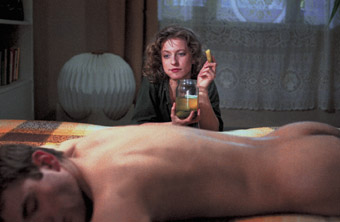
Coming Out
photo Wolfgang Fritsche
Coming Out
Heiner Carow’s Coming Out premiered the night the Wall came down, giving the film’s English-language title another layer of meaning. The portrayal of East Berlin’s late 1980s gay scene is striking (as shot on location with non-actors) in a fairly clear-eyed portrayal of subcultural life. The epicentre of the film occurs when a world-weary old man in a gay bar, after being partly assaulted by the film’s self-obsessed protagonist, offers a lesson—the story of how he became a communist when trying to survive in a death camp (as the Party was the best organised resistance going). After the war he worked to overcome all oppression and marginalisation. Just as this mythology of civil rights heroism is rankling the viewer after decades of real-world Communist bloc oppression, the old man emits a cutting lament: while in time the Jews and other minorities ceased to be victims of systematic persecution, “somehow the gays were forgotten.”
This political-historical level—which may have personal resonance for its gay director—adds not only a much appreciated grit to what would otherwise have been a reasonably familiar story but also invokes the very real sufferings of Hitler’s lesser known victims (if perhaps better remembered now than communists themselves) and their less familiar German story, with strong resonance in ‘free’ countries.
The other Carow film at the festival was supposedly the GDR’s biggest domestic commercial success. Die Legende von Paul and Paula/The Legend of Paul and Paula (1973), an absurdist comedy of sorts, strongly evokes early 70s everyday life and popular culture in the GDR. It also features what we would now call ‘magic realist’ interludes. This aesthetic contrast is echoed in the film’s thematic trajectory, where post-60s romanticism operates alongside a darker tonality. At the heart of the film lies tacit acknowledgment of socio-economic difference as seen through an affair between the clearly better-off Paul, who has a mysterious government job, and Paula, who works in a supermarket, and who live across the same street from each other (the ‘communist’ element of this disparity perhaps). Their affair comes across both as a libertarian rebellion against drab working life and moral-ideological prescription (hardly unique to the GDR then). In some ways seeming more time-locked than the other films here, The Legend of Paul and Paula entertains through its charming performances and absurdist love story (though Paula dies at the end while giving birth to their child) as well as providing a scattershot meditation on the minutiae of life as played out within an urban space that appears both constantly in-construction and in-decay, a perhaps realistic portrayal of GDR city life that nonetheless also offers metaphorical suggestion.
Solo Sunny (Konrad Wolf, 1978) was another huge domestic success, while also travelling well beyond its historical and political origins, and the Prenzlauer Berg locations offer a fascinating visual account of late 70s East Berlin. This story about Sunny, who wants to be a professional singer, at first glance seems to be about ‘losers’; heroism and stardom are certainly missing, while various low-rung entertainment spaces and scenarios familiar to anyone who has ever sought a career in music are in abundance. Yet the film cumulatively offers a ‘realistic’ affirmation of human attempts to live outside the life choices apparently on offer in the society of the day, for the creative effort involved irrespective of ‘success.’ Rather than a tragedy of existential failure or a ‘lesson’ about misguided dreams of bucking against the status quo, the film offers a modest but trenchant hymn of refusal—if its enduring popularity is anything to go by—when faced with a drab social real, no matter what the tangible results.
Irrespective of their varying focus on specific historical and political issues, these films offer both rich, unfamiliar insights into the ‘other’ (in many ways suppressed, since reunification) Germany from the grave, and more broadly resonant meditations on complex social, moral and existential problems that continue to cut across time and space.
Goethe Institut Audi Festival of German Films, Sydney, Brisbane, Melbourne, Perth, April 15-28
RealTime issue #91 June-July 2009 pg. 23
© Hamish Ford; for permission to reproduce apply to realtime@realtimearts.net
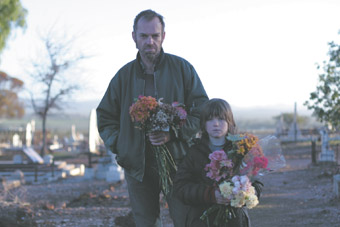
Hugo Weaving, Tom Russell, Last Ride
GLENDYN IVIN’S FIRST FEATURE LAST RIDE, WHICH PREMIERED AT THIS YEAR’S ADELAIDE FILM FESTIVAL, CATCHES THE WAVE OF HIS EARLIER EXPLOSIVE SHORT FILMS. HIS DARK LITTLE DRAMA, CRACKER BAG, SOARED TO THE GREATEST HEIGHTS A SHORT FILM CAN GO, WINNING THE PALME D’OR AT CANNES, A SPECIAL MENTION IN BERLIN AND DENDY AND AFI AWARDS. HIS FOLLOW-UP, THE DESERT, WAS ALSO NOMINATED FOR AN AFI AWARD.
Last Ride (based on the NSW Premier’s Award-winning novel by Denise Young) is a road trip through some unusual and majestically isolated South Australian landscapes, featuring a rough-as-guts Hugo Weaving as father Kev, on the run with his naive but on-the-cusp 10-year-old son Chook (Tom Russell), who just wants to stay put, longing for some sense of stability in his fragmented life.
From the opening scene—an industrial landscape of broken cars, where a lanky-haired kid in a too-big cap plays hide-and-seek with a gun—Ivin delves into the legacy of violence passed down the generations between fathers and sons, his film joining a recent spate of Australian features exploring the internalisation of male aggression: The Square, Ten Empty and Three Blind Mice. Kev is the victim of his own father’s neglect and rage. Although he tries to control it, he revisits the damage on his own son. Ivin’s exploration of this is sensitive and tender. Kev is doing his best with limited resources. The film cleverly holds back key information that will turn our judgement of Kev on its head. Central to this, and revealed in flashbacks, is Chook’s ambiguous relationship with Max (a memorably subtle performance by John Brumpton). Max gives the boy a toy car he always carries, bathes him at night, takes on a more caring father-figure role (or so we think).
But as the film starts to reveal cracks in the landscape, our heart aches for Chook, such a beguiling and sweet boy, as we imagine him hardened by adult betrayals, adjusting to deal with the cruelties and contradictions of the situations he is negotiating daily. As Ivin intends, we wonder how boys like him will end up. But for now, Chook is prepared to ask the hard questions of any adult he finds, to “roll on [his] back and float” when the going gets tough. We hope he stays in that place. But as the landscape becomes more and more impenetrable, we doubt it.
Rolling out languidly, the film sustains great dramatic tension alongside piercing beauty, with gently jangling guitar strings, particularly reminiscent of Wim Wenders’ work, especially the lingering pathos of Paris, Texas where characters drift through landscapes. There are continual reminders of nomadic lives: Kev claims to have Afghani and Aboriginal blood; he and Chook squat overnight in an Afghani museum where the boy steals a ‘magic’ vest for protection; Chook wakes up to a camel licking the front windscreen. Ivin has the confidence to use just the necessary words, the silences cleverly capturing a child’s view of a world he doesn’t completely understand. I’m reminded of Streeton’s Golden Summer painting and Frederick McCubbin’s Lost as the pair camp by a river surrounded by glorious, dead stringybark trees (a seething white mass sculpted to the sky) that dwarf boy and father, becoming a disenchanted forest.
The film’s pivotal moment, where Chook is abandoned in the middle of a lake containing just a few centimetres of water, trudging in an eternal shimmer to the horizon, is truly frightening and visually breathtaking, and makes you want to eat up the landscape whole. All of it reminds us of bigger issues too, the rivers and lakebeds drying up, a planet running out of water. But Greig Fraser’s unique cinematographic vision (and clever use of pull-focus) never distracts from the characters’ escalating tension; it becomes a true part of them. As Ivin notes: “I had already looked in Queensland, and we had been to Broken Hill and beyond on a writing trip, but everything I saw in South Australia just blew me away so we adapted the film to work around this new terrain. A little like how you might develop and rewrite characters after rehearsal, I would go out and find locations and then come back and work them into the script with Mac [Gudgeon]. In this way the script remained quite open and organic right to the very end.”
Working with the same tight-knit creative team as on his short films, Glendyn Ivin has unveiled an exquisitely crafted first feature with all the elements expertly woven and taut performances by Hugo Weaving and first-timer Tom Russell. It should be a hit on the international festival circuit. Let’s hope Ivin doesn’t join the rank of talented filmmakers taking too long to get a second film up and running (like Cate Shortland and Ivan Sen, to name just two of many).
Last Ride, director Glendyn Ivin, producers Nicholas Cole, Antonia Barnard, screenplay Mac Gudgeon, director of photography Greig Fraser, production designer Jo Ford, editor Jack Hutchings, composer Paul Charlier; opens nationally July 2
RealTime issue #91 June-July 2009 pg. 24
© Kirsten Krauth; for permission to reproduce apply to realtime@realtimearts.net
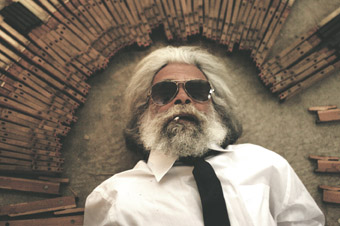
Jack Charles, Bastardy
JACK CHARLES OCCUPIES A NUMBER OF CONFLICTING IDENTITIES: ACTOR, HOMELESS PERSON, HEROIN ADDICT, HOMOSEXUAL, EX-CON, ACTIVIST AND MEMBER OF THE STOLEN GENERATION. HE ADDRESSES ALL OF THESE IN AMIEL COURTIN-WILSON’S DOCUMENTARY, BASTARDY, WHICH FOLLOWS THE INDIGENOUS ACTOR OVER NINE YEARS, TELLING STORIES OF PAST AND PRESENT EXPERIENCES.
When we first meet Charles, he is a homeless heroin addict. We watch in close-up as he injects. He addresses the camera moments after, confidently telling the director that if he hadn’t just witnessed this, he wouldn’t be able to tell that Charles was high. This scene immediately conveys the contrast between Charles’ bearing—his affected English accent, self-awareness, good looks and charisma—and his plight. This enables him to address the mainstream from the position of a fringe-dweller.
Courtin-Wilson, who directed the awarding-winning documentaries Chasing Buddha (2000) and Islands (2000) and whose short fiction CICADA (2009) screened at Cannes this year, again reveals his skills as a filmmaker in this intricately constructed documentary. While the film is visually and narratively fragmented, repeated visual motifs and the soundtrack, featuring several tracks by CocoRosie, bind the film. For example there are numerous shots of Charles walking the streets or travelling across the city by tram or taxi. Bastardy is also interspersed with atmospheric Super 8 footage of inner-Melbourne streetscapes, providing pause between segments of the film and complementing the repeated visual motif of Charles’ movement through the streets.
Bastardy reveals different aspects of Charles’ life and personality gradually. The film comprises archival footage, photographs and recreations as well as footage from the present. This includes Charles addressing the camera directly and guiding Courtin-Wilson to places around Melbourne alongside scenes such as his release from prison. Consequently a narrative about Charles’ life during the making of the documentary emerges next to an exploration of his past.
There is a strong focus on Charles’ physical surroundings in Bastardy, providing insight into his life and allowing the audience to view Melbourne from an alternative perspective. At the beginning of the film, when Charles is living on the streets we see where he sleeps and shoots up. In some of the most entertaining moments of the film, we see him guide Courtin-Wilson around the exterior of houses he burgled in the wealthy suburb of Kew. Later, we see him inside his housing commission flat, after returning from prison, attending to domestic chores and taking pleasure in finding that everything is as he left it.
In an interview with the ABC, Amiel Courtin-Wilson said he initially wanted to focus on Charles’ early life, filming interviews with friends and colleagues. In the end, these did not make it into the film; instead Charles tells his own stories. The focus on his present state compels the audience to consider the ongoing impact of Australia’s traumatic colonial history. As a member of the Stolen Generation Charles speaks of the impact of the abuse he suffered in the boys’ homes where he grew up and of finding family members later in life.
Bastardy also addresses Charles’ acting career, which he managed to maintain despite frequent prison sentences, drugs and industry attitudes to Aboriginal actors. Beginning his career in theatre, he co-founded the first Aboriginal theatre, Nindethana, with Bob Maza in 1971. Bastardy includes archival footage of Charles acting on stage and in films, including The Chant of Jimmie Blacksmith (Fred Schepisi 1978), Bedevil (Tracey Moffat 1993) and Tom White (Alkinos Tsilimidos 2004). After the screening of Bastardy at Melbourne’s Blak Nite Cinema, actor Aaron Pederson spoke of the obstacles that are placed in the way of Indigenous actors to this day, and of the need for mainstream film and television to be braver in their casting.
While Bastardy doesn’t flinch from depicting the hardships of Charles’ life or the darker sides of his personality, it’s an enjoyable film. With his indomitable spirit and wit, Charles is a pleasure to watch and Courtin-Wilson weaves together themes, incidents and stories engagingly and provocatively. Jack Charles’ experiences raise crucial issues about the ongoing impact of the Stolen Generation and racism in Australia, but the man’s history is also important because of his contribution to mainstream and Indigenous culture though his activism and a long acting career.
Bastardy, Siren Visual DVD: screening Palace Cinemas; winner Best Documentary Jury Prize, 2008 FCCA (Film Critics Circle of Australia) Awards.
Bastardy, director Amiel Courtin-Wilson, director of photography Germain McMicking, producer Phillipa Campey, Film Camp, editors Jack Hutchings, Bill Murphy, Richard Lowenstein, composer Steve Benwell, 2008, 83mins; www.bastardydocumentary.com
RealTime issue #91 June-July 2009 pg. 24
© Lucille Paterson; for permission to reproduce apply to realtime@realtimearts.net
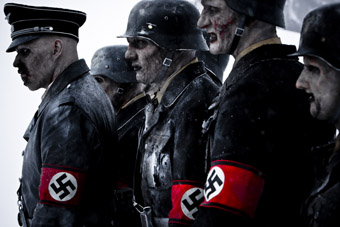
Dead Snow
AS ALWAYS, THIS YEARS’ REVELATION PERTH INTERNATIONAL FILM FESTIVAL HELPS REDEFINE THE CUTTING EDGE WITH A MIX OF BOLD, INFORMATIVE AND EXOTIC FARE. IN A PROGRAM PACKED WITH CHALLENGES AND SURPRISES, IT’S HARD TO SINGLE OUT A FEW FOR ATTENTION. NONETHELESS, IN A MEDIA-SATURATED WORLD, TODAY’S FESTIVAL-GOER CAN OFTEN USE ALL THE ADVICE THEY CAN GET, SO HERE ARE MY PICKS FROM A VERY TEMPTING PROGRAM.
Programmer Jack Sargeant’s expertise in underground culture and his affinity for outsiders and freaks is evident in the programming of NYC Foetus, the 2005 documentary about little-known post-punk legend JG Thirwell. Thirwell is way more interesting than some perhaps overexposed figures, though with the success of the fabulously neurotic Adult Swim cartoon Venture Bros, for which he’s been providing soundtracks, Thirwell is acquiring a new generation of hip young fans. Often regarded as the stereotypical ‘difficult’ artist, in NYC Foetus, Thirwell’s personality doesn’t grate at all; he comes across as thoughtful, complex and, prodigiously—almost scarily—talented. Director Clement Tuffreau has woven together reflective interview material with some of the New York underground’s key figures, shedding light not just on the artist but on the immensely creative post-punk/no-wave period as a whole. Music fans already familiar with this narrative will revel in the film’s loving incorporation of never before seen archival footage of Thirwell’s various incarnations as Foetus, Steroid Maximus and Manorexia as well as the liberal doses of his distinctive sound.
A very different music documentary unfolds over Soul Power’s 93 minutes. Crafted from the ‘outtakes’ of the 1973 documentary When We Were Kings which documented the infamous prize fight between Muhammad Ali and George Foreman, Soul Power charts the staging of the legendary black soul music festival in Kinshasa known as Zaire ‘74. This doco shows how that event achieved almost mythological status as the defining moment of 20th century African-American music: that amazing mid-70s Black Power moment of ‘the brotherman in the motherland’ is captured in all its glory here. The way the film’s extensive verité footage (apparently edited down from a mammoth 125 hours) cuts between the magic on stage and the chaos backstage reminded me of Gimme Shelter—unsurprising when you realise that one of the key cinematographers was the celebrated Albert Maysles. You don’t have to be a fan of soul—James Brown’s funkadelic finery and pure 1970s porno moustache is worth the price of entry alone.
Two other contemporary documentaries stand out: We Are Wizards and Saint Death. We Are Wizards follows the craze known as Pottermania—but if you think this is a standard fan-boy type of account, think again, because the film’s real story has less to do with the bespectacled boy-wizard Harry Potter than with the enormous corporate might marshalled against the actions of young acolytes. Big corporations disgracing themselves with wrong-headed and heavy-handed reprisals against the people who make their merchandise relevant is nothing new, but stories of young fans standing up to corporate lawyers still are. Personally, I find good documentaries on fan culture dangerously seductive—someone else’s obsession, told well, can be contagious–and though this didn’t quite convert me to the cult of Harry Potter it did endear me to his gutsy little fans. Those interested in contemporary cultural and legal machinations of intellectual property and copyfighting need to see this film.
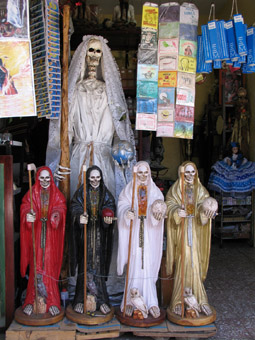
Santa Muerte
Another cult with a growing legion of fans is the Mexican cult known as Saint Death, represented as a skeleton in a wedding dress. Revelation is screening the utterly fascinating 2007 Mexican documentary Santa Muerte, narrated by Gael Garcia Bernal (of Motorcycle Diaries fame), which explores how this surprisingly recent phenomenon has arisen, and how its devotees continue to multiply. Despite the condemnation of the Catholic Church, which won’t recognise the ‘death saint’, increasing numbers of Mexicans, it seems, are making offerings for love and luck at the flourishing portable shrines and ad hoc altars springing up in her honour around the country. With Mexico often in the news for the wrong reasons, this documentary by the indefatigable activist filmmaker Eva S Aridjis proves incredibly illuminating as to how the oddly charismatic figure of Santa Muerte fulfils a particular need in the Mexican people.
The merging of traditional and contemporary beliefs characterises the 2007 animation, Sita Sings the Blues. Remarkable Indian-Canadian artist Nina Paley wrote, directed and almost entirely animated this dazzling feature-length extravaganza. Brisbane International Film Festival audiences last year adored this film’s slightly manic form, which interweaves events from the Hindu legend of the Ramayana, a conversation between Indian shadow puppets, musical interludes with sultry blues numbers by Annette Hanshaw and raw, emotional scenes from the artist’s own life. The bizarre parallels the film draws out between the ancient mythological tale and the contemporary biographical story create a free-wheeling atmosphere reinforced by the virtuosic display of different 2D animation styles.
Two recent Nordic releases programmed at Revelation show the breadth of contemporary cinema in Scandinavia. The quirky 2009 indie film Original, about a hapless rube named Henry, is notable for its innovative use of the ready-made sets at a well-known budget furniture chain, and the stunning rockabilly turn of Tuva Novotny playing Henry’s eye-gougingly decorative love interest. No less visually engaging, but coming from a distinctly different generic place is the Norwegian feature Død Snø (Dead Snow), whose noteworthy cinematography is the work of Bond University graduate Matthew Weston. When we see a group of medical students embark on a skiing holiday at a remote shack in the woods, we know immediately that we’re in for a ‘vacation gone wrong’ flick—but the film’s twist can be summed up in four words: vengeance-seeking Nazi zombies. Død Snø is a film that knows its audience and gives them what they want: humour, titillation and bravery from sexy leads, and lovingly detailed flesh-eating from the undead.
Where Død Snø provides a frosty glimpse of Norwegian (and Finnish) alpine wonderlands, another Revelation film offers cinema-goers a trip to the jungle. The remote Amazonian setting of A Festa da Menina Morta (The Dead Girl’s Feast) is rare even in international film festivals. This often brutal Brazilian feature, about a young mystic channelling the spirit of a dead girl, has divided critics, some of whom have criticised its inclusion of ‘indie Latin’ hallmarks, such as animal bloodletting. Considering this is well contextualised as within the santeria tradition which powers the film, the animal cruelty scenes seemed less disturbing than some of its other confronting fare. While it won’t work for those with delicate sensibilities, there is much to like in this non-family-friendly film beside the eye-opening Amazon imagery and soundtrack, including the film’s unconventional approach to cinematography, which slips between shaky, observational documentary style in the wide shots to beautifully composed close shots.
The Brazilian rainforest may be the only gorgeous, exotic location which does not feature in The Fall. Made largely with director Tarsam Singh’s own funds in 2006 and released last year, The Fall is an adventure-fantasy which unfolds around the story told by an injured stuntman to a little girl he befriends in hospital. While others will swoon over the glorious costuming and dynamically choreographed action (as you’d expect from a director better known for video clips), it’s impossible not to fall for the headspinning range of locations—the Czech Republic, Sumatra, Fiji, Bali, The Dead Vlei claypan in Namibia, as well as some of the most extraordinary Indian locations—the labyrinth Jantar Mantar in Jaipur, the Andaman Islands, Pangong Lake in Ladakh, the ‘Blue City’ of Jodhpur in Rajastan. The lush weirdness of this film typifies Revelation’s reputation for imaginative and risky programming, as well as the willingness of Perth audiences to embrace this film festival.
Revelation Perth International Film Festival, Perth, July 2-12, www.revelationfilmfest.org
RealTime issue #91 June-July 2009 pg. 25
© Danni Zuvela; for permission to reproduce apply to realtime@realtimearts.net
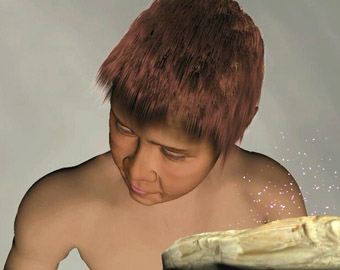
The Boy Who Had the Magic Word and the Whispering Moth
AUSTRALIA AND CANADA WERE ESTABLISHED AS COLONIES WHOSE FOUNDING FORCIBLY OCCUPIED TERRITORIES THAT HAD BELONGED TO ABORIGINAL PEOPLES FOR THOUSANDS OF YEARS (40,000 IN THE CASE OF AUSTRALIA AND 12,000 IN CANADA). BOTH INDIGENOUS CULTURES SHARE A MUTUAL SPIRITUAL UNDERSTANDING OF TOTEMIC CONNECTIONS AND COLLECTIVE CONSCIOUSNESS, AS WELL AS BEING THE ONLY TWO FIRST NATION PEOPLES TO REFER TO THEMSELVES AS ABORIGINAL. THROUGH THE LENS OF ANIMATION, BIG EYE: ABORIGINAL ANIMATION FROM AUSTRALIA AND CANADA EXPLORES THE MANY SIGNIFICANT CORRESPONDENCES BETWEEN THE FIRST NATIONS PEOPLES OF THESE TWO COUNTRIES.
Curators Jenny Fraser and Lubi Thomas, together with assistant curators Rennae Hopkins and Maggie McDade, have produced a resonant and imaginative study of recent creative work by Aboriginal artists and filmmakers from Australia and Canada. Staged over an array of screens throughout QUT’s versatile multimedia space, The Block, the show is more than a survey. It also included a popular interactive component, where participants create short moving animations in Flash in a permanently set up drop-in lab. Crucially, the curators’ thoughtful selections and presentation establish an international, interdisciplinary dialogue between Australian and Canadian animation.
Animation is naturally a hybrid medium, as Big Eye’s inclusion of claymation, CGI and machinima, and traditional line-drawn 2D styles shows. However, the focus on this stubbornly heterogeneous field carries a political charge as well. In Australia, unlike Canada, creative work in the moving image is conspicuously canalised into the very different worlds of filmmaking and (new) media arts. As self-described ‘digital native’ Jenny Fraser notes in the exhibition’s floornotes, “(a)pparently the two entities shall never meet, and sadly the Aboriginal sub-sections of those industries have followed suit. However, in other countries, like Canada, the arts world is bighearted enough to embrace and support both, simultaneously. On a curatorial level, animation was chosen as a screen-based genre that crosses that divide with ease, along with the other divides, like age, education and socio-economic status.”
Border-crossing is addressed in Australian Aboriginal artist Aroha Groves’ use of Second Life in her work, What is a Blakfulla doing in a virtual realm? Her sexy, pistol-wielding machinima transcends the limitations imposed by time and place in the creation of a provocative online Aboriginal character. Fusing contemporary and historical pop cultural motifs with hints of menace tempered with absurdism, Groves’ work clearly delights in the potential for experiment and play with identity afforded by art-making in the digital realm. This work, like Canadian Skawennati Tricia Fragnito’s TimetravellerTM (2008), employs digital animation tools to question the role of representation in the fantasy of online personae and suggests some emancipatory possibilities of cyberspace for Aboriginal people.
The limitless worlds of plasticine animation are explored in Orphan Boy (2004) by the Gunbalanya Community and Gozer Media, from Western Arnhem Land. This communally-authored piece, together with sister story The Echidna and the Turtle (2003), makes expressive and dynamic use of plasticine to relate key dreaming stories. Orphan Boy’s carefully composed soundscape contrasts with the deliberately rough-hewn visuals, just as the sticky, fingerprinted faces are complemented by brilliant cobalt and magenta sparkles signalling the Rainbow Serpent’s magic. The boldness of the forms and dramatic flair with which this dreaming is related are engrossing—the film completely captured this spectator. While the Canadian claymation counterpart, Dennis and Melanie Jackson’s Wapos Bay Series (2009), utilises a much more ‘licked finish’ to depict the life of a fictitious community in northern Saskatchewan, its primary appeal is also the charming way in which the clay characters, sets and mise-en-scene are engagingly deployed to narrate important cultural stories.
Similarly, both the wonderful Australian The Dreaming Series (the second edition of which aired recently on SBS) and the Canadian Raven Tales Series featured in Big Eye revolve around narrating key stories in serial form. Jenny Fraser describes these as “examples of Creation Stories from an animist perspective in action. Generally animals are a great mirror for our own behaviours. This is in reflection of the true essence of our identity. Everything else comes after the beginning…”
For all these similarities, there are some key differences between the nurturing of contemporary Australian and Canadian Aboriginal animations. The most notable of these is put perfectly by Fraser when she notes that, before Canada’s official Apology to its own Stolen Generation, the Canadian Government “had handed over $350 million compensation to Residential School Abuse sufferers and this was invested into culturally significant intitiatives, such as talking circles, language revitalisation and digital storytelling projects.” Amidst all the discussions about intergenerational trauma and the reconciliation process, the suggestion here for a similarly proactive, positive, generative response at the Australian national level seems like excellent advice.
Big Eye’s suite of films is the richer for the inclusion of key recent works like The Boy Who Had the Magic Word and the Whispering Moth (writer John Graham, animators Rebekah Pitt, Christine Peacock, 2005).This film is a contemporary myth, or re-Dreaming, which works to reinforce existing ideas—about secret words and sacred knowledge—by connecting ancient storytelling traditions with contemporary animation and literary practice. Boy and Moth’s simultaneous sense of time past and present is emblematic of the approach in Big Eye overall which, according to Jenny Fraser, is about striving “to honour the past as our teacher, honour the present as our creation, and honour the future as our inspiration… this is ‘Dreaming’ in action.”
Big Eye: Aboriginal Animation from Australia and Canada, curators Jenny Fraser, Lubi Thomas, assistant curators Rennae Hopkins, Maggie McDade, artists Jenny Fraser, Aroha Groves, The Gunbalanya Community & Gozer Media
Frank McLeod & Aboriginal Nations, Christine Peacock, Rebekah Pitt & John Graham; from Canada: Dark Thunder Productions, Raven Tales, Skawennati Tricia Fragnito, Rabbit and Bear Paws, The Healthy Aboriginal Network; QUT The Block, April 28-May 15
RealTime issue #91 June-July 2009 pg. 26
© Danni Zuvela; for permission to reproduce apply to realtime@realtimearts.net
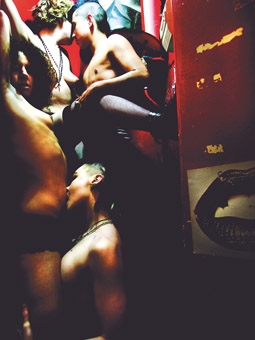
One Night Stand
THE INAUGURAL PERV FILM FESTIVAL, HELD AT THE NEWLY POPE (PLACE OF PUBLIC ENTERTAINMENT) LICENSED RED RATTLER “CREATIVE PLAYGROUND” IN SYDNEY’S MARRICKVILLE, SHOWCASED CUTTING EDGE, INFLUENTIAL QUEER EROTICA REVEALING A RANGE OF SEXUAL PRACTICES AS DIVERSE AS THE QUEER COMMUNITY ITSELF. ASSUMPTIONS THAT CAST THOSE IN SEXUAL MINORITIES AS ‘PERVERTS’ ARE TOSSED ASIDE AND UNDERMINED BY THE PERV PROGRAM AS AUDIENCES FACE THE REALISATION THAT THERE REALLY IS NO NORMATIVE APPROACH TO SEXUALITY AND DESIRE. INSTEAD, THE THRUST OF PERV IS INCLUSIVE, CELEBRATING DIVERSITY AND DIFFERENCE.
The festival was programmed with a refreshingly international scope shown in the inclusion of work from American and European filmmakers, but also provided by the keynote of festival guest, New York filmmaker Katrina del Mar, who presented a retrospective of her short films and music videos.
Del Mar subtly suggested that we don’t search for too much meaning in her work: “Just because”, she reasons when introducing Punchin and Cussin, a rock-video style clip in which tough looking girls box, play drums and swear in many languages. It’s fun, driven by the sheer revelry of girls doing things that girls aren’t supposed to, with a punk F-you attitude.
The cult Gang Girl films are the main attraction in del Mar’s retrospective. In Gang Girls 2000, fictionalised New York girl gangs—The Sluts, Ponies, Glitter Girls and The Blades—pick allegiances when a dispute over a run-over push-bike and a kidnapped pug dog escalates into all out gang warfare. In the Q&A that followed someone asked del Mar about the violence between women in her films. She shrugged, “It’s just things that I think about.” Surf Gang, the next instalment, also offers lashings of violence, but this time more nihilistically, the girls filling a void in their lives with senseless brutality. There are some stunning shots of the iconic New York Rockaway Beach while a Ramones song about the same beach plays. Shots of real surfing cutting away to the girls doing Gidget style ‘blue-screen surfing’ drew knowing chuckles from the audience.
In the Q&A, one bold viewer actually suggested that del Mar should work a bit more on script development. This prompted the filmmaker to talk about the often ad hoc way that her films come together. “I once found these girls in a gas station”, she recalls, “and just asked them, do you want to be in a film?” Of the plot holes in Surf Gang, del Mar says that some people had to go home and the rest had to keep working, so they just “made up an ending.” The underlying DIY-ness of her work sees del Mar unpretentiously assume the voice of a subversive culture, while the use of Super 8mm film lends a warm, nostalgic quality to her fusions of punk-rock iconography and girl on girl fantasy.
The relationship between sexual performance and real sexual conduct is brought into question in One Night Stand/Pour Une Nuit (France, 2006). In making this gritty ‘dyke and trans’ porno, director Emilie Jouvet solicited performers from Paris’ queer community to basically do what they wanted, and in this sense the film approaches sex as it ‘really is.’ Players met and discussed their desires and fantasies, and then were left to play out the intimate scenes ‘naturally’ in front of the cameras. Interviews with the actors shown before the film reveal a sense of collaboration and their involvement with issues raised in One Night Stand.
One actor suggests that “sexuality shouldn’t be dramatised, it should be experienced.” Another talks about the film depicting “the reality” of their “trans body.” The result is something revolutionary, at least when viewed in terms of conventional pornography. The diverse collection of encounters plays out in almost real time, with editing kept to a minimum. There are no staged ‘money’ shots, and the audience is left to cope occasionally with a few seconds of awkward camera adjustment rather than have scenes interrupted. This certainly leads to a voyeuristic feel, as if we are being let in to a world that exists whether we watch it or not. It’s hot too—the players are confident in their own bodies and in sexual interactions. They are free to explore and certainly without the appalling or coercive conditions for which the mainstream porn industry has been criticised. Artifice occasionally asserts itself in the attempts at romantic narrative and, ultimately, in the knowledge that this is, after all, a performance for the camera. Yet, in making the so-called ‘private’ public, One Night Stand moves away from contrived representation, encouraging us to stand back and appreciate unique sexualities without taboo.
The final session of Perv was given over to its short film competition. The 10 finalists constituted a promising mix of local and international up-and-coming filmmakers working loosely in the queer erotic genre. This was a site for experimental erotica, shown in films such as Kym Farman’s pastoral Devil’s Dairy Maid (US, 2008)—a black and white silent film that sexualised the churning of butter. Was this a comment on women’s domestic work, the historic repression of women’s sexuality or the vilification of women as witches? Or it could have simply been echoing del Mar’s “just because.” Catherine Corringer’s This is the Girl (France, 2007) was another experimental piece involving a disjunctive series or images featuring a female boxer, an ambiguous coach/doctor, and a man who is a sex toy. Worth a mention is Tory Blow’s giggle-rousing Hole in the Wall (Australia, 2008)—a two-minute sequence in which a gender ambiguous ‘glory hole’ moves unpredictably of its own accord.
The judges’ award went to Virginia Barratt for Boy Inchoate (Australia, 2008), a whimsical documentary-style film that looked at the beginnings of transing from female to male through the lens of the filmmaker’s relationship with the transer. The film succinctly and cohesively fused domestic snapshots, interviews and wordplay. The Audience Choice awards also went to locals, tied between Tonnette Stanford’s queer Bold and the Beautiful parody, The Vicious and the Delicious (Australia, 2008), and True L.O.V.E (Australia, 2009) directed by Jackson Badger, in which a split screen is used to show a gender ambiguous ‘boy’ and a forceful ‘daddy’ playing out a slave and master fantasy. I’d like to add to this a commendation to the Perv organisers for giving a platform to these works where perhaps there wasn’t one, and for getting this exciting and thought-provoking event up and running.
Perv Film Festival, Red Rattler, April 23-26, Marrickville, Sydney, www.pervfilmfestival.org; www.redrattler.org
RealTime issue #91 June-July 2009 pg. 27
© Megan Garrett-Jones; for permission to reproduce apply to realtime@realtimearts.net
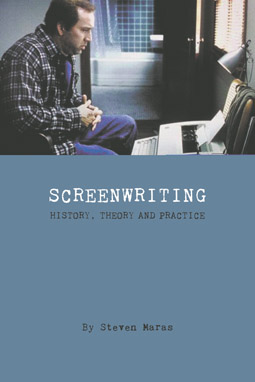 ROBERT MCKEE IS IN AUSTRALIA THIS MONTH, ON THE ROAD WITH HIS ALWAYS WELL-ATTENDED SEMINAR SERIES, PASSING DOWN FROM ON HIGH THE SO-CALLED PRINCIPLES OF THE WELL-WRITTEN SCREENPLAY. WHEN IT COMES TO CLASSICAL, WHITE BREAD STORYTELLING, MCKEE DOES INDEED KNOW HIS STUFF. BUT TO SAY THAT HE’S PASSING IT DOWN FROM ON HIGH IS NOT SO FAR FROM THE TRUTH.
ROBERT MCKEE IS IN AUSTRALIA THIS MONTH, ON THE ROAD WITH HIS ALWAYS WELL-ATTENDED SEMINAR SERIES, PASSING DOWN FROM ON HIGH THE SO-CALLED PRINCIPLES OF THE WELL-WRITTEN SCREENPLAY. WHEN IT COMES TO CLASSICAL, WHITE BREAD STORYTELLING, MCKEE DOES INDEED KNOW HIS STUFF. BUT TO SAY THAT HE’S PASSING IT DOWN FROM ON HIGH IS NOT SO FAR FROM THE TRUTH.
Certainly, that is the way that McKee himself, along with fellow screenwriting gurus Syd Field and Christopher Vogler, tend to think about concepts such as three-act structure and central conflict theory: as theological tenets to be taken on faith, commandments chiselled in stone. When McKee touts himself on his website as “the world authority on Writing”, complete with a capital “W”, he is talking about writing as though it were some kind of Platonic absolute and his take on it the One True Way to enlightenment and a three-film studio deal. As Charlie Kaufman says to his brother Donald, a McKee devotee, in Adaptation, “You sound like you’re in a cult.”
It is perhaps no surprise that Kaufman, in the doughy form of Nicolas Cage, appears on the cover of Screenwriting: History, Theory and Practice, a new book by University of Sydney academic Steven Maras. Like Kaufman, Maras is highly sceptical of this strand of extreme fundamentalism in screenwriting, as he is of anyone who talks about the modern screenplay as though it were an ahistorical phenomenon. For Maras, such claims are not only historically incorrect, but loaded with political and strategic intent as well.
A much-debated form of writing, at once both technical and poetic in function, the screenplay is not something that emerged fully formed at the dawn of cinema’s sound era. Nor is it the teleological endpoint of an evolution in screenwriting practice, a view that implicitly considers photoplays, continuity scripts and scenarios lesser forms of writing struggling to become screenplays. For Maras, the contemporary notion of screenwriting and the centrality of the modern screenplay form to the studio system and film financing have both emerged, to a large extent, out of language. They are the spoils of a battle fought in the pages of industry magazines and photoplay handbooks, theoretical tracts and studio records—not to mention in the pages of the modern screenwriting bibles—to construct the figure of the screenwriter as a creative professional and the author of a film, while installing his work, the screenplay, at the centre of the filmmaking process.
In Screenwriting, Maras sets himself the task of sketching out the borders of this battle, seeking to show how certain key ideas about screenwriting and the screenplay, far from being the eternal truths they are so often sold as, came to be normalised and institutionalised over many decades. Drawing on a meticulously researched range of sources from the 1910s to today, Maras does this through in-depth analysis of screenwriting discourse. He gives space to so many competing voices—critics, theorists, screenwriters and filmmakers—that the result is often cacophonous in its completism.
The book is not a chronological history, but a logically structured argument. From questions about the screenplay’s literary status and how we might approach the form as readers, the book proceeds to wrestle with long-entrenched ideas about the screenplay as a blueprint for production and the notion of what it means to write for the screen. There is also a chapter on auteur theory and its antagonistic relationship with screenwriting, a brilliantly executed argument suggesting that both auteurist and screenwriting discourses alike developed in response to Hollywood’s assembly line mentality, which separated writing from production, conception from execution, leaving everyone on either side feeling the need to assert their creative centrality.
By pulling the seemingly transcendental form of the screenplay back to earth and its historical context, Maras implicitly begins to open up a space in which other forms and practices of writing might be possible. Such alternatives are hinted at in the book’s opening pages, where another type of ‘screen writing’—that with the all-important space between the words—is first introduced. For the most part, this concept then disappears into the background of Maras’s discussion, which is by its own admission primarily concerned with the discursive roots of our more dominant ideas about screenwriting. But the two-word version, screen writing, re-emerges in the book’s conclusion, challenging us to think beyond normative standards. It is well worth the wait.
This is the screen writing of Alexandre Astruc’s caméra-stylo and Agnès Varda’s cinécriture, a writing, not merely for the screen, but on or with it. It is a writing less reliant on language than it is on the material of cinema, on images and sounds arranged in time. While some screenwriters might well argue that this is a loose, auteur-centric definition of writing, Maras suggests, in my view correctly, that by expanding that definition outwards to take in other forms of what he calls “scripting”, we are opening up a greater field of possibilities for the creation of cinema itself. (While Maras’s use of the word “scripting” occasionally seems somewhat redundant, identical in meaning to the rather more appealing “screen writing”, one appreciates not having to double-check every mention in the book of its title for either the compound or two-word construction.)
Maras’s conclusion thus points in new directions, both for the study of screenwriting and, perhaps more importantly, the practice itself. These new directions seem particularly relevant here in our Australian context, where normative standards of story and screenplay have become so central to the funding equation and cinematic ideas so marginal. While Robert McKee claims that an emphasis on story will help writers avoid so-called development hell, in the creative centres of this country an over-emphasis on story—or at least, an under-emphasis on cinema—has in fact become a circle of that hell. Speaking at the Brisbane International Film Festival in 2005, Adrian Martin summed up the situation succinctly. “To wait eight years between projects only to go into development hell refining the script is a very bad trend in Australian cinema”, he said. “Everything gets loaded, gets invested, in the script. Scripts, of course, are very important, though they’re not necessarily the most important thing in a movie. What’s important in a movie is the movie. It’s the cinema.”
In the end, this is what Maras’s book is really about. An important and long-overdue contribution to the historiography of screenwriting, it is also something more than that, as the very best criticism and scholarship always is. In attempting to broaden the horizons of screenwriting, Steven Maras also broadens those of the cinema. As Charlie Kaufman thinks to himself in the final moments of Adaptation: “Who cares what McKee thinks? This feels right.”
Steven Maras, Screenwriting: History, Theory and Practice, Wallflower Press, London, 2009, 256 pages, 978-1-905674-81-7
RealTime issue #91 June-July 2009 pg. 28
© Oscar Michaels; for permission to reproduce apply to realtime@realtimearts.net
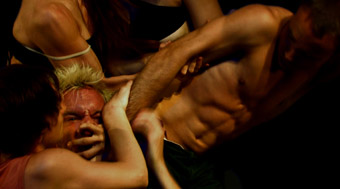
Raft of Medusa
MOVES09’S NARRATIVE-THEMED PROGRAM PROVED TO BE A CHARACTERISTICALLY DYNAMIC FINAL FLOURISH FOR OUTGOING DIRECTOR PASCALE MOYSE. IN ADDITION TO THE FESTIVAL’S DISTINCTIVE MIX OF SCREENDANCE AND MOVING IMAGE, MOYSE HANDS ON AN ENVIABLE LEGACY OF ESTABLISHED FUNDING AND SUBSTANTIAL AUDIENCE GOODWILL TO CURRENT MANAGER GALA PUJOL.
During her three year tenure, Moyse steered the Manchester-based event into a new homebase at the city’s arthouse cinema, in addition to working partnerships with a range of regional, national and international organisations, this year including Northwest-based Comma Pres, Sadler’s Wells in London (home of the curatorially innovative dance/film series Live Screen) and a globe-spanning network of screendance sister festivals.
For 2009, an ongoing commitment to non-traditional, city-wide access points variously included Shelly Love’s newly commissioned exploration of historical portraiture, created for public screen viewing; downloadable podcasts and mobile phone content and Eloi Maduell’s kaleidoscopically interactive pLayModes installation at the Lowry. An additional gallery-set program featured Lutz Gregor’s Raft of Medusa (2008), a contemporary reinterpretation of the Géricault painting. Sergei Eisenstein made reference to “the eye taking a walk” within the process of graphic composition. Gregor’s use of high definition, chiaroscuro-lit, ultra-slow motion leads the viewing eye at leisure along sightlines created between subtly shifting figural groupings.
Maya Deren famously exhorted filmmakers to avoid “trying to invent a plot that moves” and instead to “use the movement of wind, or water…as a poem might celebrate these.” Hilary Goodall’s adjacently sited floor and ceiling projections Earthmoves 1+2 (2008), thus threaded together naturally occurring movement patterns of English summer, as traceries of twigs and branches, surface water currents, and profusion of blossom sat amid viewing friendly deckchairs, picnic hamper and daisy speckled astroturf.
A series of discussion forums at the Cornerhouse Cinema opened with recent work from established British artists Alex Reuben and Becky Edmunds, created during respective residencies in Brazil and Swedish Lapland, with both exploring non-linear narrative forms. Later, Ian Patterson’s speculation on the narrative potential of virtual environments and Paolo Cirio on the genre of recombinant fiction—meshing factually based content with conventions imported from gaming and the blogosphere—represented the festival’s continued slant towards new media-influenced input.
A specially curated, afternoon set edition of Brighton-based South East Dance Agency’s Dance For Camera Nights featured current agency fellowship recipient Lucy Cash enlisting her audience in an improvised Q&A for a collectively imagined film project. She then outlined her own creative approach as the parallel multi-branchings of “quantum storytelling.” A one-day version of the highly influential Open Source Video Dance Forum, led by Simon Fildes at the festival’s end, catalysed grassroots-upwards dialogue, drawing together such historically disparate approaches to movement and narrativity as Maya Deren’s theory of vertical progression and web 2.0 facilitation.
Festival debuts for innovative strands included Max Hatler and Noriko Okaku’s laptop-enabled live performance of intertwined electronic audio and fleeting, fragmented visuals, shown at The Green Room in association with Liverpool-based festival of alternative media, Abandon Normal Devices. A program curated by poetry publishers Comma Press screened within the airily atmospheric surroundings of the Cervantes Institute, showcasing an inventive marriage of non-linear narrative and visual collage, including Manchester-based filmmaker Kate Jessop’s subtle augmentation of Simon Armitage’s rhythmic cadences, On Miles Platting Station (2008), as slate-grey palette of archive commuter footage and red/amber/green rotation of isolated signal lights followed giant, yellow-centred daisies, gently sprouting between long disused sleepers.
From a newly introduced program for younger audiences, Charlotte Dolman’s highly accomplished What’s In Store (2008) created an appealingly anarchic, convincingly self-contained stop-motion world of self-willed cleaning products in broom cupboard hi-jinx. Julie Angel foregrounded the subjective experience of a young, male parkour practitioner in Feedback Loop (2008) as spatially disorienting, body-cam footage of feet and hands reached for slanted concrete, brick and metal, before alighting in a rectangular-framed oasis of green.
In the first of two historically relevant programming slots, a BFI selected cross section of Czeck filmmaker and animator Jan Svankmajer’s output spanned three post-war decades of surrealist influenced work, while Lotte Reiniger’s The Adventures of Prince Achmed, from 1926, set intricate, cursively stylised hand-cut paper silhouettes of heroes, princesses and hydra-headed creatures against vivid washes of background colour.
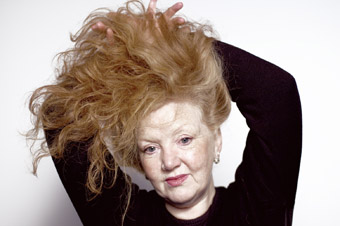
Requiem for the Redhead?
Alternative approaches to narrativity, threaded throughout individual programs and composed of what film editor Walter Murch has referred to as ‘unanticipated collisions’, included Marlene Millar and Philip Szporer’s carefully considered portrait of a dancer at mid-life, intercutting a close-in camera journey across freckled expanses of skin with blue-tinged blurring of coolly distanced movement states in 40 (2009). Lucy Cash’s playfully associative natural history, Requiem for the Redhead? (2008), allowed her the dual role of writer and director, combining voice-over strands of folk myth, urban slang and scientific data with fine rhythmic calibration of imagery, subverting the conventions of photographic portraiture in a fast-moving and visually inventive mug shot-style cascade of copper tops and strawberry blondes.
Aaron Epstein and Daniel Stedman’s The Moth and the Firefly (2008) provided a witty masterclass in narrative economy, offsetting insect movement trajectory against silent film style intertitles. Contrastingly, Jeff Chiba Stearn’s Yellow Sticky Notes (2007) achieved a virtuosic feat of autobiographical animation, mixing high profile world events—as jumping flour sacks and waving blades of grass shimmered, swirled and transformed into rabbit-eared twin towers and a water-spewing tsunami giant—with the ephemeral jottings of personal ‘to do’ lists scribbled on post-it pads. The title of second-time filmmaker Mark Jones’ delicately nuanced documentary, Taken By The Air (2008), reflected both the allure of weightless inversion and its ever present threat of fatality. Beginning with the rhythmic patterning of young feet on stone stairways, a sophisticated balance of photography, DV footage and voice-over contrasted arc lights and feathered costumes with metal harness clamps and nylon rope, as fragments of monologue, given new meaning by cumulative weighting of context, repeated at the film’s end.
A continuing festival focus on global partnership saw carte blanche extend across three continents, as Barcelona-based NU2’s programme of Spanish-made work, introduced by director Núria Font, opened with Aitor Echeverria’s rhythmically inventive linkage of isolated body parts in Aprop (2006), and included Isabel Rocamora’s characteristic measured pacing and studied painterly aesthetic, counterbalanced by a less evenly worked narrative thread, in Promise of Fallen TIme (2008).
A series of African-themed films, curated and presented for Moves by Jeannette Ginslov, featured Guy Spiller’s ethereal, hallucinatory graphics, illustrating the transformative properties of ancient firelit ritual in Trance Dance (2007), and the outsider perspective of Sergio Cruz’ colour and heat drenched fusion of Mozambican music-making, movement and run-down urban environment in Exotica (2009).
Completing the trilogy, a selection from Australia’s ReelDance archive included Madeleine Hetherton and Rowan Marchingo’s luminously photographed portrayal of triangular family tensions in Shadow Play (2007), while a second viewing of Gideon Obrazanek and Edwina Throsby’s deceptively easy-watch movement palette of finger-pointing, head-shaking and bum wiggles in Dance Like Your Old Man (2007)—previously screened in Britain as part of Brighton-based Dance for Camera programming—pinpointed subtle shifts into darker layers of emotional shading as narrated episodes of relationship breakdown within the complex father-daughter bond translate visually into unsettling slow motion and extreme close-up.
Dance filmmaker Douglas Rosenberg has commented on the often precarious positioning of fellow artists, stating that ‘dance itself is a marginal artform and certainly dance film and video makers must be considered on the margins of the margin.” Moves09 presented an appealing model of international networking and co-operation for artists, audiences and festivals, at a pivotal time for the artform’s development. As boundaries expand to include medium-specific composition, an international era of screendance 2.0 appears to be with us.
Moves09, Cornerhouse and other venues, Manchester, April 23-28
RealTime issue #91 June-July 2009 pg. 29
© Chirstinn Whyte; for permission to reproduce apply to realtime@realtimearts.net














































































 ROBERT MCKEE IS IN AUSTRALIA THIS MONTH, ON THE ROAD WITH HIS ALWAYS WELL-ATTENDED SEMINAR SERIES, PASSING DOWN FROM ON HIGH THE SO-CALLED PRINCIPLES OF THE WELL-WRITTEN SCREENPLAY. WHEN IT COMES TO CLASSICAL, WHITE BREAD STORYTELLING, MCKEE DOES INDEED KNOW HIS STUFF. BUT TO SAY THAT HE’S PASSING IT DOWN FROM ON HIGH IS NOT SO FAR FROM THE TRUTH.
ROBERT MCKEE IS IN AUSTRALIA THIS MONTH, ON THE ROAD WITH HIS ALWAYS WELL-ATTENDED SEMINAR SERIES, PASSING DOWN FROM ON HIGH THE SO-CALLED PRINCIPLES OF THE WELL-WRITTEN SCREENPLAY. WHEN IT COMES TO CLASSICAL, WHITE BREAD STORYTELLING, MCKEE DOES INDEED KNOW HIS STUFF. BUT TO SAY THAT HE’S PASSING IT DOWN FROM ON HIGH IS NOT SO FAR FROM THE TRUTH.


